This site uses affiliate links, meaning that if you make a purchase through our links, we may earn an affiliate commission.
Japan is a country that offers a unique blend of ancient traditions and modern innovation. From bustling cities to serene countryside, Japan has something to offer for every kind of traveler.
With a 16-day Japan itinerary, you will have enough time to experience the country’s rich culture, fascinating history, and breathtaking natural scenery.
In this blog post, we’ll take you on a journey through Japan and provide you with a detailed itinerary that covers some of the country’s most iconic destinations including Tokyo, Hakone, Kyoto, Hiroshima, Miyajima Island, Nara, Kanazawa, and Osaka.
So, pack your bags and get ready for an unforgettable adventure in Japan!
- 1. Map of 16-Day Japan Itinerary
- 2. DAY 1 - TOKYO
- 3. DAY 2 - TOKYO
- 4. DAY 3 - TOKYO
- 5. DAY 4 - DAY TRIP TO HAKONE FROM TOKYO
- 6. DAY 5 - DAY TRIP TO SEE SNOW MONKEYS (WINTER) OR DAY TRIP TO NIKKO (OTHER SEASONS) FROM TOKYO
- 7. DAY 6 - KYOTO
- 8. DAY 7 - KYOTO
- 9. DAY 8 - KYOTO
- 10. DAY 9 - KYOTO
- 11. DAY 10 - DAY TRIP TO KANAZAWA FROM KYOTO
- 12. DAY 11 - JAPANESE TEA CEREMONY AND TRIP TO NARA
- 13. DAY 12 - DAY TRIP TO MIYAJIMA AND HIROSHIMA FROM KYOTO
- 14. DAY 13 - OSAKA
- 15. DAY 14 - OSAKA
- 16. DAY 15 - DAY TRIP TO HIMEJI CASTLE FROM OSAKA
- 17. DAY 16 - DEPARTURE
- 18. Intrepid Scout's Tips for 16-Day Japan Itinerary
Map of 16-Day Japan Itinerary
DAY 1 - TOKYO
- Arrival in Tokyo
- Stay in Ginza: Settle into Your Accommodations
- Explore Ginza:
1. Check Out the Shopping and Dining Scene
- Get a Good Nights Rest
Arrival In Tokyo and How to Get Around in Tokyo
Day 1 marks the beginning of your adventure in Japan!
You’ll be arriving in Tokyo, the vibrant capital city that’s known for its futuristic skyscrapers, traditional temples, and bustling streets.
Tokyo is a city of contrasts, where you can see ancient shrines alongside modern high-rises, and traditional festivals alongside high-tech gadgets. It’s a city that never sleeps, where there’s always something new to see and experience.
On your first day in Tokyo, my recommendation is to settle into your accommodation, explore the neighborhood around your hotel, and sample some of the city’s delicious cuisine.
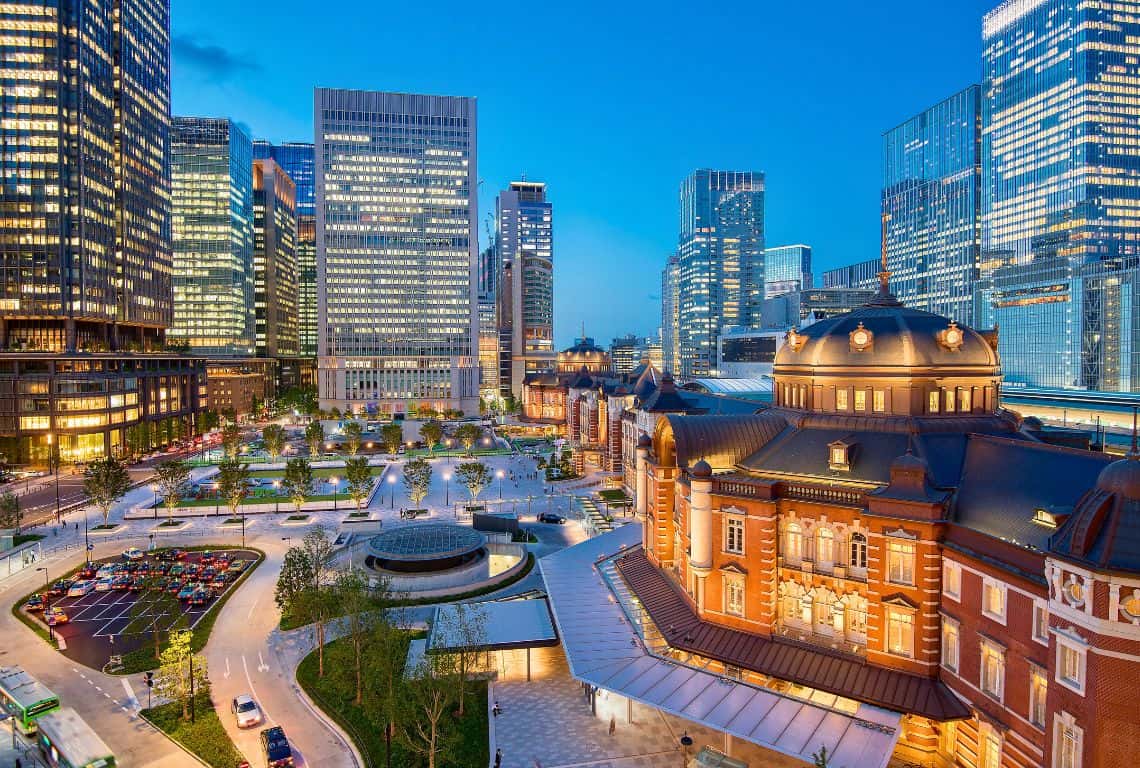
Tokyo Station / 16-Day Japan Itinerary
Before we dive in, here are a few tips on how to get around in Tokyo:
Tokyo has an extensive and efficient public transportation system that makes it easy to get around the city. Here are some common methods of transportation for navigating Tokyo:
- The Tokyo Metro and subway are a convenient and efficient way to travel within the city, with multiple lines covering different areas. Make sure to get rechargeable IC cards such as Suica or Pasmo, which offer discounted fares and can be used on multiple transportation systems.
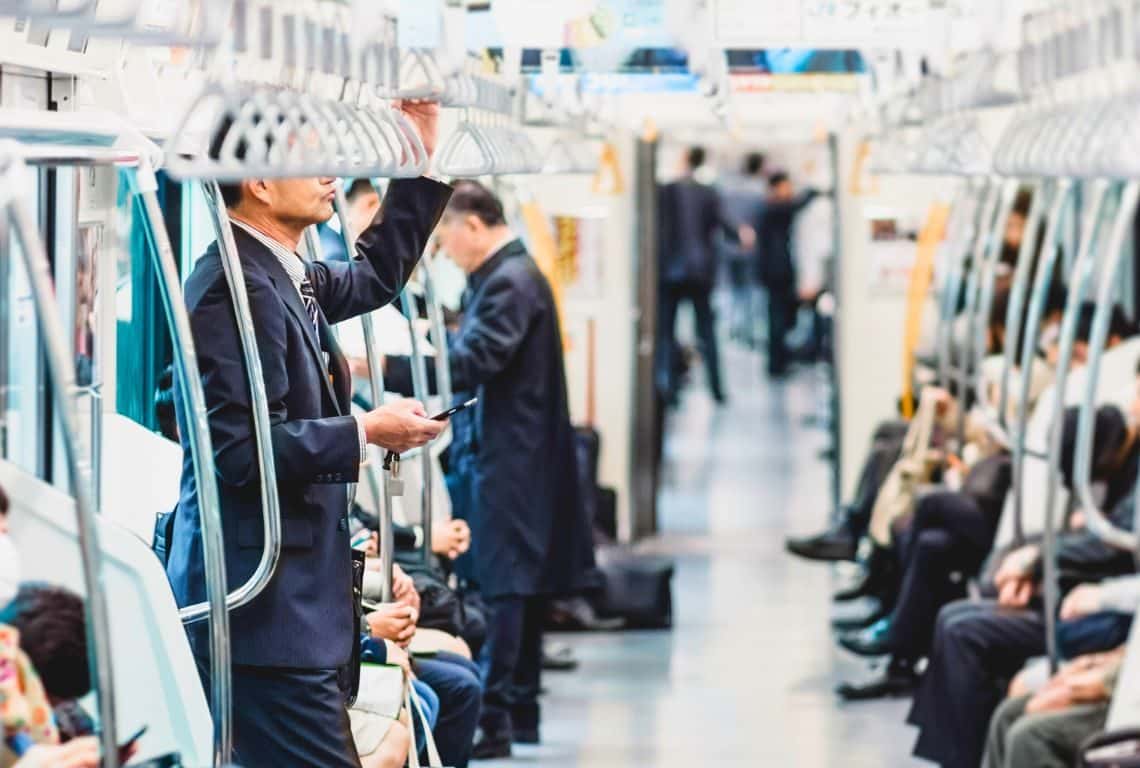
Tokyo Metro / 16-Day Japan Itinerary
- Japan Railways (JR) operates several lines in Tokyo, including the Yamanote Line, which is a loop line that circles central Tokyo and connects major neighborhoods.
- Buses are another option for getting around Tokyo, although they are not as easy to use as Tokyo Metro and subway, as well as JR.
- Taxis are widely available in Tokyo, but they can be more expensive compared to other forms of public transportation.
- Walking is a great way to explore Tokyo’s neighborhoods like Shibuya, Shinjuku, and Asakusa.
- Intrepid Scout’s Tip:
Make sure to buy JR Pass before going to Japan. It is a huge cost-saving tool. It allows unlimited use of most JR trains, including the Shinkansen (bullet trains), limited express trains, and local trains, for a set period of time (7, 14, or 21 days).
The JR Pass also includes some additional benefits, such as free seat reservations on most trains, which can be especially useful during peak travel times, and access to some JR buses and ferries. It also covers the Tokyo Monorail to/from Haneda Airport and the Narita Express to/from Narita Airport, which can be convenient for travelers arriving or departing from these airports.
Settle into Your Accommodations (Best Places to Stay in Tokyo)
My first choice is to always stay in Ginza. I like the fact that Ginza is located in the heart of Tokyo, making it easy to access other parts of the city via public transportation. It’s also a walkable area, with many of the shopping and dining destinations within walking distance of each other.
There are several hotels that I stayed at and really enjoyed. Check them out and see which one you like the best:
Muji Hotel Ginza – this is my first choice. The rooms are elegantly designed like all Muji products. The location is perfect near the JR Yamanote line. The in-room extras, all Muji branded, are great, with everything from the slippers to bags of Japanese sweets yours to take with you. The breakfast is lovely with healthy and high-quality food options.
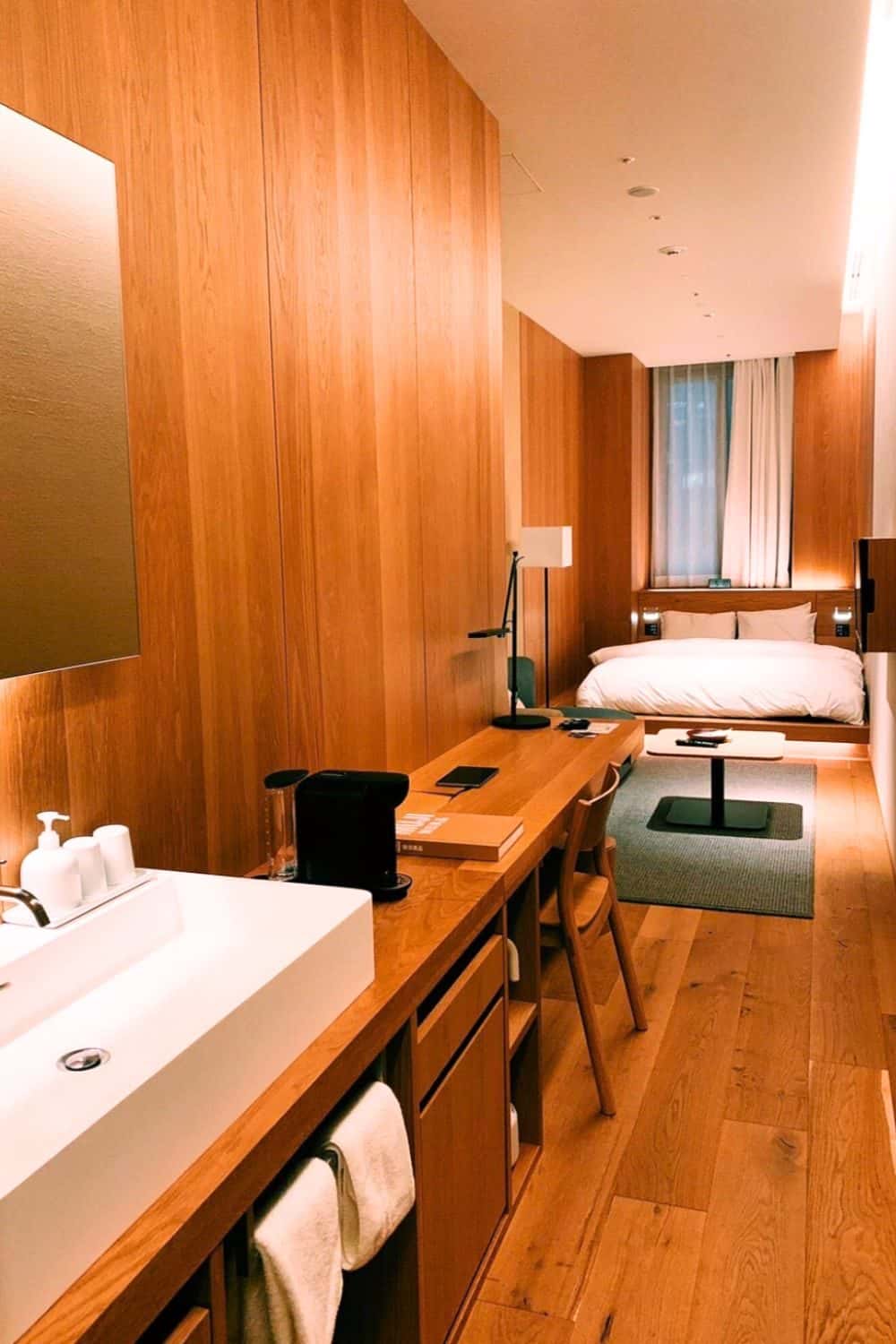
Muji Hotel Ginza / 16-Day Japan Itinerary
AC Hotel by Marriott Tokyo Ginza – it is a beautiful, modern, and well-maintained hotel right in the heart of Ginza. The rooms are a good size, which is unusual for Tokyo, nicely designed, and super clean.
Agora Tokyo Ginza – stylish and elegant hotel. The location is great close to train stations. Rooms are on the smaller side, however, they are very comfortable and clean. You will love the bathroom which is beautifully designed and huge in size.
After you check in to your hotel and maybe take a little nap to recover after a long flight, let’s explore Ginza’s lively atmosphere.
Explore Ginza: Checkout out the Shopping and Dining Scene
Ginza, located in the heart of Tokyo, is one of the city’s most popular shopping districts, with high-end boutiques, department stores, and luxury brand shops. It’s also home to some of the best restaurants and cafes in Tokyo, where you can sample delicious Japanese cuisine, from sushi and ramen to tempura and soba noodles.
Some of the must-visit shopping destinations in Ginza include the iconic Mitsukoshi Department Store, the luxury brand shops on Chuo-dori Street, and the Ginza Six shopping complex. For a more local shopping experience, visit the Kabukiza Theatre, which has a small shopping mall with traditional Japanese handicrafts.
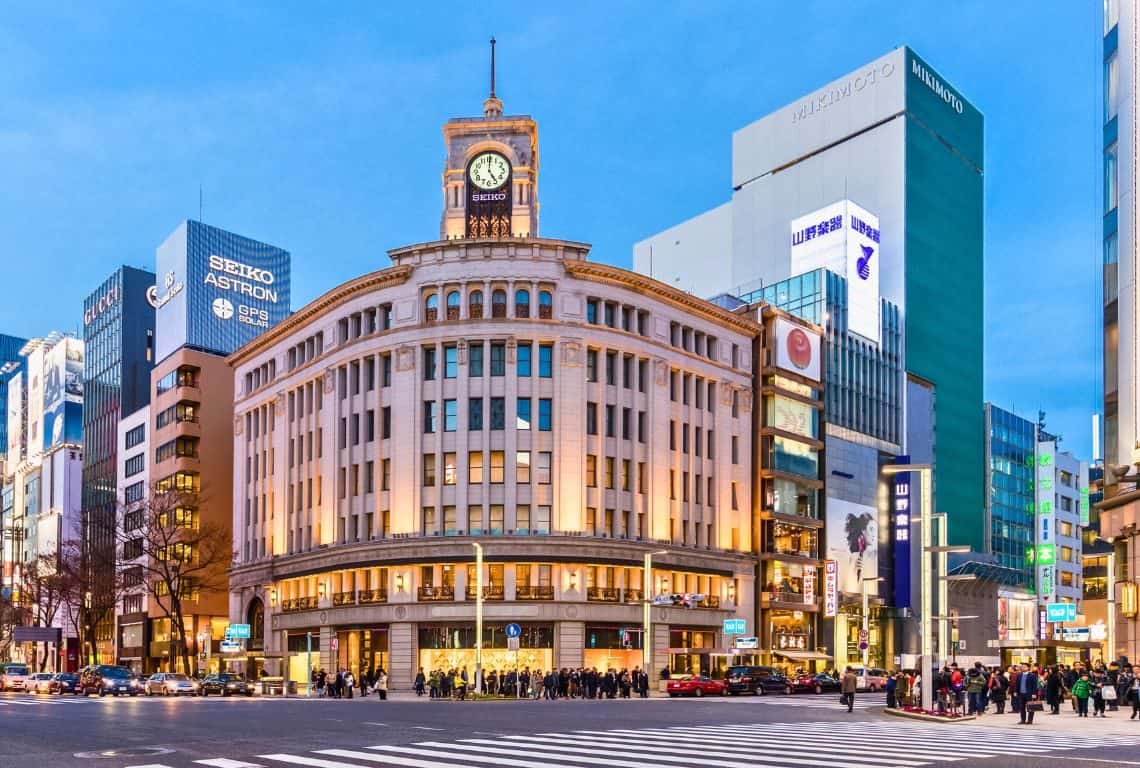
Ginza / 16-Day Japan Itinerary
When it comes to dining, Ginza has an abundance of options to choose from. Some popular restaurants include Kyubey for sushi, Ten-Ichi for tempura, and Ginza Kagari for ramen. For dessert, try the famous Japanese-style pancakes at Gram Cafe or indulge in some sweet treats at the Pierre Herme Paris boutique.
And to cap off your day in Ginza, head to IPPUDO for dinner. This famous ramen chain was founded in Fukuoka in 1985 and has since become one of the most popular ramen chains in Japan and beyond.
Their thin, yet firm, straight noodles are heavenly. They retain their bite even after being soaked in broth for some time. And, the broth is creamy yet not too heavy. If you are still hungry, then order Hakata Gyoza. They are crunchy, bite-size, crispy outside, and juicy inside, with the most delicious filling. Check out my post for location and more menu options.
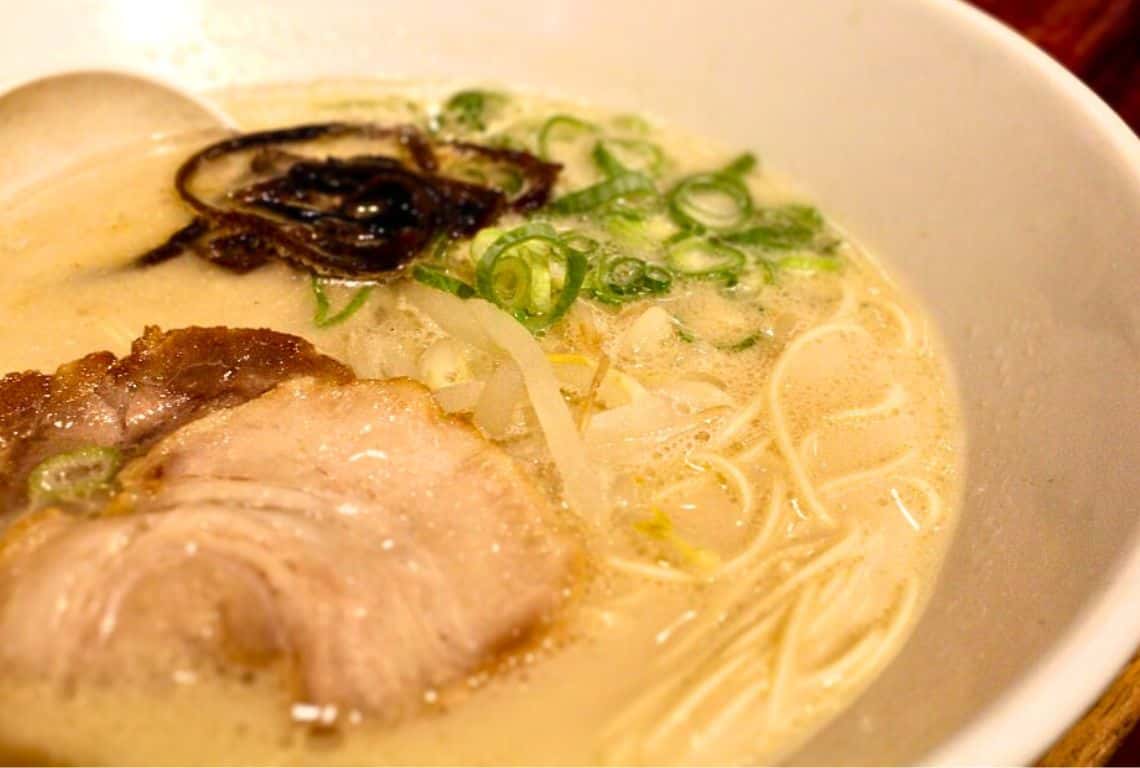
Ippudo in Ginza / 16-Day Japan Itinerary
DAY 2 - TOKYO
- Explore Tokyo
1. Shibuya Scramble and Hachiko Memorial Statue
2. Takeshita Street in Harajuku
3. Tokyo Metropolitan Government Building
4. Kabukicho District in Shinjuku
Experience Shibuya's Iconic Scramble Crossing and Say Hi to Hachiko
Shibuya Scramble Crossing is one of Tokyo’s most iconic and well-known spots!
The crossing is located just outside Shibuya Station, which is one of Tokyo’s busiest train stations and a hub for transportation to many parts of the city.
The crossing itself is a mesmerizing spectacle, with thousands of people crossing from all directions when the traffic lights turn red.
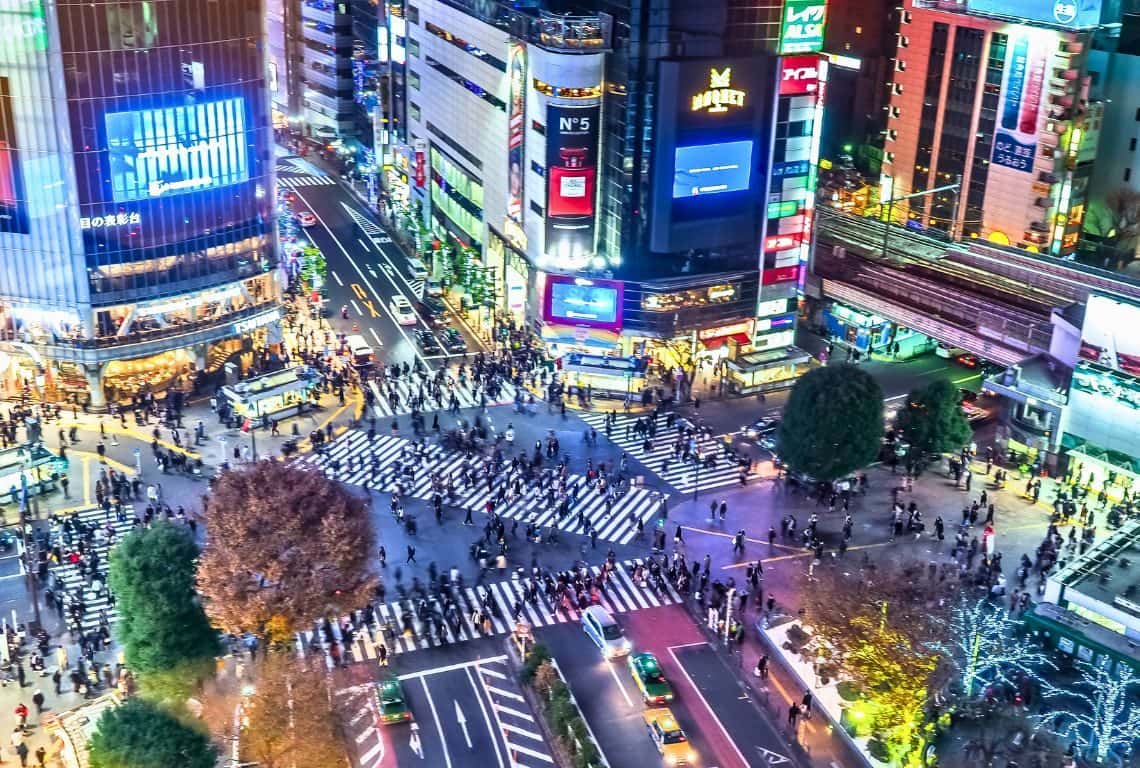
Shibuya Crossing / 16-Day Japan Itinerary
The sheer number of people can be overwhelming, but it’s also an incredible sight to see. Many visitors come to Shibuya Scramble Crossing just to take photos or to watch the crowds from one of the nearby cafes or observation decks.
Some of the best spots to see the Shibuya Scramble Crossing are:
- Starbucks Shibuya Tsutaya – Located on the second floor of the Tsutaya building, this Starbucks offers a bird’s eye view of the crossing from its floor-to-ceiling windows. It can get crowded, but it’s worth it for the view.
- Shibuya Crossing Observation Deck – This recently opened observation deck is located on the 17th floor of the Magnet by Shibuya 109 building and offers panoramic views of Shibuya, including the famous crossing.
- Shibuya Hikarie – This shopping and dining complex has a rooftop garden that offers great views of the city, including Shibuya Scramble Crossing.
Right next to Shibuya Station and near the famous Shibuya Scramble Crossing is Hachiko Memorial Statue.
It is a beloved landmark in Tokyo and a symbol of loyalty and devotion. The statue is dedicated to a faithful Akita dog named Hachiko.
In the 1920s, Hachiko would greet his owner at Shibuya Station every day when he returned from work. Even after his owner passed away, Hachiko continued to come to the station every day at the same time, waiting for his owner’s return.
The story of Hachiko’s unwavering loyalty touched the hearts of many, and a statue was erected in his honor in 1934.
Today, the Hachiko Memorial Statue is a popular meeting spot and a must-see attraction for visitors to Tokyo. The statue is especially popular with animal lovers and those who appreciate the story of Hachiko’s loyalty and devotion.
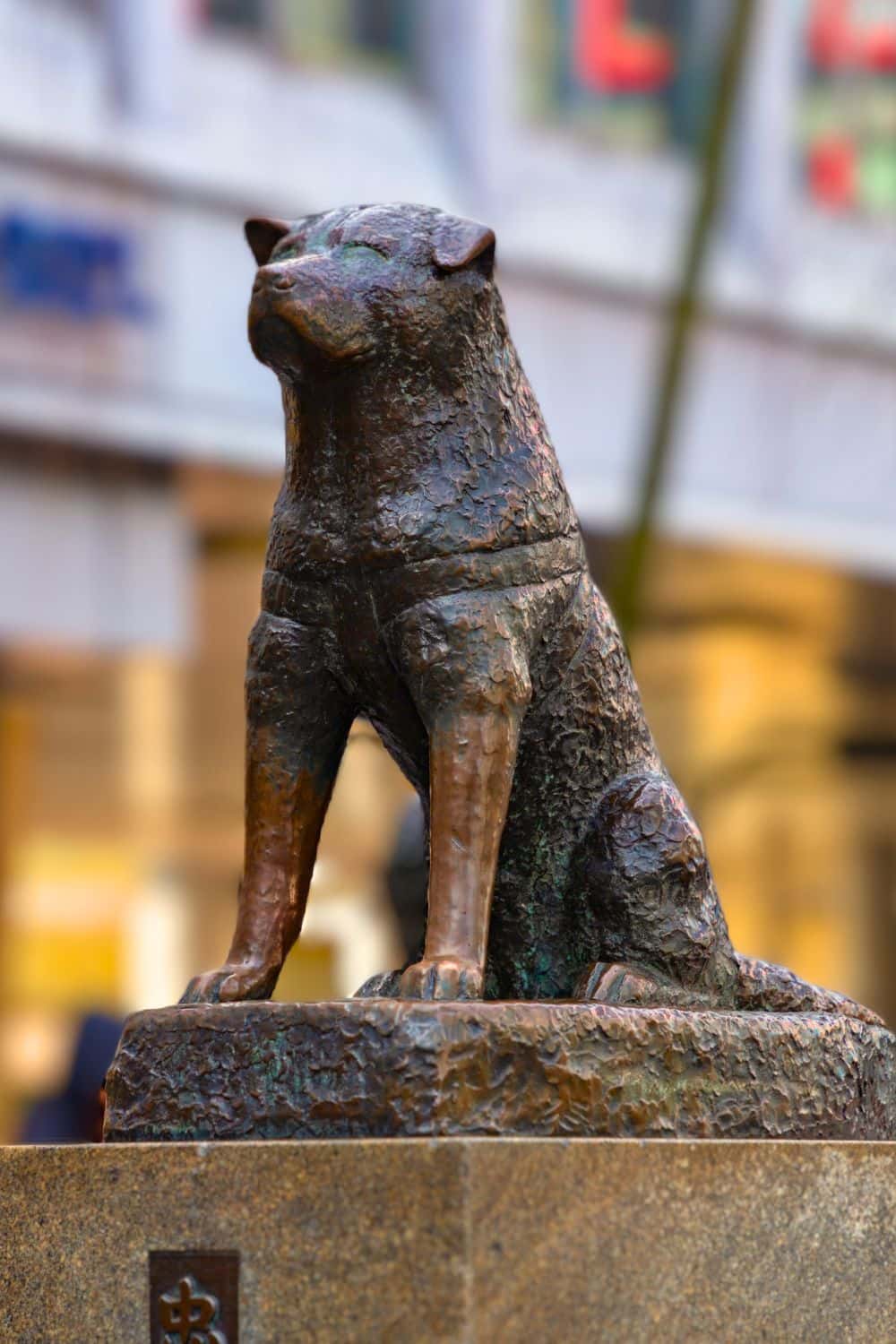
Hachiko Statue in Shibuya / 16-Day Japan Itinerary
In addition to the crossing and Hachiko’s statue, Shibuya is a great neighborhood to explore. It’s known for its shopping and dining scene, with many department stores, boutiques, and restaurants to choose from. You can find everything from high-end luxury brands to trendy fashion shops to unique souvenir shops.
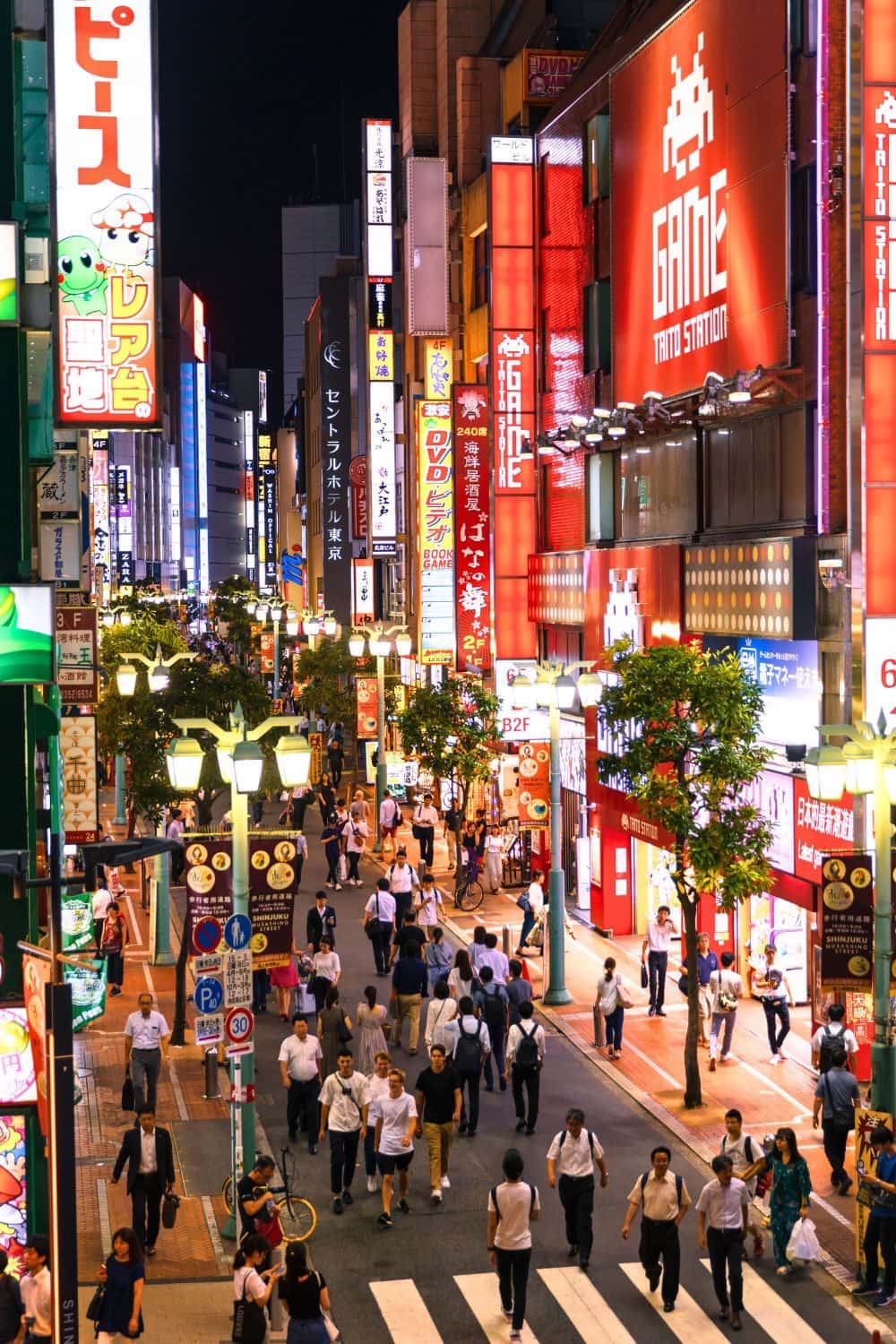
Shibuya Center-Gai / 16-Day Japan Itinerary
Some of the most popular shopping destinations in Shibuya include Shibuya 109, a landmark building known for its trendy fashion shops, and Shibuya Center-Gai, a pedestrian shopping street lined with cafes and specialty stores.
Explore Takeshita Street: A Colorful and Quirky Shopping Destination in Harajuku
Next, head to Takeshita Street in Harajuku District.
Takeshita Street is a vibrant and bustling pedestrian street. It is one of the most popular shopping destinations for Japanese youth and tourists alike.
The street is lined with trendy boutiques, quirky shops, and fashionable cafes, making it a hub for the latest fashion and pop culture trends.
In addition to shopping, Takeshita Street is also known for its mouth-watering street food. The street is home to many vendors selling delicious snacks, such as crepes, cotton candy, and ice cream.
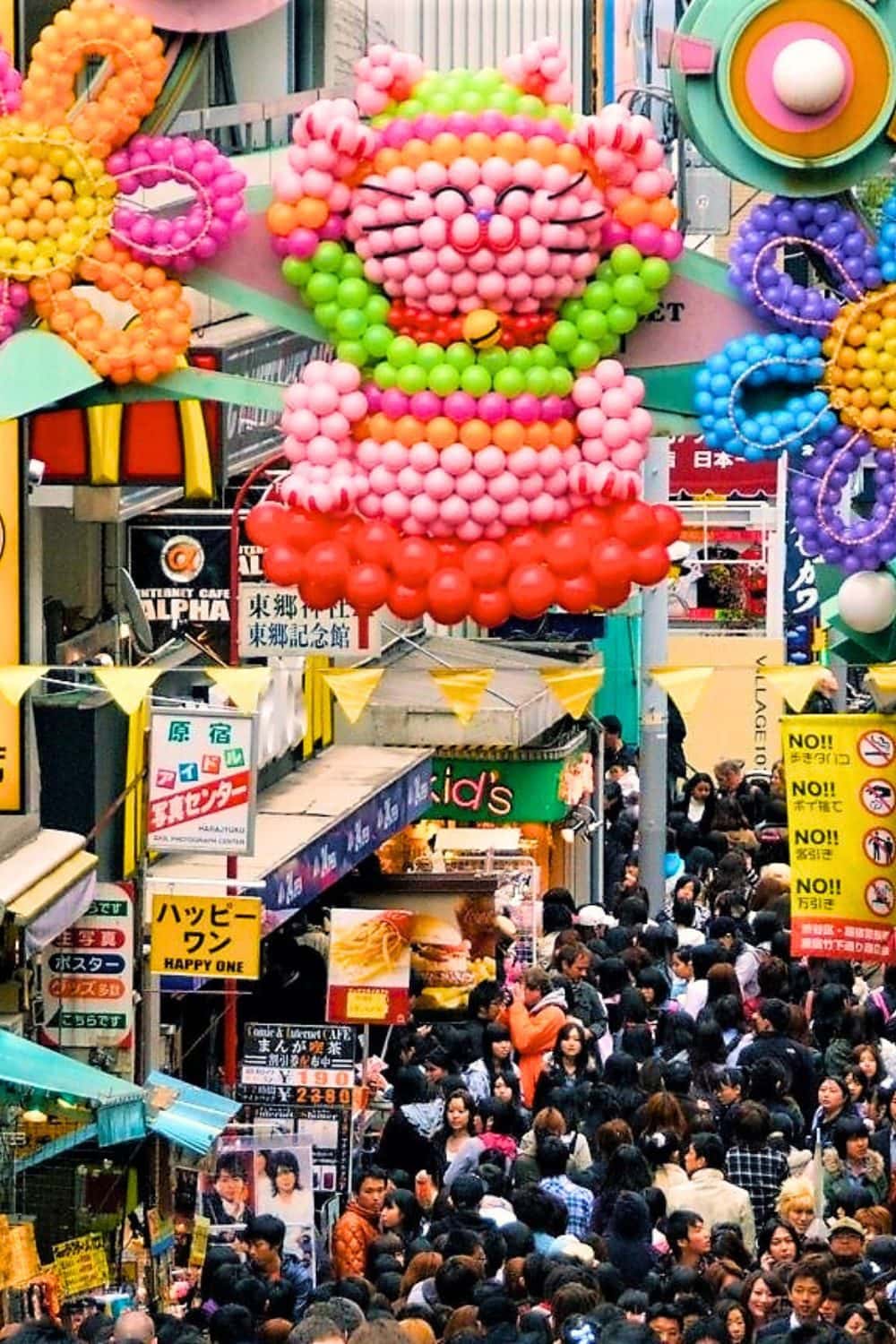
Takeshita Street in Harajuku / 16-Day Japan Itinerary
Here are some places that you need to check out on Takeshita Street:
- Kawaii Monster Cafe – It’s a colorful and quirky cafe that offers a unique dining experience with its colorful and whimsical decor, themed food and drinks that are Instagram-worthy, and performances by waitstaff dressed in colorful costumes.
- Daiso Harajuku – Daiso is a popular chain of 100-yen stores in Japan, and this location on Takeshita Street is the largest in Tokyo. Here, you can find a wide variety of cute and quirky items, from stationery to beauty products to household goods.
- Totti Candy Factory – This candy shop is famous for its giant rainbow cotton candy. It’s the perfect treat for anyone with a sweet tooth and makes for a great photo opportunity as well.
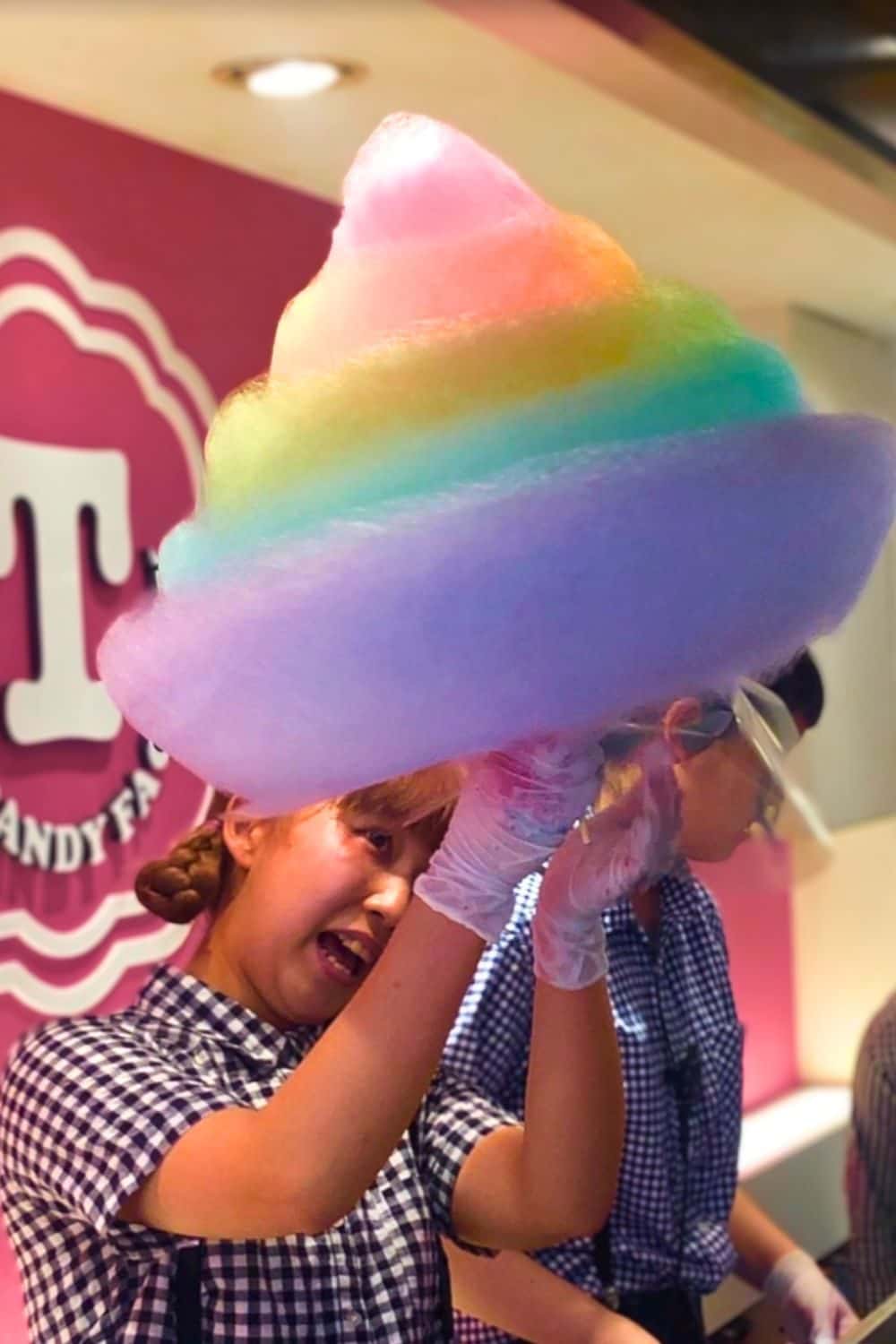
Totti Candy Company on Takeshita Street in Harajuku / 16-Day Japan Itinerary
- Kiddy Land – It’s a well-known toy store that features a wide variety of toys and collectibles, including many items featuring popular Japanese characters like Hello Kitty, Pikachu, and Gudetama. Kiddy Land. The store is spread over five floors, each with its own theme and selection of toys, making it a must-visit destination for anyone visiting Tokyo.
- Marion Crepes – This small shop is famous for its crepes, which are made fresh to order and come in a variety of flavors. It’s the perfect snack to enjoy while exploring Takeshita Street.
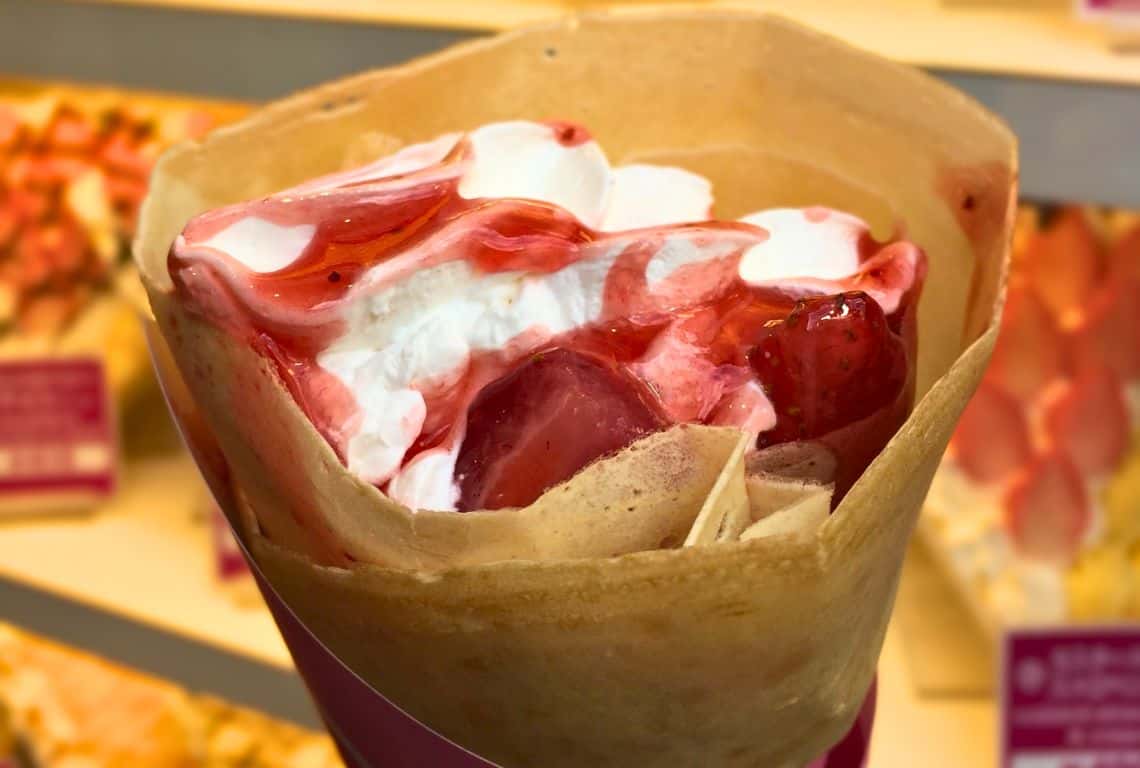
Crepes on Takeshita Street in Harajuku / 16-Day Japan Itinerary
Catch Awe-Inspiring Views from Tokyo Metropolitan Government Building Observation Deck
Now, let’s go to the Tokyo Government Building Observation Deck for sweeping views of Tokyo.
The Tokyo Metropolitan Government Building is a towering skyscraper in Shinjuku that serves as the administrative center for the city government.
What makes this building particularly popular among visitors is its observation deck, which is located on the 45th floor and offers breathtaking panoramic views of the city.
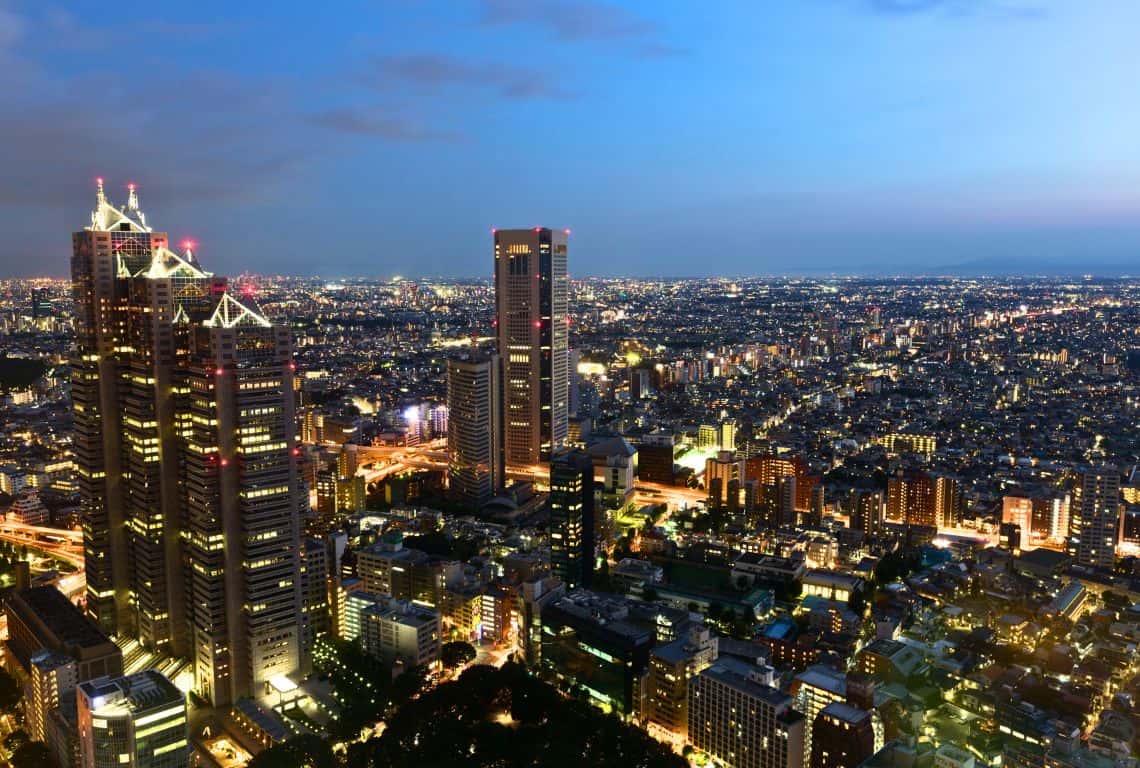
View from Metropolitan Government Building in Tokyo / 16-Day Japan Itinerary
From the deck, you will be able to see famous Tokyo landmarks like Tokyo Tower, the Tokyo Skytree, and maybe Mount Fuji on a clear day.
The observation deck is free to enter!
In addition to the observation deck, the Tokyo Metropolitan Government Building also houses several exhibition halls that showcase the city’s culture and history.
Check Out Kabukicho: Tokyo's Thrilling Entertainment District with a Vibrant Nightlife
Kabukicho is a lively neighborhood located in the heart of Shinjuku. It is one of the largest entertainment districts in Japan and is known for its bustling nightlife and entertainment venues.
The neighborhood gets its name from a planned but never-completed kabuki theater that was originally intended to be built in the area.
One of the main draws of Kabukicho is its nightlife scene, which includes everything from bars and nightclubs to karaoke and game centers. The area is especially popular with younger crowds, but there are also plenty of venues that cater to older or more laid-back crowds.
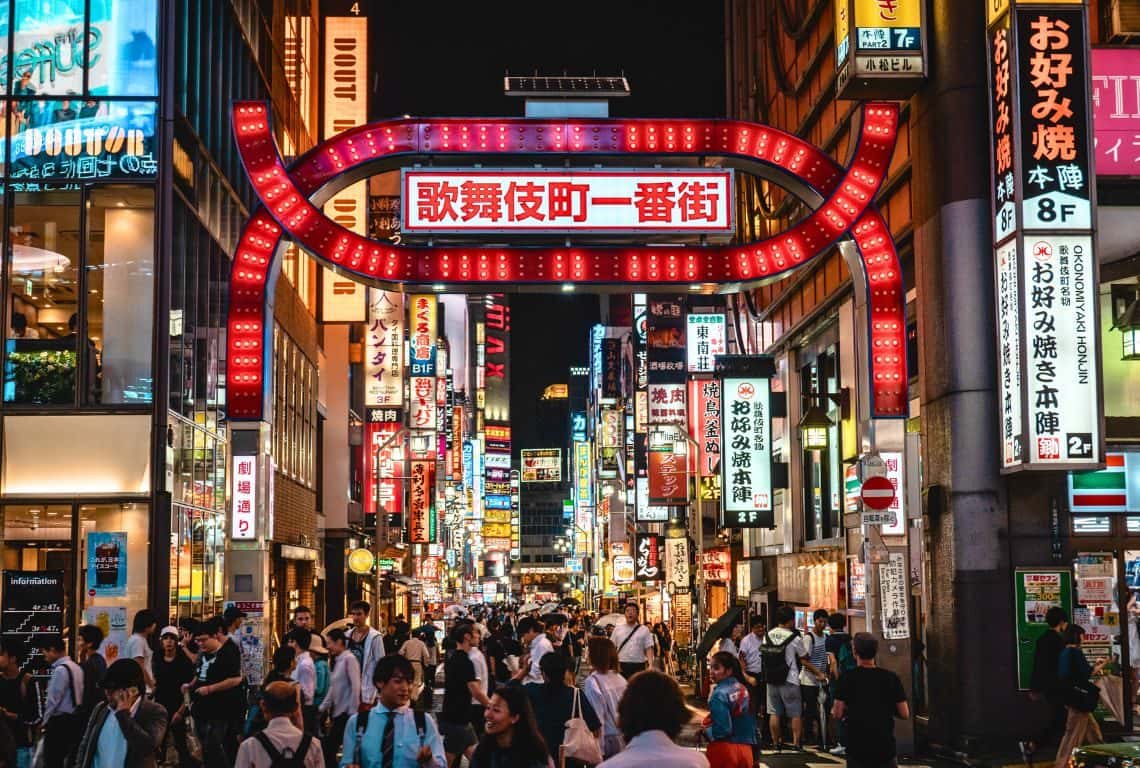
Kabuchiko in Shinjuku / 16-Day Japan Itinerary
Some of the most popular spots in Kabukicho include:
- Robot Restaurant – It is a futuristic-themed show with robots and dancers
- Shinjuku Golden Gai – A small but vibrant area with narrow alleyways lined with tiny bars and restaurants.
- Several department stores and shopping malls in the area, including the massive Isetan Shinjuku and Takashimaya Times Square.
- Omoide Yokocho (Memory Lane) – This narrow alleyway is located just a few steps away from Kabukicho and offers a glimpse into old Tokyo. Lined with small bars and restaurants, it’s a great place to grab a drink or a bite to eat while taking in the atmosphere.
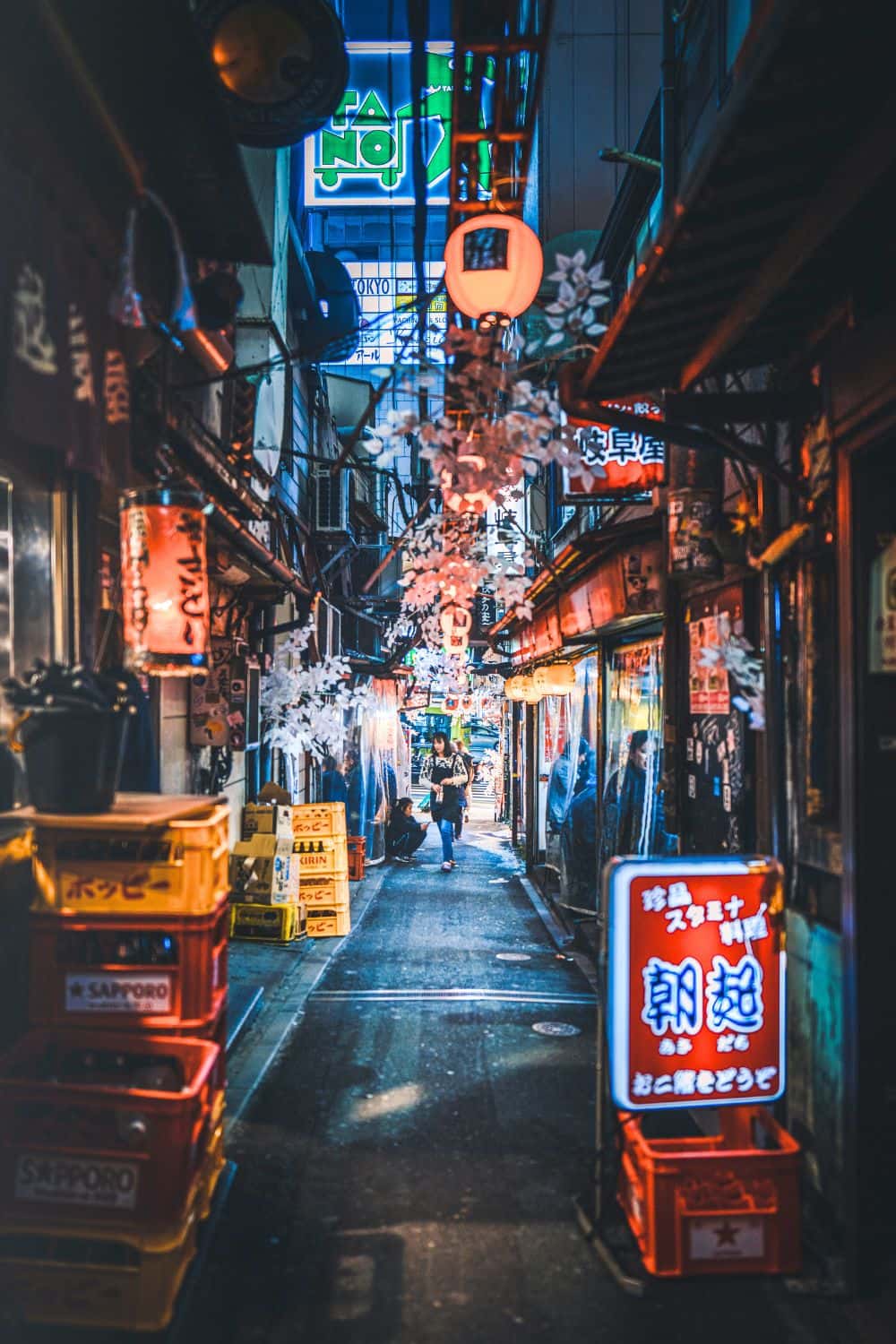
Omoide Yokocho in Shinjuku / 16-Day Japan Itinerary
- Godzilla Head – Standing tall above the Toho Cinema in Kabukicho is a life-sized statue of Godzilla’s head. It’s a popular spot for photos and is especially impressive when lit up at night.
- Samurai Museum – Located just a short walk from Kabukicho, the Samurai Museum is a fascinating attraction that showcases the history and culture of samurai warriors. You can learn about the weapons and armor used by samurai, watch live demonstrations, and even dress up in period costumes for photos.
- Don Quijote – This popular discount store chain has a location in Kabukicho and is a great place to shop for souvenirs, cosmetics, and other items at bargain prices.
This concludes your second day of exploring Tokyo. It is time to grab something to eat and head back to your hotel and get a good night’s sleep.
If you are staying in Ginza, then I have several recommendations for some great places to try some Japanese delicacies:
- Sushi Tokami – This Michelin-starred sushi restaurant is located in the basement of the Seiwa Silver building in Ginza, not far from Shimbashi station and it is known for its exquisite sushi and sashimi dishes. The restaurant has a traditional Japanese atmosphere and a counter-style seating arrangement that will allow you to watch the chef prepare the meals.
- Kyubey – Another Michelin-starred sushi restaurant, Kyubey has been serving sushi in Ginza since 1935. The restaurant is famous for its high-quality ingredients and skilled chefs, and diners can choose from a variety of sushi and sashimi options.
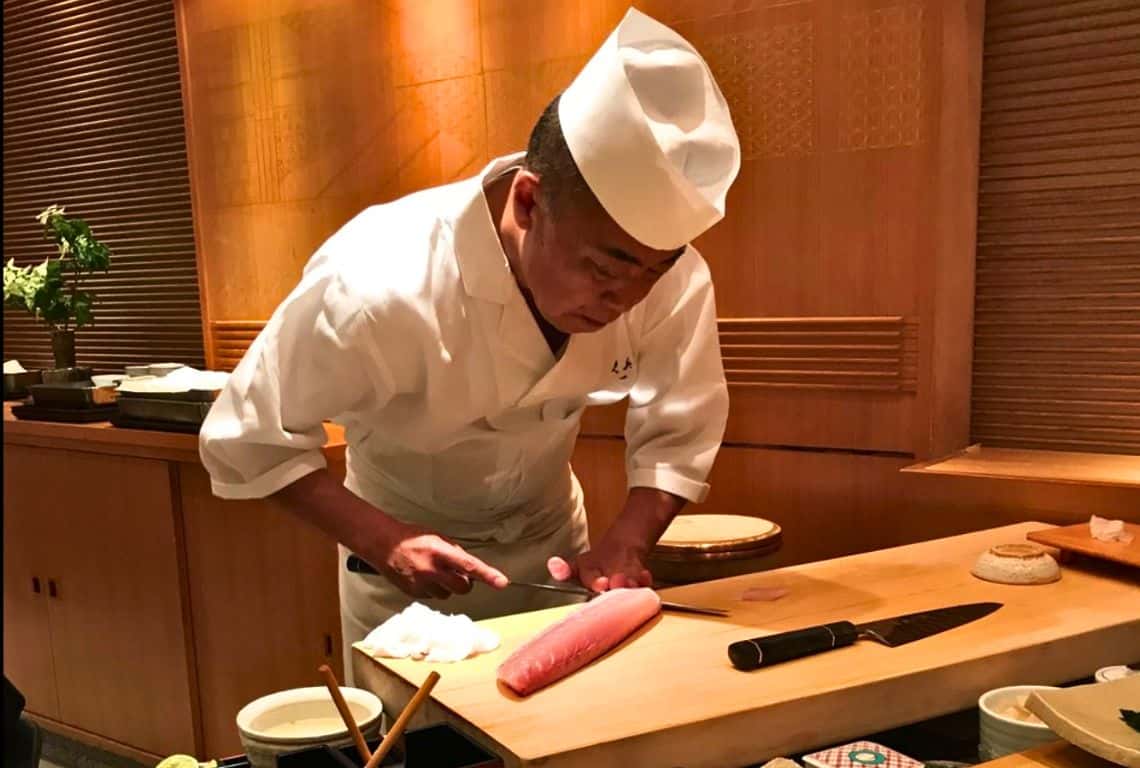
Kyubey in Ginza / 16-Day Japan Itinerary
- Ginza Kagari Honten – This cozy ramen shop is famous for its rich and flavorful broth, made with chicken and seafood. The restaurant only has a few seats, so be prepared to wait in line, but the delicious ramen is well worth it.
- Butagumi – If you’re a fan of pork, Butagumi is the place to go in Ginza. This restaurant specializes in tonkatsu, or breaded and fried pork cutlets, and offers a variety of different cuts and preparations.
DAY 3 - TOKYO
- Explore Tokyo
1. Toyosu Fish Market
2. Imperial Palace
3. Akihabara
4. Sensoji Temple
Explore the Vibrant Toyosu Fish Market and Watch Tuna Auction
Start your day early at Toyosu Fish Market. It is one of the most famous and popular fish markets in the world. It’s located in the Toyosu area of Tokyo, and it replaced the famous Tsukiji Fish Market in 2018.
The market is a massive complex that covers more than 40 hectares and includes separate areas for auctions, wholesale sales, and retail sales.
You can watch the famous tuna auctions in action, where auctioneers and buyers inspect and bid on the tuna that are sold for tens of thousands of dollars.

Kyubey in Ginza / 16-Day Japan Itinerary
In addition to the auctions, there are also many shops and restaurants in the market that sell fresh seafood and other culinary delights. Some of the must-try foods at Toyosu Fish Market include sushi, sashimi, grilled seafood, and the famous Japanese omelet known as tamagoyaki.
To watch the tuna auction at Toyosu Fish Market, you will need to participate in a lottery system. Here is how it works:
- The lottery is held daily at the Visitors’ Center.
- There are 120 available spots to watch the auction.
- The tuna auction takes place early in the morning, typically between 5:30 and 6:30 am, so you need to arrive at least at 4:30 am to register and enter the lottery. The Visitors’ Center opens at 5:00 am, the line starts forming at about 4 am. So, arrive early to increase their chances of winning.
- Once the Visitor’s Center opens, fill out a registration form with your name, nationality, and number of people in your group.
- Submit the form to the staff at the Visitors’ Center and wait for the lottery to begin.
- Winners of the lottery are given a colored vest and are escorted to the observation deck to watch the auction.
- Flash photography is not allowed.
- Visitors who are not selected in the lottery can still explore the rest of the market and enjoy fresh seafood and other culinary delights.
Discover the Rich History and Serene Beauty of the Imperial Palace
Next on the 16-day Japan itinerary is the Imperial Palace in Tokyo.
Imperial Palace in Tokyo is the residence of the Emperor of Japan. While the palace itself is closed to the public, there are still plenty of attractions to see in the surrounding gardens and parks.
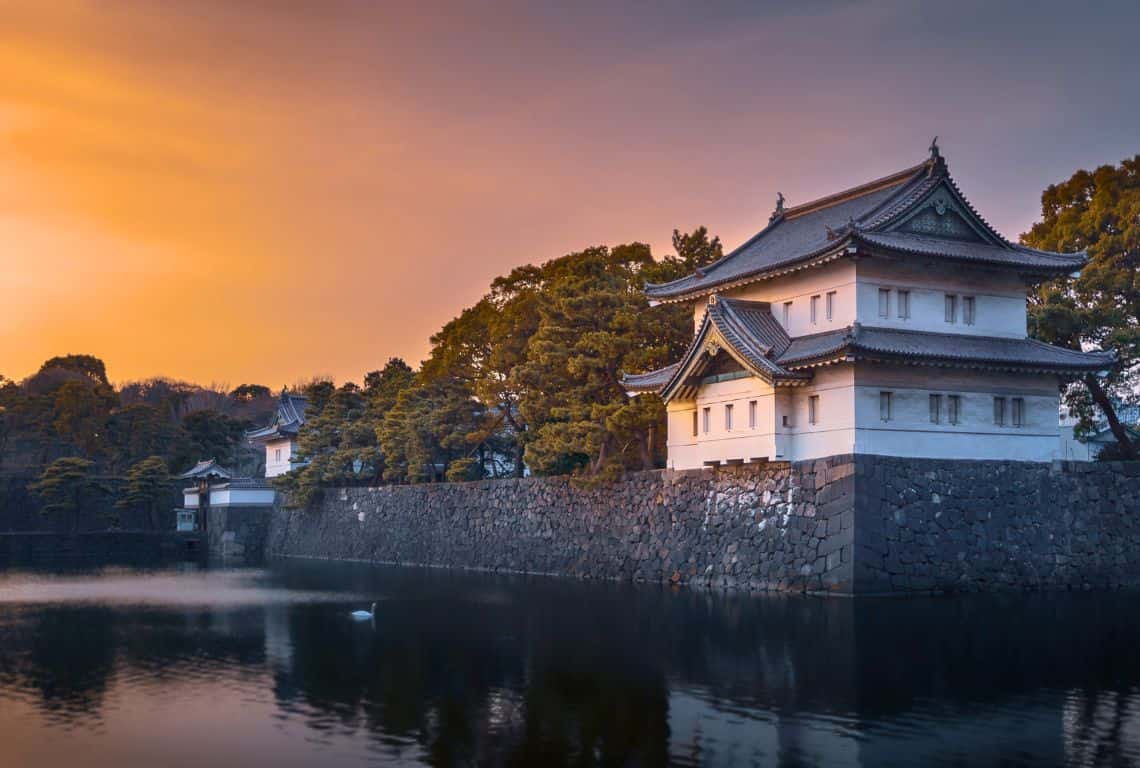
Imperial Palace in Tokyo at Sunset / 16-Day Japan Itinerary
- One of the main attractions is the East Gardens, which is a spacious park with well-manicured lawns, cherry blossom trees, and various traditional Japanese structures.
- One interesting feature of the Imperial Palace East Gardens is the Fujimi Yagura, which is a three-story watchtower that was originally built in the 17th century. You can climb to the top of the tower to get a panoramic view of the surrounding gardens and the city skyline.
- Another must-see spot is the Nijubashi Bridge, which is one of the most iconic landmarks of the Imperial Palace. This historic bridge is located in front of the main entrance to the Imperial Palace.
The bridge dates back to the Edo period when it was originally built to span the palace moat and provide a grand entrance to the palace grounds. The bridge is made up of two arches and is adorned with intricate carvings and decorations, including mythical beasts and cherry blossom motifs.
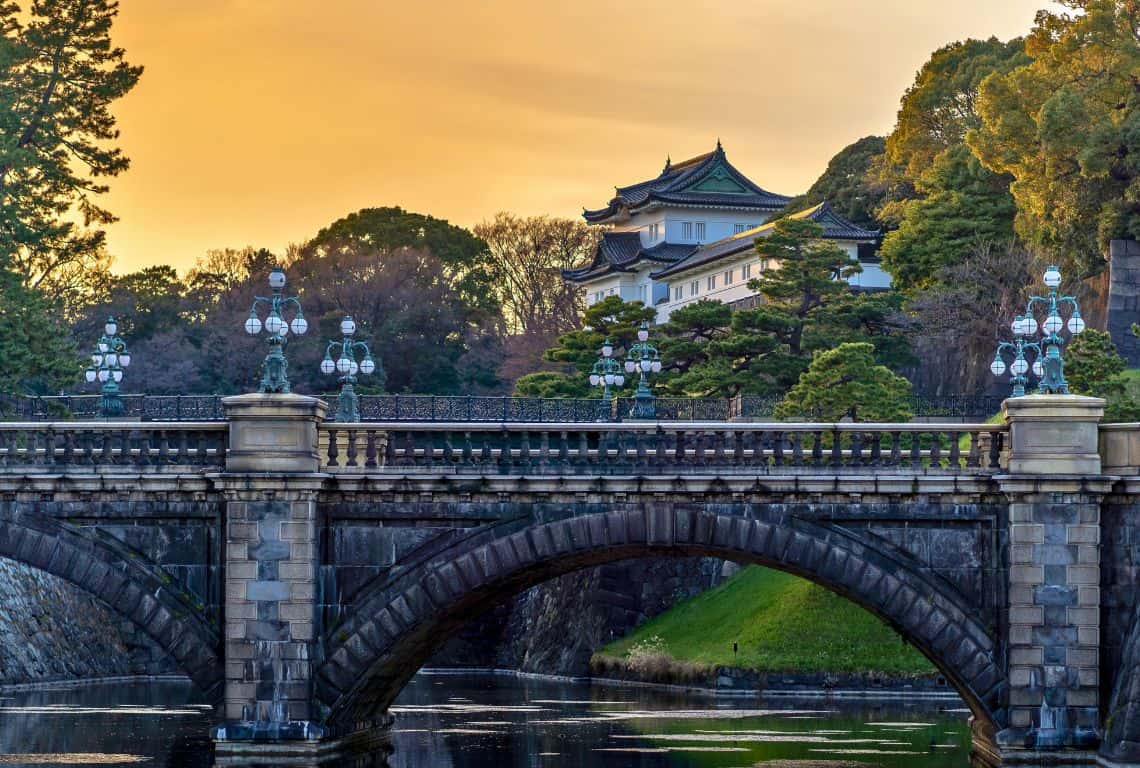
Nijubashi Bridge at Imperial Palace in Tokyo at Sunset / 16-Day Japan Itinerary
- In addition, the Imperial Palace also has an Imperial Palace East Garden Museum, which displays various artifacts and historical objects related to the palace and the Japanese imperial family. The museum has a range of exhibitions, including paintings, ceramics, and calligraphy, which provide insight into the history and culture of Japan.
- Another must-see sight is Kikyo-mon Gate. It is one of the main gates of the Imperial Palace and is located on the east side of the palace grounds. The gate was originally built in the 17th century and underwent several renovations over the years. The current gate is a reconstruction that was completed in the 1960s using traditional Japanese techniques and materials. The gate is notable for its distinctive curved roof and impressive wooden carvings, which depict chrysanthemum and paulownia motifs, the imperial emblems of Japan.
- Otemon Gate is another major gate of the Imperial Palace, located on the southern side of the palace grounds. It was originally built in the 17th century but was destroyed in a fire and subsequently reconstructed in the 1880s. The gate is an impressive structure, featuring a massive wooden roof and intricate carvings on its wooden doors.
You should take part in a guided tour of the palace grounds, which provides a detailed overview of the history and architecture of the palace. The tour includes visits to the Seimon Ishibashi Bridge, the Kikyo-mon Gate, and the Otemon Gate: Private Tour – History, Art, and Nature at the Imperial Palace.
Akihabara: Explore Tokyo's Electric Town and Otaku Culture Hub
Akihabara, also known as “Akiba,” is a vibrant and colorful district in Tokyo that has become synonymous with otaku culture. The area is a hub for anime, manga, video games, and other fandoms, and it attracts visitors from all over the world who are passionate about these topics.
Here are some things to do and see in Akihabara:
- Electronics shopping: Akihabara is known for its huge variety of electronic shops, selling everything from cameras and smartphones to computer parts and gaming consoles. Some of the most popular electronics stores include Yodobashi Camera, Bic Camera, and Sofmap.
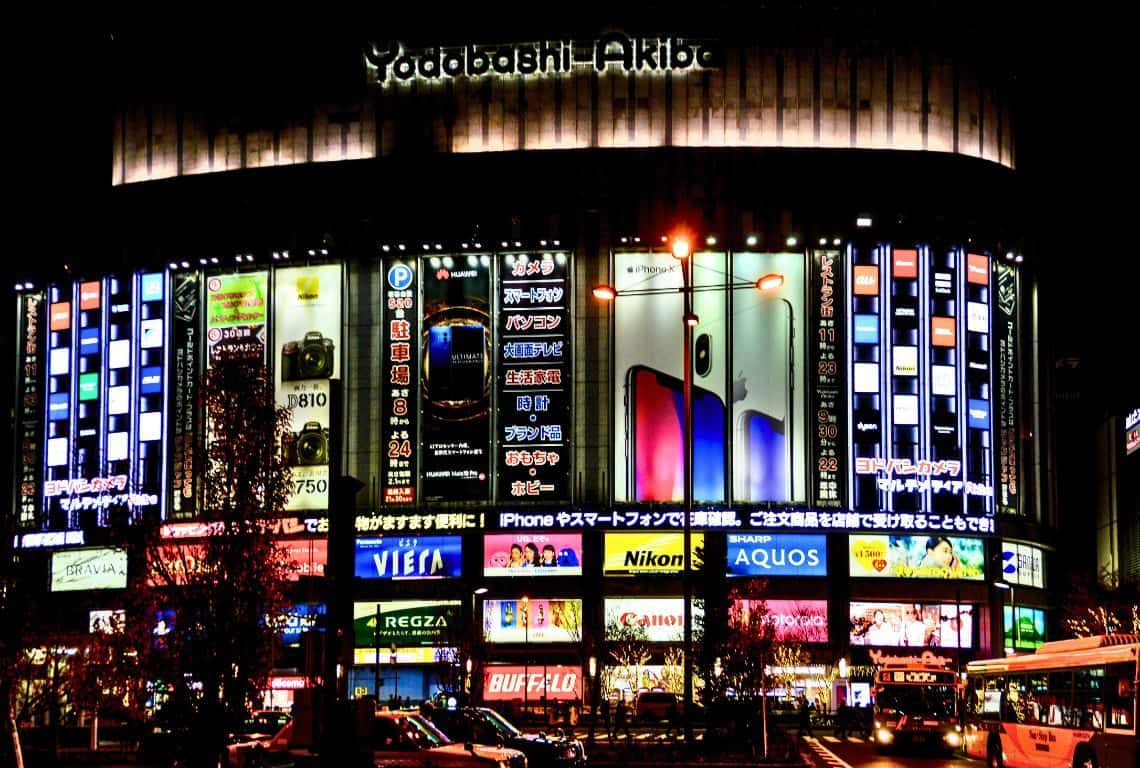
Akihabara in Tokyo / 16-Day Japan Itinerary
- Anime and manga: Akihabara is also famous for its anime and manga culture. There are many anime shops and maid cafes in the area, including the famous Akihabara Radio Kaikan building, which has multiple floors dedicated to anime and manga merchandise.
- Gaming: Akihabara is a popular destination for gamers, with many arcades and gaming centers in the area. The SEGA Akihabara Building is a must-visit for gaming enthusiasts, with multiple floors dedicated to various types of games.
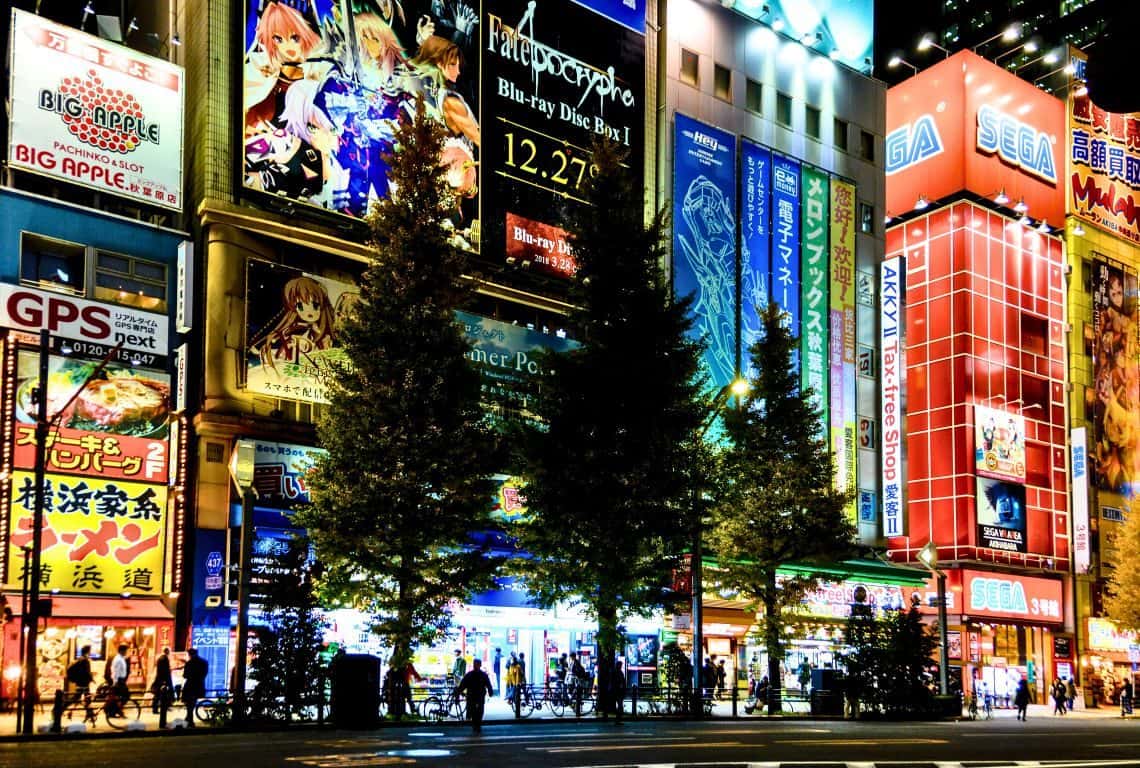
Akihabara in Tokyo / 16-Day Japan Itinerary
- Cafes and restaurants: Akihabara is home to many themed cafes, such as maid cafes and anime-themed cafes. Maid cafes are a unique and popular feature of Japanese pop culture, especially in Akihabara. These cafes are staffed by young women dressed in maid costumes who serve customers and engage in playful conversation and activities.
In maid cafes, customers are treated as “masters” and are served by the maids with a high level of attention and hospitality. The atmosphere is usually very cute and cheerful, with the maids speaking in a polite and playful manner. Some cafes also offer special services like photo opportunities with the maids, games, and karaoke.
There are many maid cafes in Akihabara, and popularity can vary depending on a number of factors such as theme, atmosphere, and services offered. Some of the most popular maid cafes in Akihabara include:
Maidreamin is one of the most well-known and popular maid cafes in Akihabara, with multiple locations in the area. The cafe has a colorful and energetic atmosphere, with maids who perform songs and dances for customers.
@Home Cafe is another popular maid cafe in Akihabara that offers a more laid-back and relaxing atmosphere. The cafe has a menu of food and drinks, as well as games and photo opportunities with the maids.
In my opinion, the best way to experience Akihara is to take a guided tour.
I attended Akihabara Anime and Gaming Adventure Walking Tour and it was great. You will get explanations about Japanese culture that you would not get if exploring the area alone, and experience all the “must do” activities in Akihabara, such as visiting a retro video game store, a maid cafe, a photo booth, and much more.
Discover the Rich History and Spiritual Beauty of Sensoji Temple
Sensoji Temple is one of the most popular and oldest Buddhist temples in Tokyo, located in the Asakusa district.
The temple was founded in the 7th century and is dedicated to the Bodhisattva Kannon, the goddess of mercy.
Legend has it that in the year 628, two brothers found a small statue of Kannon in the Sumida River while fishing. They recognized the statue as a sacred symbol and brought it to their village, where they built a small temple to honor the goddess. Over time, the temple grew and became known as Sensoji Temple
Here is what not to miss at the temple:
- The main entrance to the temple is through the Kaminarimon Gate, which features a large red lantern and two fierce-looking statues of gods.
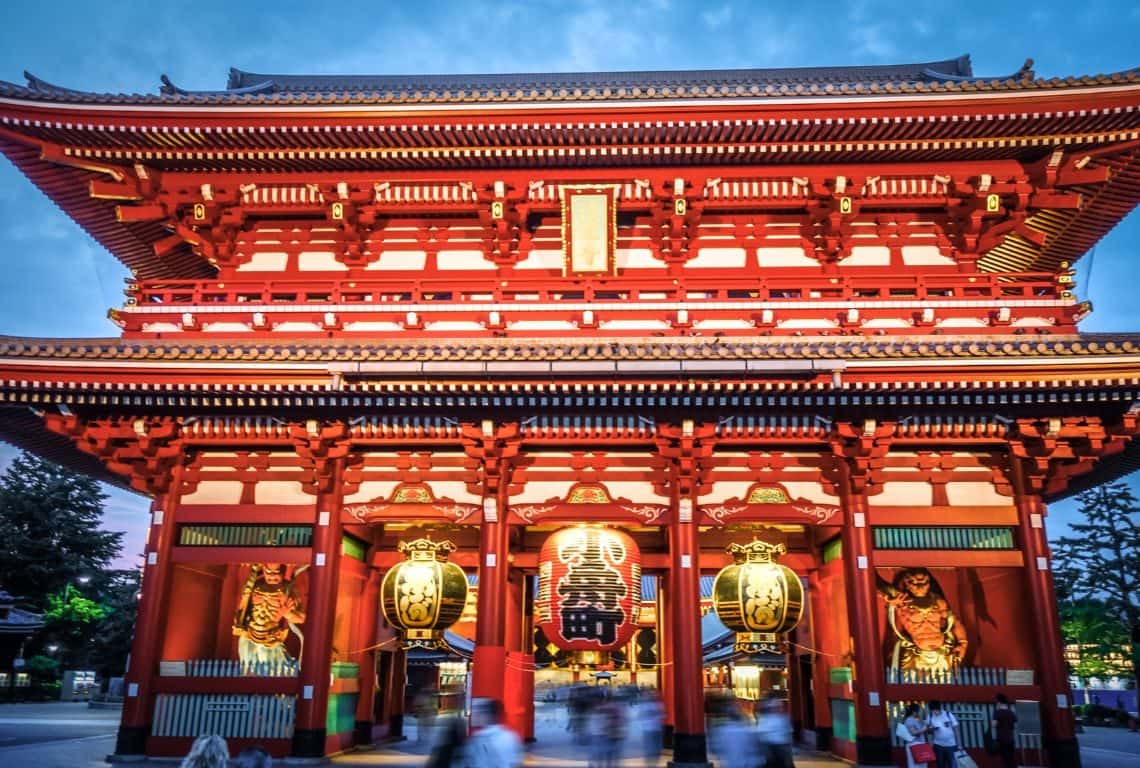
Kaminarimon Gate at Sensoji Temple / 16-Day Japan Itinerary
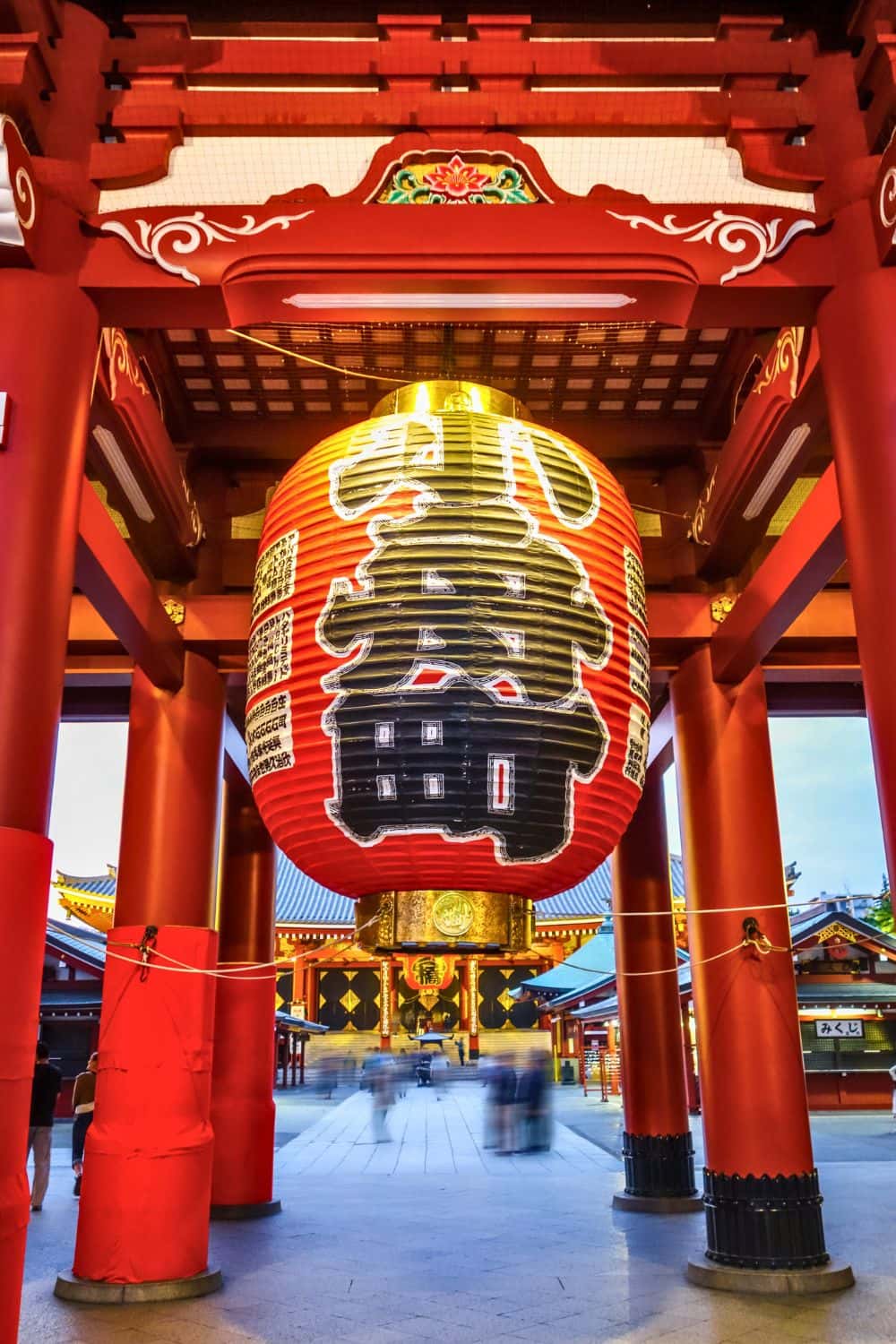
Kaminarimon Gate at Sensoji Temple / 16-Day Japan Itinerary
- The famous street leading to Sensoji Temple is called Nakamise-dori, a bustling shopping street that stretches about 250 meters from the Kaminarimon Gate to the temple grounds.
The street is lined with more than 50 shops and stalls selling traditional souvenirs, snacks, and sweets, providing visitors with a glimpse into Tokyo’s rich history and culture.
Nakamise-dori has a long history dating back to the 17th century when the street was established as a shopping district for pilgrims visiting the temple.
Today, the street remains a popular shopping destination for both locals and tourists, offering a wide variety of items, including Japanese snacks such as senbei (rice crackers), manju (sweet buns), and ningyo-yaki (small cakes shaped like dolls).
The street is also decorated with traditional Japanese lanterns and seasonal decorations, making it a picturesque location for taking photographs.
- The main hall of Sensoji Temple is a beautiful five-story pagoda, which offers panoramic views of Tokyo from the top.
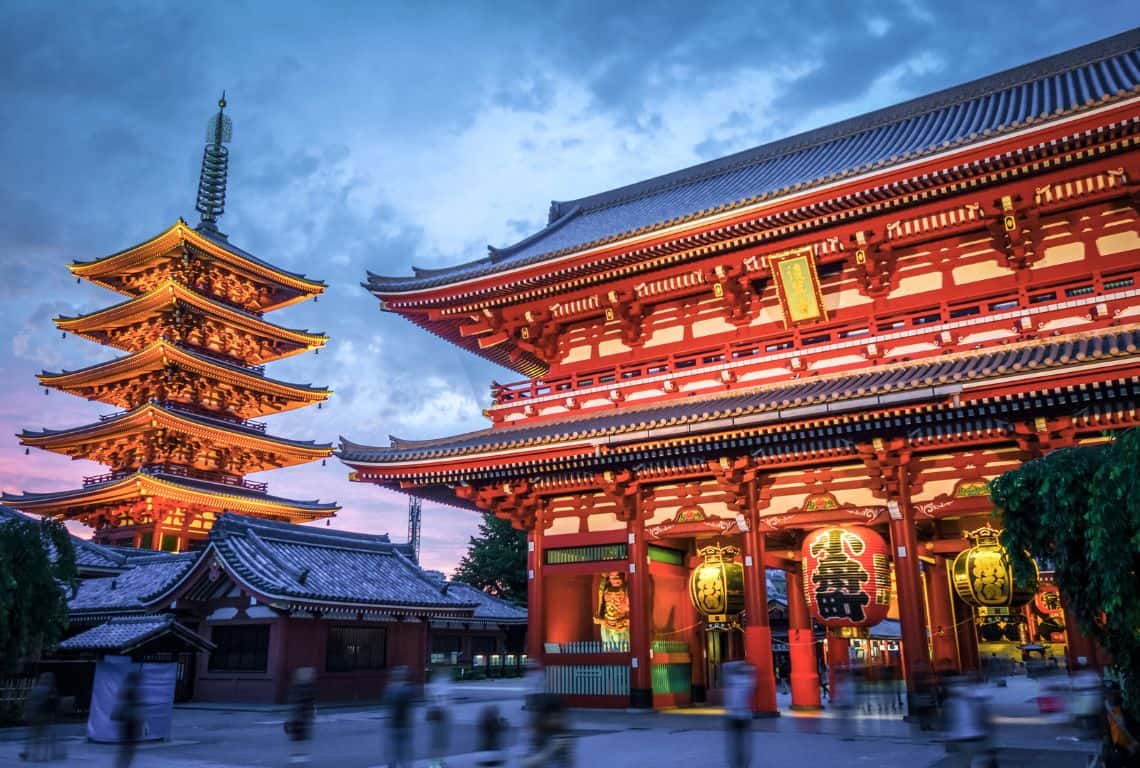
5-Story Pagoda at Sensoji Temple / 16-Day Japan Itinerary
- In front of the main hall of the temple, you will find a large incense burner. The smoke from the burning incense is said to have healing powers, and visitors often waft the smoke over their heads and bodies to purify themselves before entering the temple.
- Make sure to explore the temple’s underground treasure hall, which houses a collection of valuable Buddhist artifacts and artwork.
Here are some details on how to visit the underground treasure hall:
Opening hours: The underground treasure hall is open to visitors daily from 9:00 a.m. to 4:30 p.m. However, please note that the hall may close temporarily for maintenance or during special events.
Admission fee: The admission fee to enter the treasure hall is 300 yen for adults and 200 yen for children. Tickets can be purchased at the entrance to the hall.
Entrance location: To access the underground treasure hall, you need to enter through a small door located at the back of the main hall of the temple. The entrance is marked by a sign in English and Japanese.
The Sensoji underground treasure hall is home to a collection of valuable Buddhist artifacts and artwork, including statues, sutras, and paintings. The hall’s exhibits are rotated periodically, so each visit offers a new perspective on Japanese Buddhist history and culture. You can expect to see exquisite examples of Japanese craftsmanship and artistry, dating back hundreds of years.
Please note that photography is not allowed inside the underground treasure hall, and you will need to remove your shoes before entering the exhibition space.
- Finally, try your luck at Omikuji, a paper fortune-telling system available at the temple!
This concludes 2 days of exploring Tokyo. Ahead of you are two exciting day trips from Tokyo!
If you have more time for Tokyo, I put together 3-Day Tokyo Itinerary that has more places to see and things to do.
DAY 4 - DAY TRIP TO HAKONE FROM TOKYO
- A Day Trip to Hakone
If you’ve had your fill of the fast-paced energy of Tokyo, it’s time to switch gears and experience a different side of Japan.
Luckily, just a short trip away from the city, you will find a plethora of day trip options that offer a change of pace and scenery. Whether you are looking to relax in natural hot springs, wander through ancient temples and gardens, or sample delicious local cuisine, the areas surrounding Tokyo are full of hidden gems waiting to be explored.
So take a break from the city bustle and get ready to slow down and savor all that Japan has to offer!
Escape the Bustle of Tokyo and Unwind in Nature: A Day Trip to Hakone
Hakone, a beautiful town nestled in the scenic Fuji-Hakone-Izu National Park, is a perfect escape from the bustling city of Tokyo.
With its picturesque views of Mount Fuji, tranquil Lake Ashi, and lush cedar forests, soothing onsens Hakone has been a popular destination for centuries!
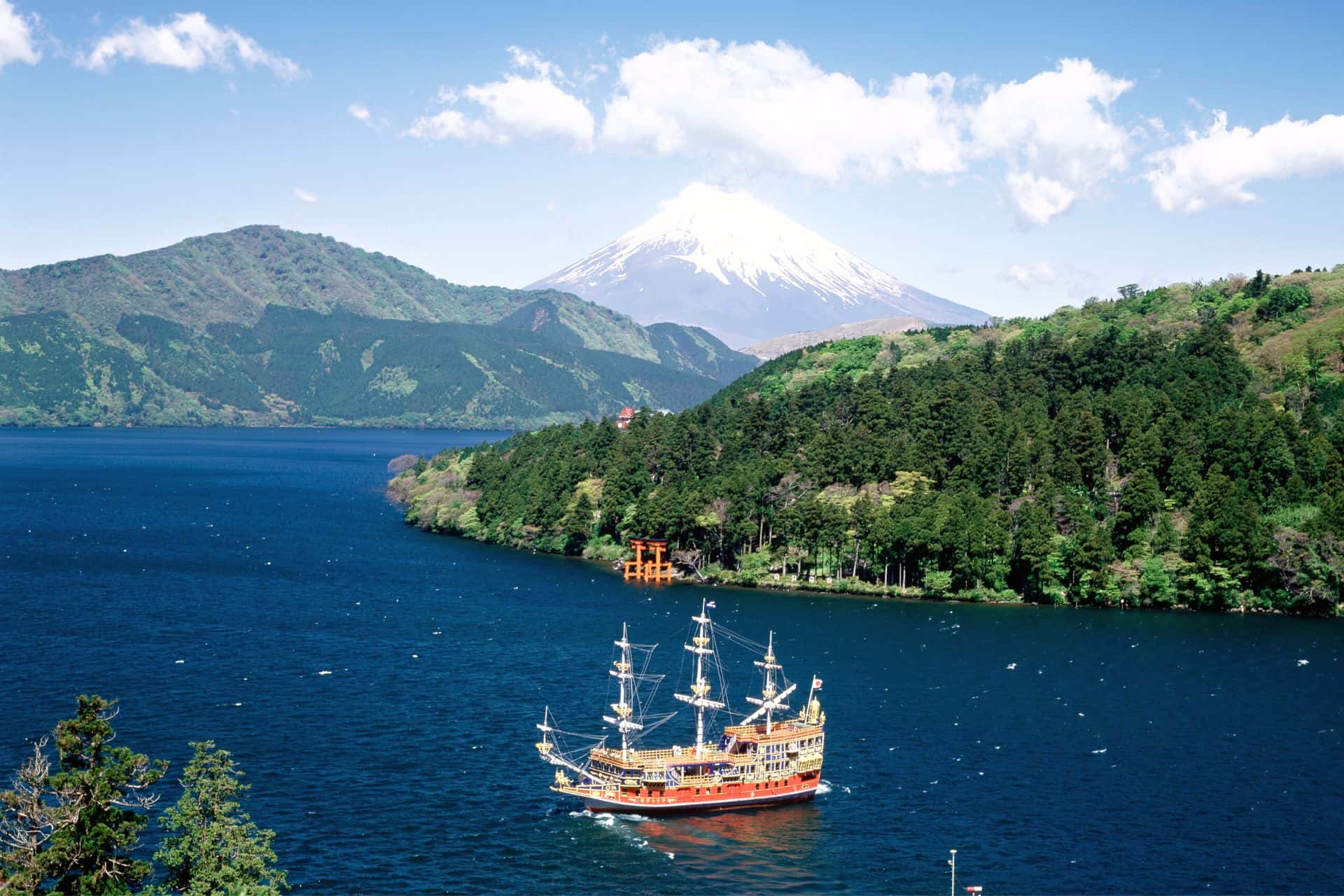
Lake Ashi in Hakone / 16-Day Japan Itinerary
There are many things to do in Hakone and you can easily spend a few days exploring the area. To make it more manageable, there are a few things you should not miss:
- One of the most famous attractions is the Hakone Open-Air Museum, which features a vast collection of sculptures from Japanese and international artists.
- Another popular activity is taking a relaxing dip in one of the many hot springs, or onsen, in the area.
- You can also take a scenic boat ride on Lake Ashi and enjoy stunning views of Mt. Fuji.
- And for those who love nature, there are numerous hiking trails with breathtaking views of the surrounding mountains and valleys.
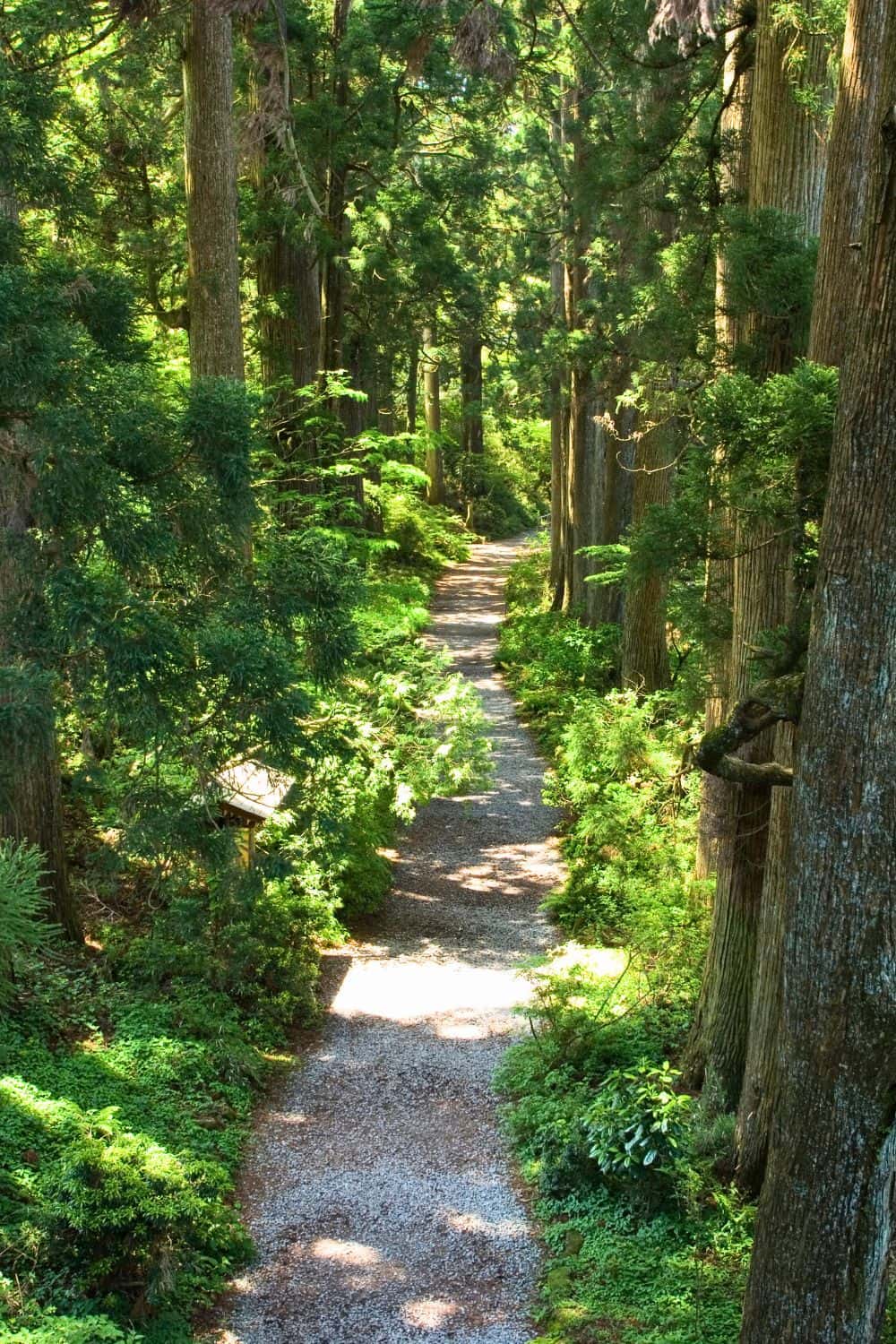
Hiking Trails in Hakone / 16-Day Japan Itinerary
- The Hakone Ropeway is one of the most popular attractions in Hakone and a must-see for any visitor. The ropeway takes you on a 30-minute scenic journey over the Owakudani volcanic valley, which offers breathtaking views of the surrounding mountains and Lake Ashi.
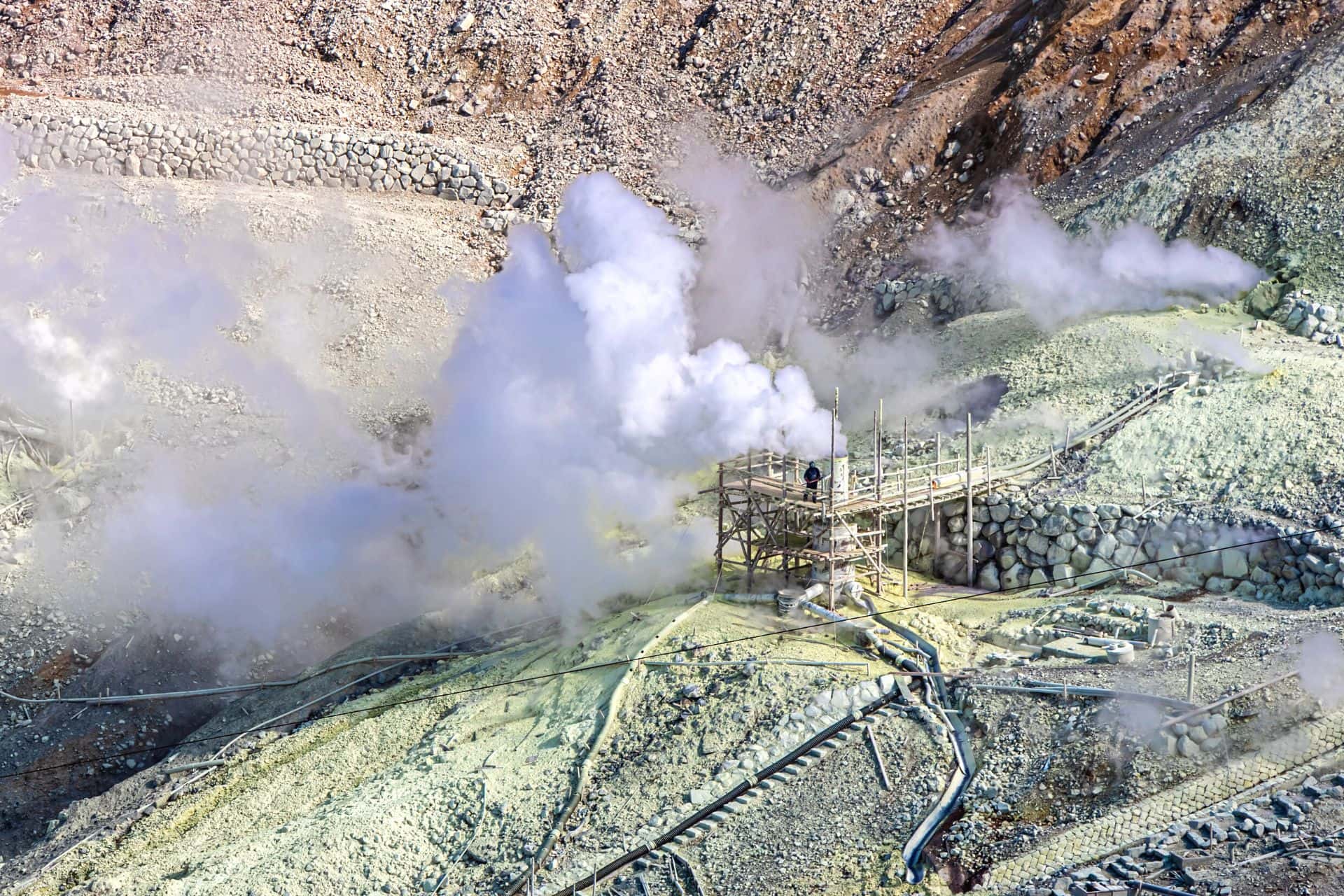
Owakudani Volcanic Valley in Hakone / 16-Day Japan Itinerary
- Odawara Castle is another must-visit attraction in Hakone. This historic castle dates back to the 15th century and was once the stronghold of the powerful Hojo clan. The castle features a museum that displays armor, weapons, and other artifacts from the castle’s past.
- Finally, don’t miss the chance to try some of the local specialty foods, such as black eggs boiled in the sulfur-rich hot springs, and the deliciously creamy Hakone tofu.
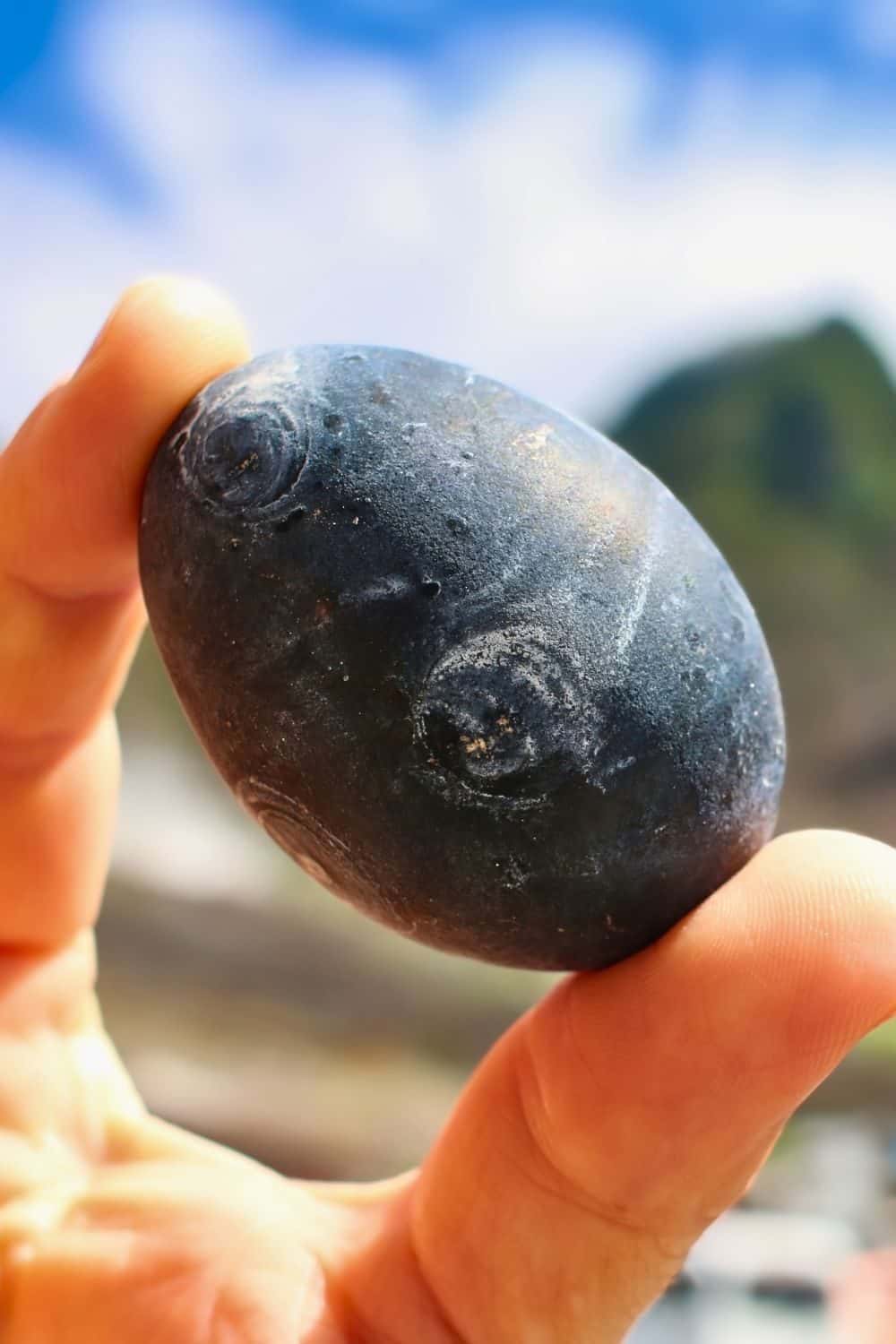
Black Eggs in Hakone / 16-Day Japan Itinerary
DAY 5 - DAY TRIP TO SEE SNOW MONKEYS (WINTER) OR DAY TRIP TO NIKKO (OTHER SEASONS) FROM TOKYO
- Day Trip to See Snow Monkeys from Tokyo (winter)
- Day Trip to Nikko from Tokyo (spring, summer, or fall)
Embark on a journey beyond the bustling city of Tokyo and explore the natural beauty of Japan with two distinct day trips.
If you are visiting Tokyo in the winter, then, hands down, immerse yourself in the wonderland of the Jigokudani Snow Monkey Park and witness adorable Japanese macaques soaking in steaming hot springs amidst the snowy landscape. A day trip from Tokyo to see snow monkeys will be the highlight of your trip to Japan!
If you are visiting Tokyo in the other seasons, discover the UNESCO World Heritage Site of Nikko, famous for its stunning temples and shrines set amidst lush forests and serene waterfalls.
From winter wonderland to a world of natural beauty, these two day trips offer an escape from the city and an unforgettable experience in Japan!
Day Trip from Tokyo to See Snow Monkeys Soaking in Hot Spring (Winter)
The snow monkeys, also known as Japanese macaques, are a popular attraction in the Nagano prefecture of Japan.
You can watch these playful and intelligent primates soak in the warm waters of the hot springs, surrounded by snow-capped mountains.
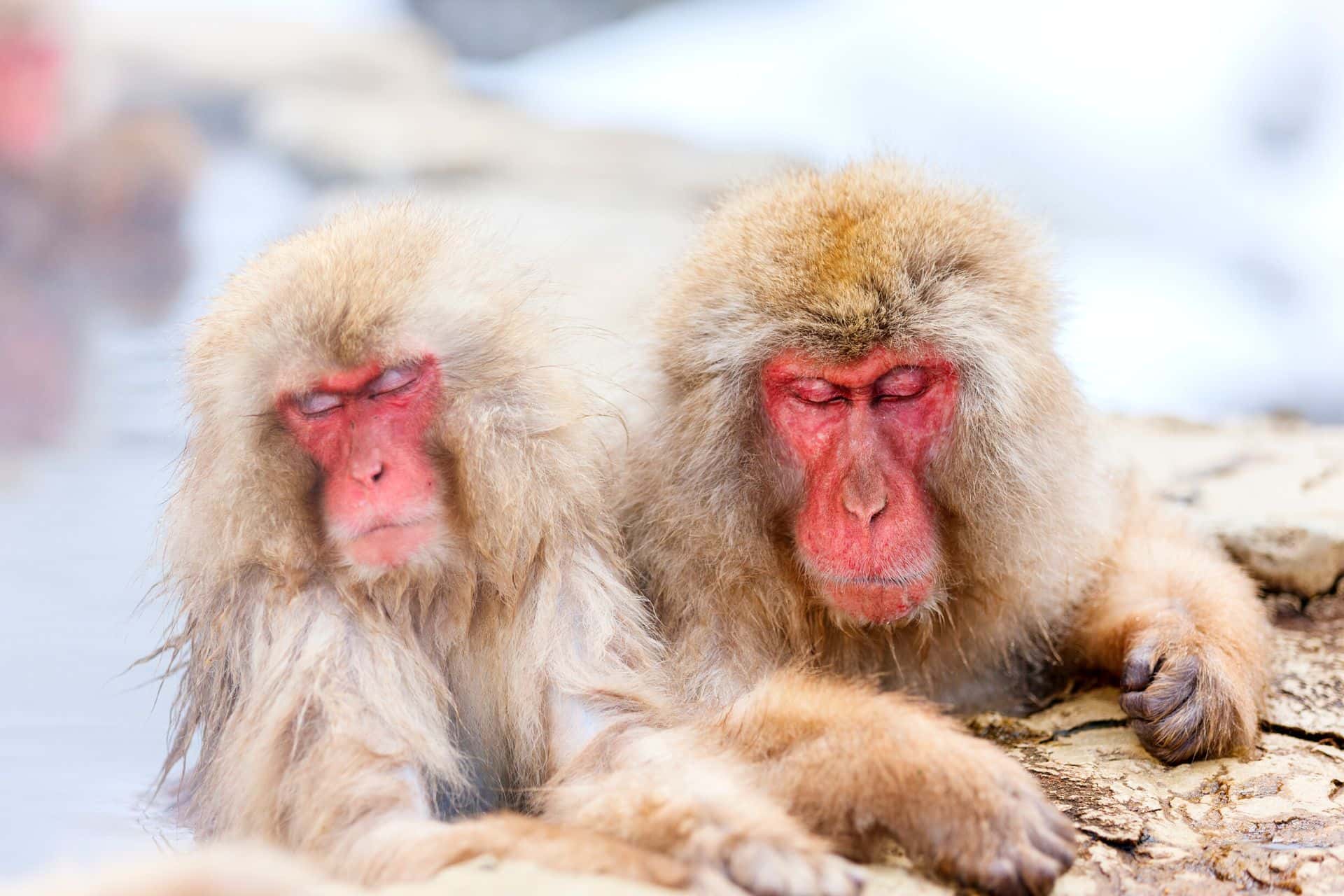
Day Trip to See Snow Monkeys from Tokyo / 16-Day Japan Itinerary
The snow monkeys are unique in that they are the northernmost non-human primate and the only ones known to live in areas with heavy snowfall.
There are many opportunities to snap great photos, from the monkeys’ playful interactions with each other to the steam rising from the hot springs in the cold air.
Day Trip to See Snow Monkeys from Tokyo
Make sure to dress warm and have sturdy shoes, as there may be snow and ice on the walking paths. It’s also important to respect the monkeys’ space and not approach or touch them.
A visit to see the snow monkeys is a must-do activity for any animal lover, especially during the winter season when they are most active.
Explore the Cultural Treasures of Nikko: A Day Trip from Tokyo (Spring, Summer, or Fall)
If you are visiting Tokyo in spring, summer, or fall, then embark on a day trip to Nikko.
Nikko is a picturesque small town located in the mountains of Tochigi Prefecture, about two hours north of Tokyo by train.
This charming town is a popular destination for both locals and tourists, especially during the autumn months when the trees turn brilliant shades of red and orange.
Nikko is known for its stunning UNESCO World Heritage sites such as the Toshogu Shrine, which is the final resting place of Tokugawa Ieyasu, the founder of the Tokugawa Shogunate that ruled Japan for over 250 years.
Additionally, Nikko offers beautiful nature, including waterfalls, lakes, and hiking trails. It’s an ideal destination for those who want to escape the bustling city and immerse themselves in Japan’s natural and cultural beauty.
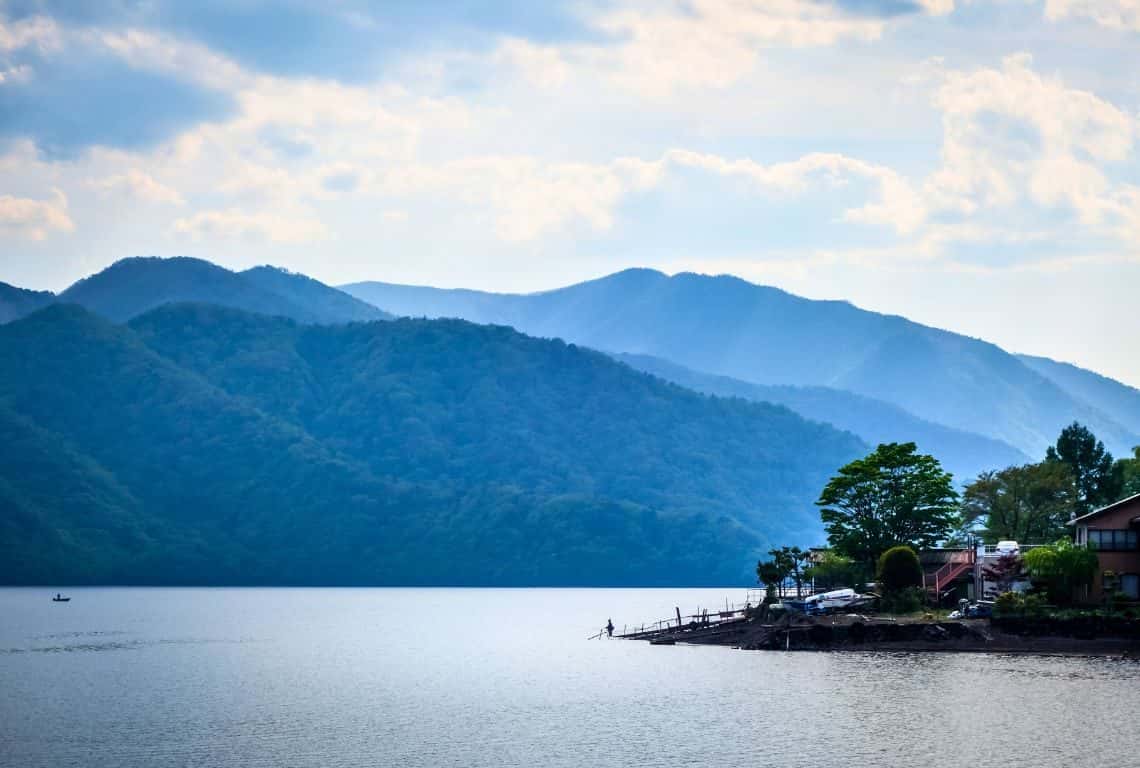
Lake Chuzenji in Nikko / 16-Day Japan Itinerary
Here are some of the top things to see and do in Nikko:
- Toshogu Shrine: This is the most famous attraction in Nikko and is a UNESCO World Heritage Site. It was built in the 17th century and is dedicated to Tokugawa Ieyasu, the founder of the Tokugawa shogunate.
- Futarasan Shrine: Another important shrine in Nikko, Futarasan Shrine is dedicated to the three sacred mountains of Nikko.
- Shinkyo Bridge: This is a beautiful red bridge that is located near the entrance of Nikko’s shrines and temples. It is considered one of the three most beautiful bridges in Japan.
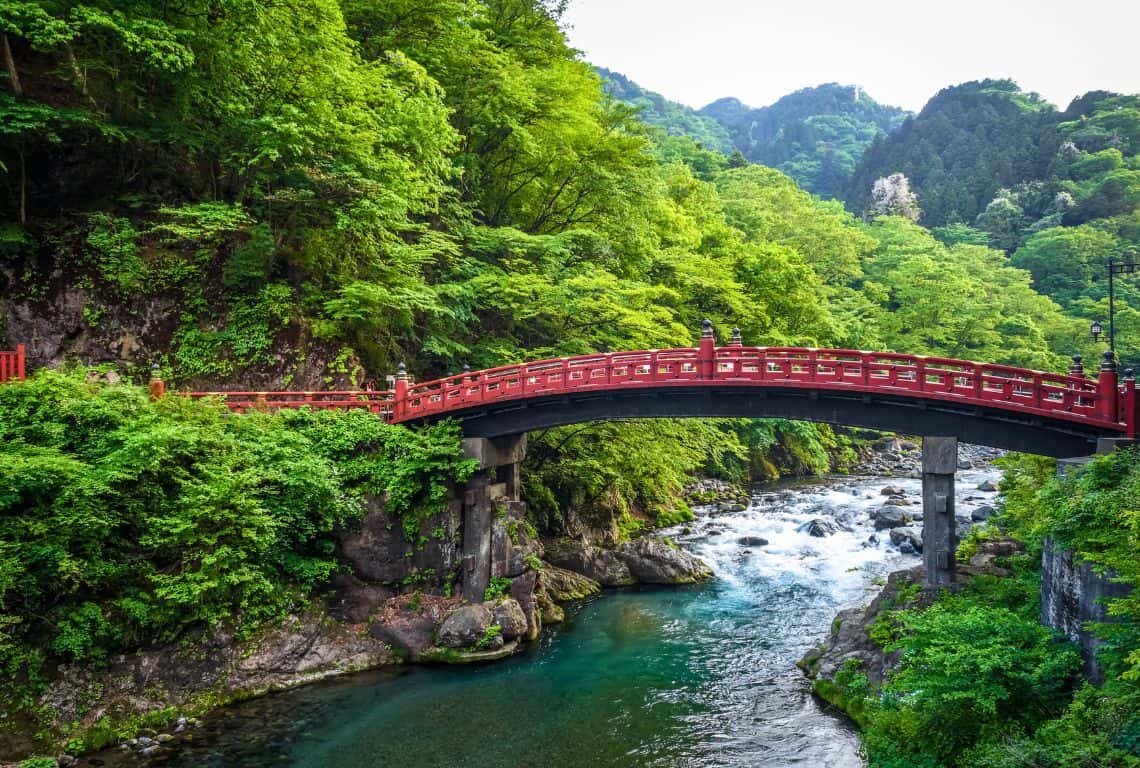
Shinkyo Bridge in Nikko / 16-Day Japan Itinerary
- Taiyuin Mausoleum: This is the mausoleum of Tokugawa Iemitsu, the third shogun of the Tokugawa shogunate.
- Lake Chuzenji: This is a beautiful lake in the mountains above Nikko. It is a popular spot for hiking, boating, and autumn leaf viewing.
- Kegon Falls: This is a spectacular waterfall that is located near Lake Chuzenji. It is one of the most famous waterfalls in Japan and is especially beautiful in the autumn.
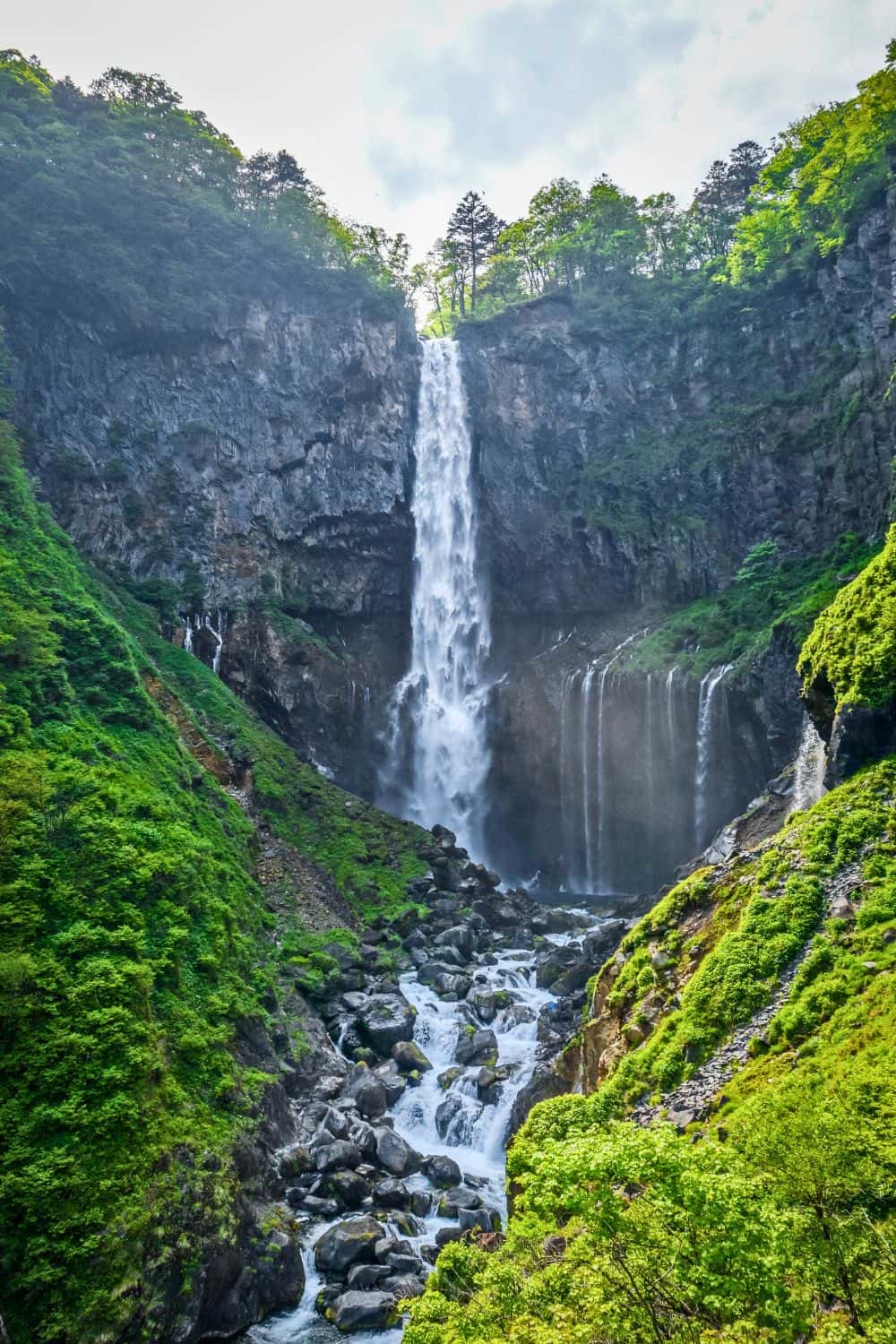
Kegon Falls in Nikko / 16-Day Japan Itinerary
- Taiyuin Mausoleum: This is the mausoleum of Tokugawa Iemitsu, the third shogun of the Tokugawa shogunate.
- Lake Chuzenji: This is a beautiful lake in the mountains above Nikko. It is a popular spot for hiking, boating, and autumn leaf viewing.
- Kanmangafuchi Abyss: This is a scenic gorge that is located on the outskirts of Nikko. It is known for its walking trails, old stone statues, and the sound of the river flowing through it.
DAY 6 - KYOTO
- Travel to Kyoto
- Settle Into Your Accommodations in Kyoto
- Explore Kyoto
1. Visit Fanous Fushimi Inari
Travel to Kyoto and How to Get Around in Kyoto
Today, you will say goodbye to Tokyo and travel to Kyoto. I am super excited to show you around Kyoto!
Kyoto, located in the Kansai region of Japan, is known for its rich history, culture, and natural beauty. With its iconic temples and shrines, traditional gardens, and delicious cuisine, Kyoto offers a glimpse into Japan’s past while also embracing modernity.
Whether you’re interested in exploring the city’s historic landmarks or simply strolling through its charming streets, Kyoto is a must-visit destination that offers a unique and unforgettable travel experience!
Before we dive into exploring Kyoto, here are some useful tips on how to get to Kyoto from Tokyo:
- If you are a JR Pass holder, then taking Shinkansen is the most popular and convenient way to travel from Tokyo to Kyoto. You can use the JR Pass to board the Hikari or Kodama trains on the Tokaido Shinkansen line. The journey takes approximately 2.5 hours and is covered by the JR Pass.
- You can also take limited express trains such as the Thunderbird or the Raichō, which run between Tokyo and Kyoto. These trains take longer than the Shinkansen but offer more scenic views of the countryside. The limited express trains may require seat reservations, which can be made at any JR ticket office.
Once you arrive in Kyoto, you might be wondering what is the best way to get around in Kyoto.
Kyoto is super easy to explore by public transport. The buses, trains, and subways will get you fast to all the amazing places you can’t miss on your first visit to Kyoto. And, there are always several ways of getting to a particular place.
If you want to explore Kyoto at a leisurely pace, then, hands down, walking and bicycling are awesome ways to see all the top sights in Kyoto as well.
- Kyoto’s Trains
Kyoto has 6 train lines and consists of the national JR Line and several local private lines. If you have a JR Rail Pass, then you will definitely want to use JR trains while you are exploring Kyoto!
You can download a free English-language PDF of Kyoto’s train system here.
- Kyoto’s Subway System
The Kyoto subway system is composed of two lines: The north-south Karasuma Line and the east-west Tozai Line. These two lines intersect in the middle of Kyoto, allowing you to transfer lines.
Make sure to download a free English-language PDF of Kyoto’s subway system here to help you navigate Kyoto by the subway system.
- Kyoto’s Bus System
The bus system is extensive in Kyoto is extensive, and honesty, you can get almost anywhere by bus in Kyoto.
Download Kyoto’s bus system map with Kyoto’s major attractions here.
From personal experience, I think you will find trains and subways easier to use especially if this is your first visit to Kyoto. However, once to take a bus a couple of times, you will be quite comfortable using it.
- Walking and Bicycling
If you want to explore Kyoto at a leisurely pace, then what you need to know is Kyoto is a delightful city to explore on foot. It is completely flat and the weather is pleasant most of the year.
If you like bicycling then, you are for a treat! In my opinion, Kyoto is one of the world’s great bike cities. It is super easy to rent a bike in Kyoto and my recommendation is that you check out the Kyoto Cycling Tour Project for the best prices and best quality bikes.
Another great option is to book Kyoto Bike Tour. This tour is about 7-8 hours long (you will be biking for about 25 miles) and takes you to Bamboo Forest (Arashiyama), Kiyomizu, Golden Pavilion, and Fushimi Inari, plus you get to explore the Gion neighborhood.
- Book a Tour
If you are not comfortable using Kyoto’s public transportation, then my recommendation is to book a small group tour. 10 Must-See Spots in Kyoto One-Day Private Tour is a perfect tour if you only have one day in Kyoto and do not want the stress of figuring out the logistics of public transportation.
Settle Into Your Accommodations (Best Places to Stay in Kyoto)
My recommendation is to stay in either Downtown Kawaramachi or around Kyoto Station. Here are a couple of places that I stayed at and I liked:
- Downtown Kawaramachi
The best area to stay in Kyoto is Downtown Kawaramachi. It offers plenty of restaurants and shops, and to top it off, it is just a walking distance of Gion.
My favorite place to stay is Kyoto Shijo Takakura Hotel Grandereverie. The location is perfect right in the heart of Kyoto (0.6 miles from Gion Shijo Station and a 15-minute walk from Kyoto International Manga Museum).
You will love everything about this place. The staff is so accommodating and extremely polite. The cleanliness of the rooms is top-notch. The breakfast is yummy and healthy.
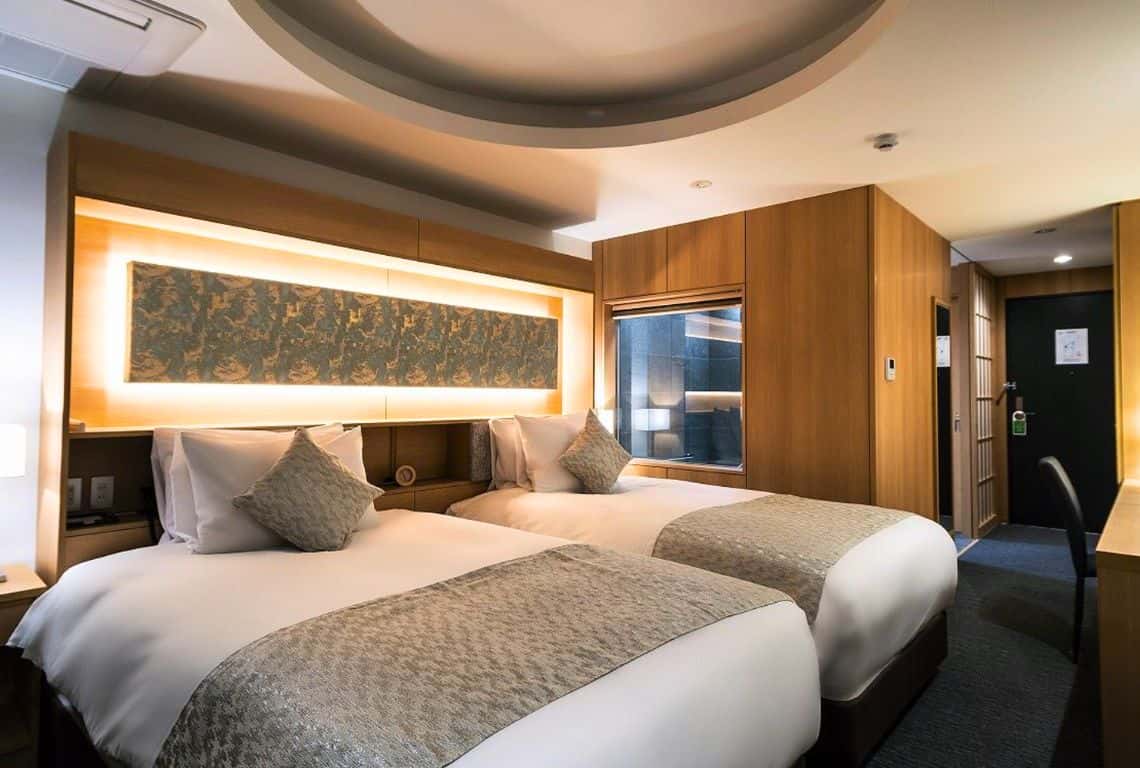
Kyoto Shijo Takakura Hotel Grandereverie / 16-Day Japan Itinerary
Another place that I want to recommend is Good Nature Hotel Kyoto. Again, great location: a 5-minute walk from Gion Shijo Station and 0.8 miles from Samurai Kembu Kyoto, 1.3 miles from Sanjusangen-do Temple, 1.4 miles from Kiyomizu-dera Temple, and 1.6 miles from TKP Garden City Kyoto.
Just an awesome hotel! You will love everything about it. The hotel is modern and beautifully designed. The rooms are super clean. The bedding and linens are always crisp and smell fresh. All the bath products are lovely and organic.
- Kyoto Station
Another excellent area to stay in Kyoto is anywhere around Kyoto Station. It is super convenient and all your public transportation options are in one spot.
The one place that I am recommending you check out is The Thousand Kyoto Hotel. The Thousand Kyoto Hotel is another one of my favorites! The location is awesome, with the absolute cleanliness, super comfy bed, and fresh, crisp linens, fabulous breakfast, professional staff that will go out of their way to make your stay comfortable, you cannot go wrong with booking this hotel.
- If Kyoto is fully booked, then start searching for hotels in Osaka. Kyoto is only less than an hour away from Osaka via train.
Venturing Through the Vibrant Gates of Fushimi Inari
Fushimi Inari Taisha is a sprawling complex of shrines and temples located on the Inari Mountian, in southern Kyoto.
The complex was founded in the 8th century and has since grown to include several sub-shrines, including the famous Senbon Torii, which is a network of thousands of torii gates that line the mountain trail.
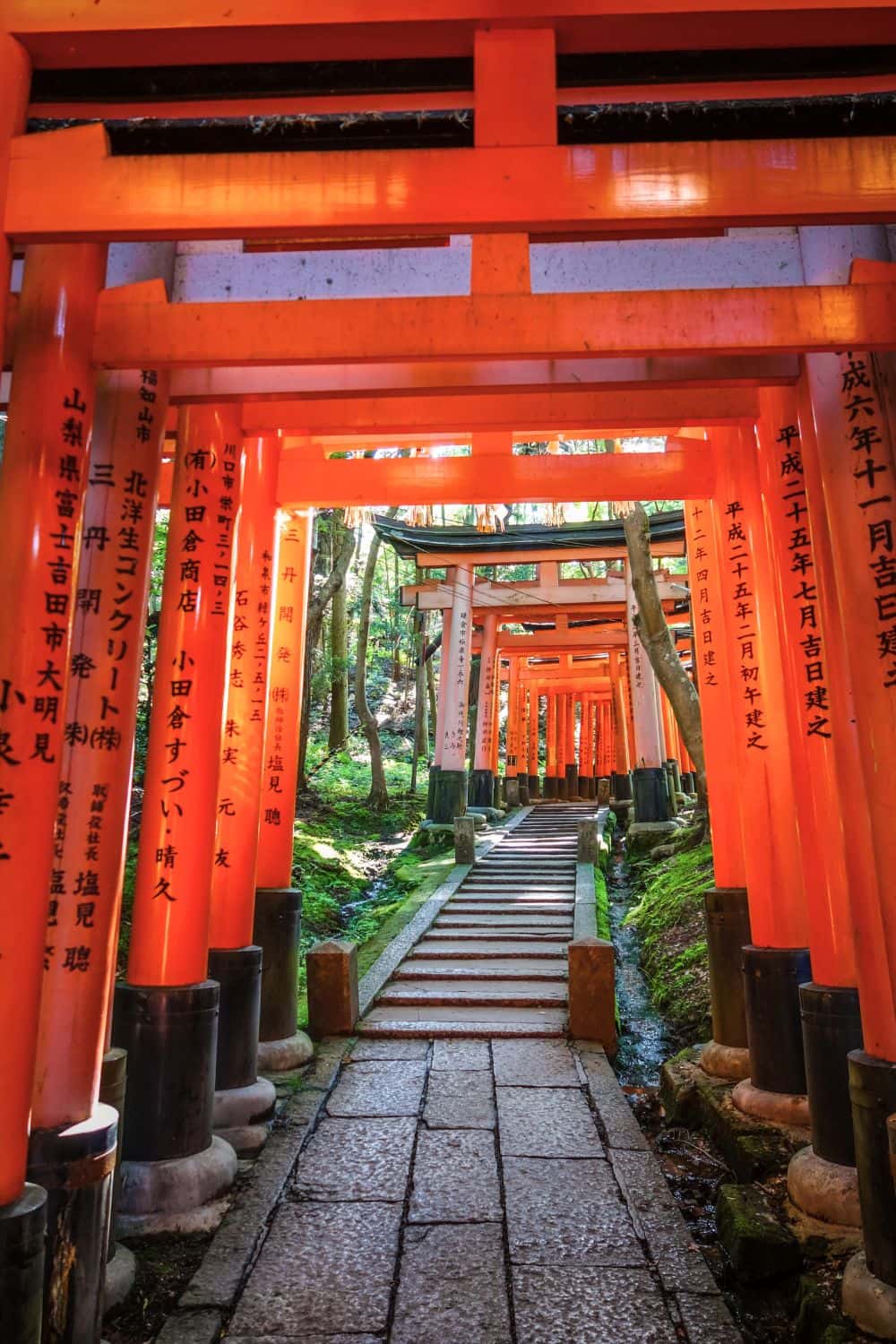
Fushimi Inari / 16-Day Japan Itinerary
The torii gates, which are painted a bright vermilion red, create a striking visual effect that contrasts against the natural beauty of the surrounding forest. The torii gates are donated by individuals and companies and have inscriptions on them that indicate the name of the donor and the date of the donation.
The experience of walking through the tunnels of bright vermillion torii gates is both mesmerizing and surreal, making it an essential destination for any traveler visiting Japan.
It takes about two hours to hike from the base of the mountain to the summit, but visitors can also choose to walk shorter segments of the trail. The view from the summit is breathtaking and offers a panoramic view of Kyoto city.
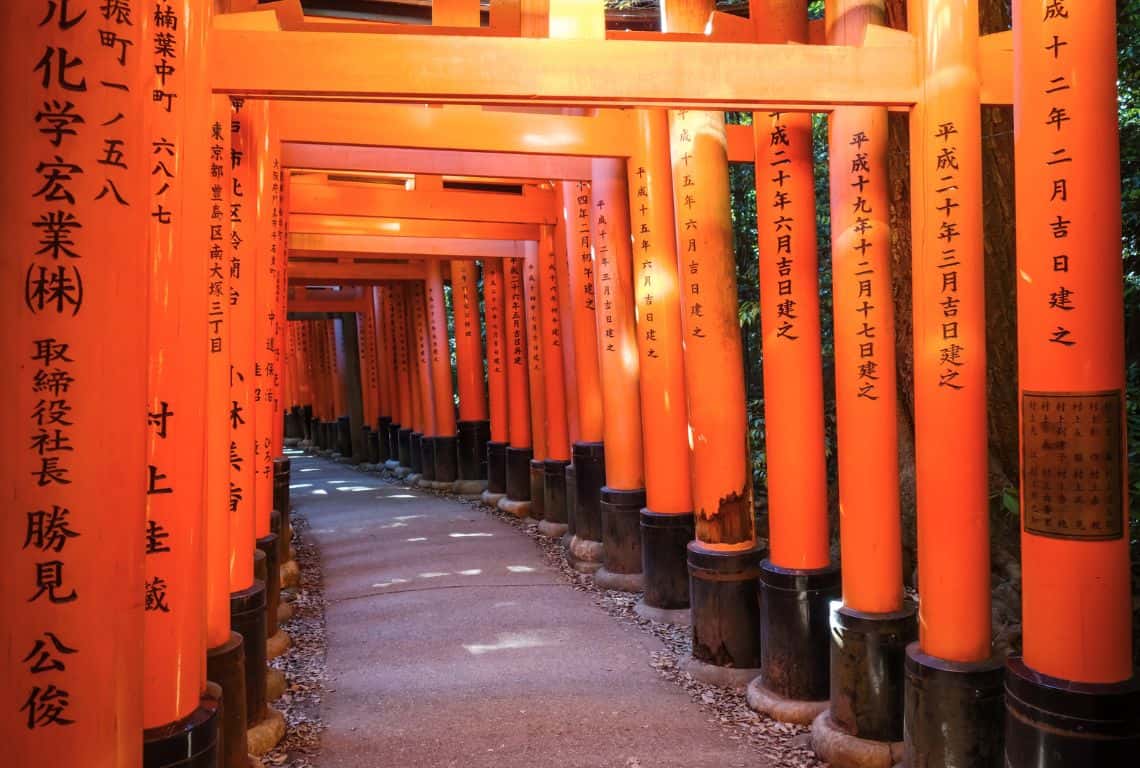
Fushimi Inari / 16-Day Japan Itinerary
In addition to the torii gates, Fushimi Inari is also known for its many stone foxes that are found throughout the complex. The fox is considered the messenger of Inari, and these statues are a symbol of the shrine’s connection to the god.
You can also find various shrines and temples throughout the complex, each dedicated to different aspects of Inari’s worship, such as agriculture, prosperity, and good health.
Fushimi Inari is particularly breathtaking during the autumn months when the leaves turn fiery red and gold, providing a picturesque backdrop for any photographs.
Whether you are a photographer, hiker, or simply interested in exploring the unique culture and history of Japan, a visit to Fushimi Inari is a must-do activity that will leave you with unforgettable memories!
This concludes the first day of exploring Kyoto. It is time to get back to your hotel and get a good night’s rest!
DAY 7 - KYOTO
- Explore Kyoto
1. Kiyomizu-dera
2. Sanjusangento Temple
3. Gion
Discover the Stunning Kiyomizudera Buddhist Temple
Kiyomizudera, a UNESCO World Heritage Site, is one of Kyoto’s most iconic landmarks. It is also known as the “Pure Water Temple.”
The temple, which dates back to the 8th century, is famous for its impressive wooden stage that protrudes out over the hillside, offering breathtaking views of the surrounding area.
The main hall of the temple, the Hondo, is a designated National Treasure of Japan and is supported by 139 pillars.
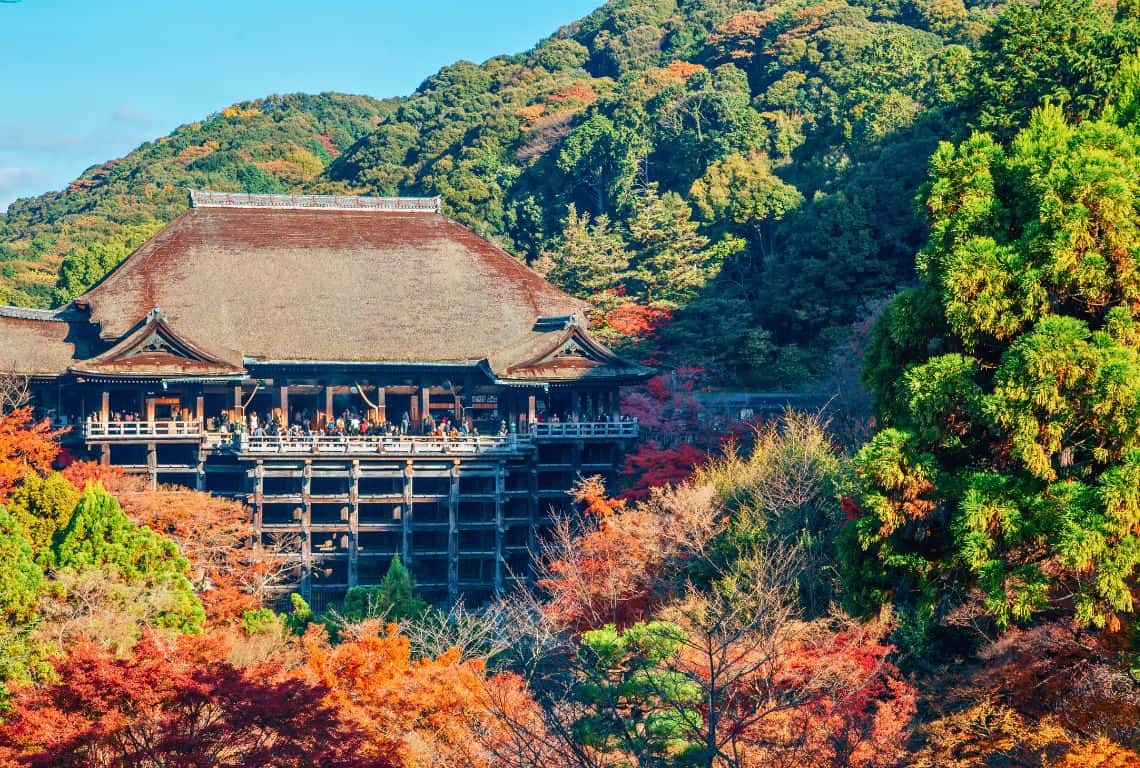
Kiyomizudera in Kyoto / 16-Day Japan Itinerary
One of the most popular aspects of Kiyomizudera is the Otowa Waterfall, where you can drink from one of three streams of water that are believed to have different benefits: success in school, success in love, and longevity.
The temple grounds are also home to several other buildings, including the Jishu Shrine, a shrine dedicated to the god of love and matchmaking. Here, you can participate in a traditional ritual of walking between two stones with your eyes closed, which is believed to bring good luck in love.
Kiyomizudera is particularly stunning during the spring cherry blossom and fall foliage seasons when the temple and its surroundings are bathed in a riot of colors.
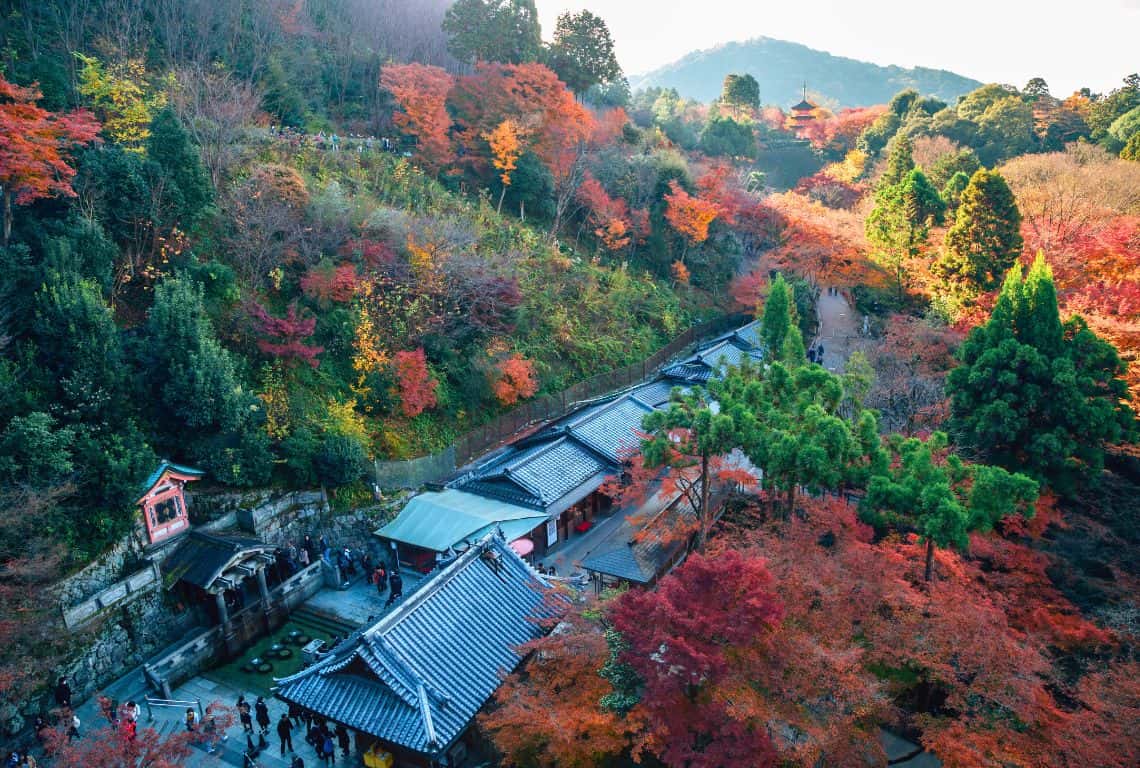
Kiyomizudera in Kyoto / 16-Day Japan Itinerary
Here is a list of things you should not miss at Kiyomizudera:
- Main Hall (Hondo) – The main hall of the temple, which features a large veranda supported by wooden pillars.
- Jishu Shrine – A small shrine on the temple grounds dedicated to the god of love and matchmaking.
- Otowa Waterfall – A three-streamed waterfall where visitors can drink from one of the streams, which is said to bring health, longevity, and success in studies.
- Okunoin Hall – A smaller hall located behind the main hall, which contains a statue of the deity of mercy, Kannon.
- Three-story Pagoda – A pagoda located on the temple grounds that is a symbol of Kiyomizudera and Kyoto.
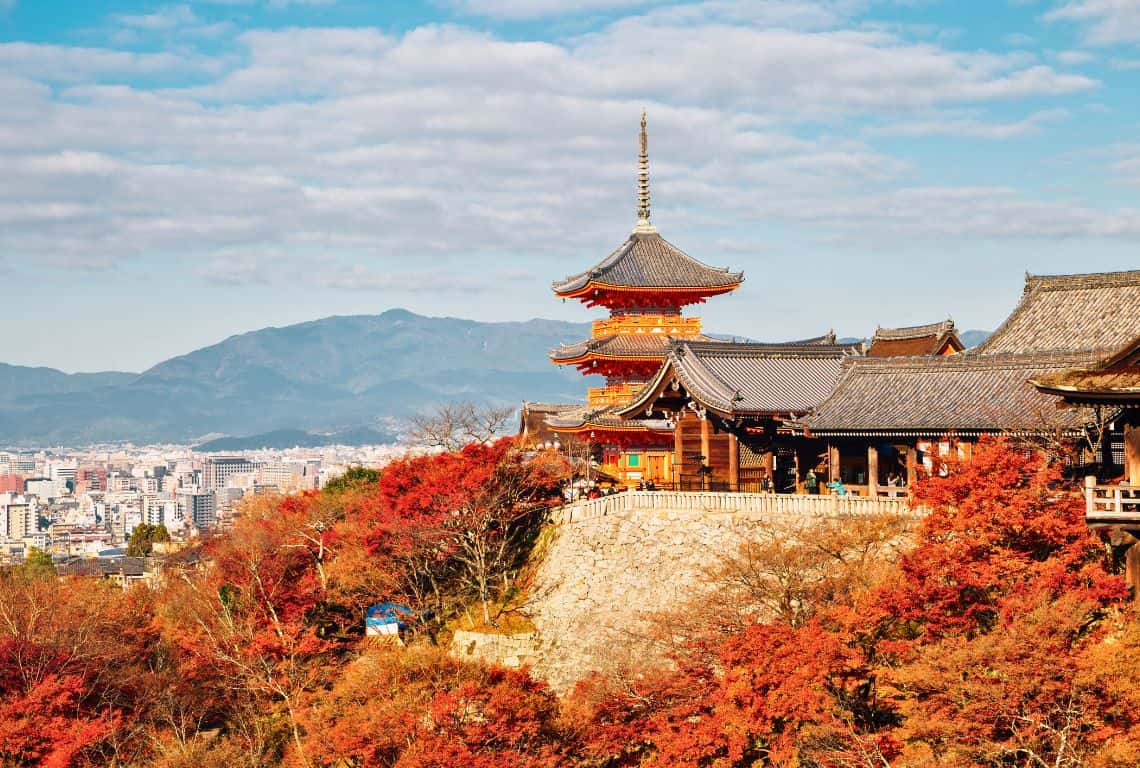
Kiyomizedara in Kyoto / 16-Day Japan Itinerary
- Nio-mon Gate – A large wooden gate with two guardian statues located at the entrance of the temple.
- Sannenzaka and Ninenzaka – Traditional streets lined with souvenir shops, restaurants, and tea houses, which lead up to the temple.
- Night Illumination – During special events, the temple is illuminated at night, creating a magical atmosphere.
Sanjusangen-do Temple
Sanjusangen-do is a Buddhist temple that was founded in the 12th century by the powerful emperor Go-Shirakawa.
The temple’s name, which translates to “Hall of 33 Bays,” refers to the number of bays in the temple’s main hall.
One of the main attractions of Sanjusangen-do is the temple’s main hall, which houses a stunning display of 1,001 life-sized wooden statues of the goddess of mercy, Kannon. The hall is also the longest wooden structure in Japan, measuring at 120 meters long.
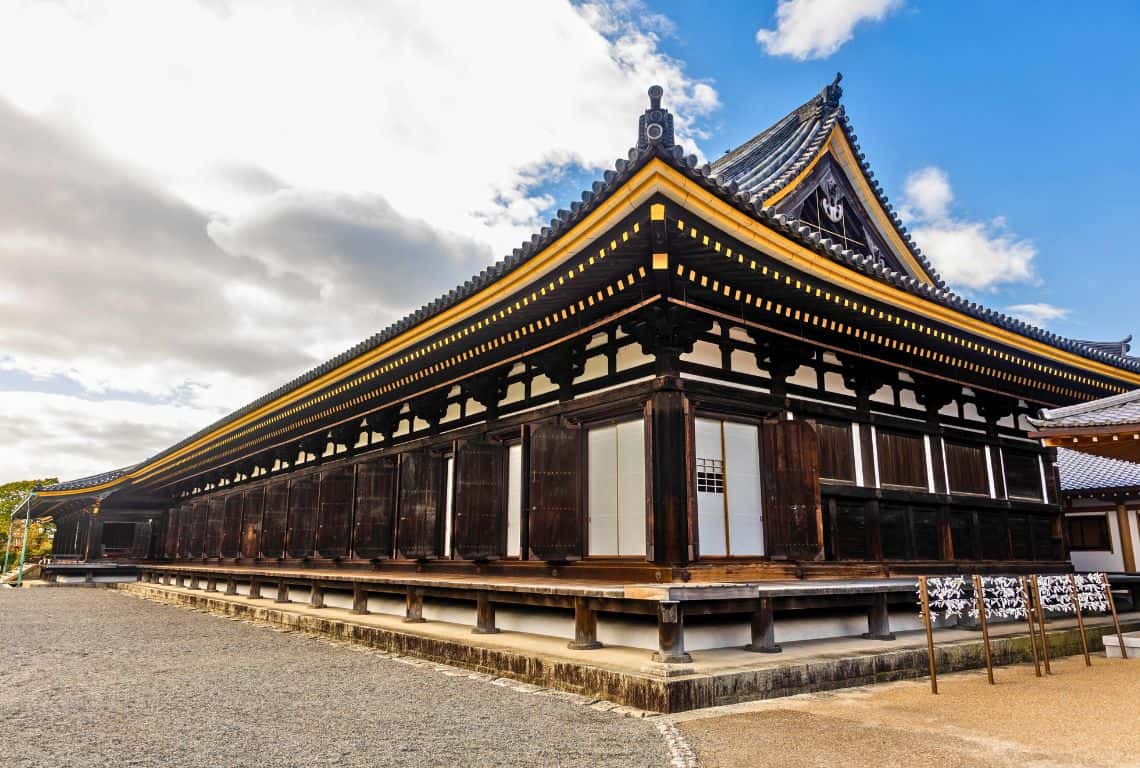
Sanjusangen-do Temple in Kyoto / 16-Day Japan Itinerary
The statues are arranged in 10 rows, with the central row consisting of 11 larger statues representing Kannon and her attendants.
You can walk along the rows of statues and admire their intricate details and the peaceful ambiance of the hall. Just keep in mind, that photography is not allowed!
In addition to the impressive statue display, Sanjusangendo is also home to a beautiful garden.
The garden features a pond, walking paths, and several picturesque spots that offer stunning views of the temple’s architecture and surrounding natural scenery.
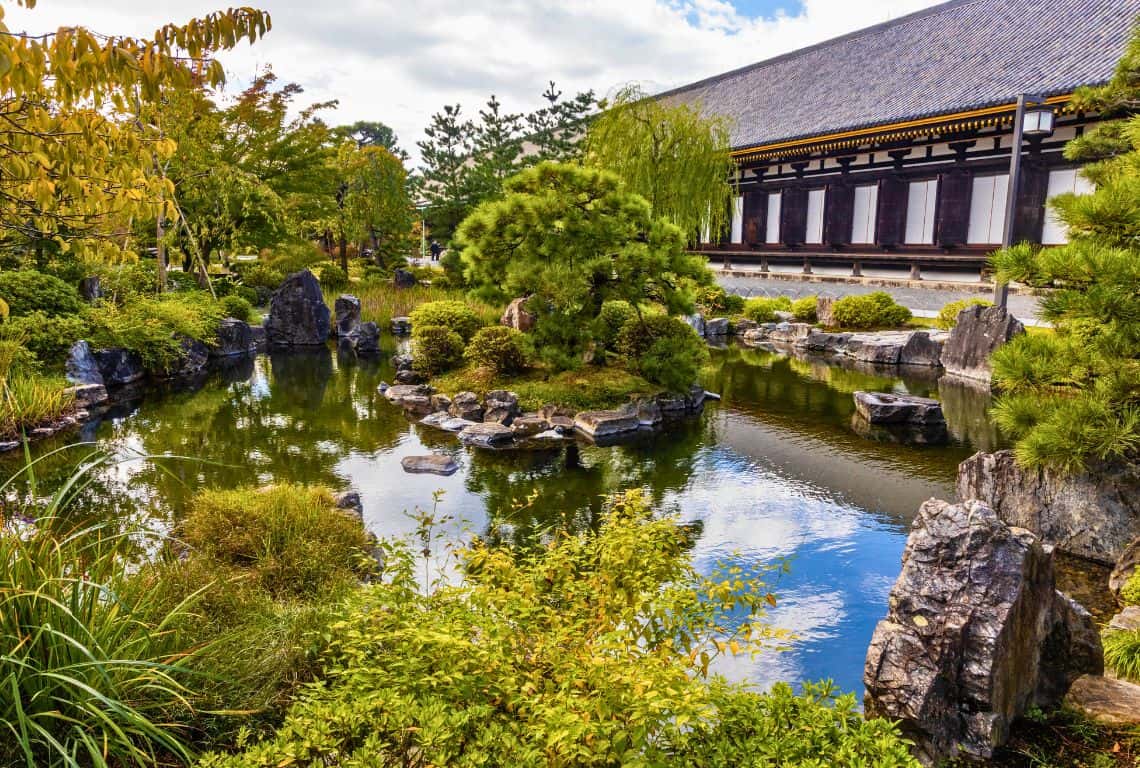
Sanjusangen-do Temple in Kyoto / 16-Day Japan Itinerary
Discover Gion by Night: Kyoto's Most Enchanting Geisha District
Gion is a historic district in Kyoto that is known for its traditional architecture, teahouses, and geisha culture.
The district is home to many preserved buildings and streets that date back to the Edo period, as well as several famous landmarks, such as the Yasaka Shrine and the Kennin-ji Temple.
Yasaka Shrine is located at the eastern end of Shijo-dori. It is one of the most famous shrines in Kyoto. It is known for its bright orange gate and lanterns and is a popular spot for visitors to take photos.
Kennin-ji Temple is a historic temple that was founded in 1202 and is the oldest Zen temple in Kyoto. It features a beautiful garden and several impressive works of art.
Gion is most famous for its geisha or geiko (in Kyoto dialect) culture. Geisha are highly trained female entertainers who specialize in various arts such as dance, music, and conversation. They are often seen walking the streets of Gion, wearing traditional attire and makeup, on their way to perform at a teahouse or private party.
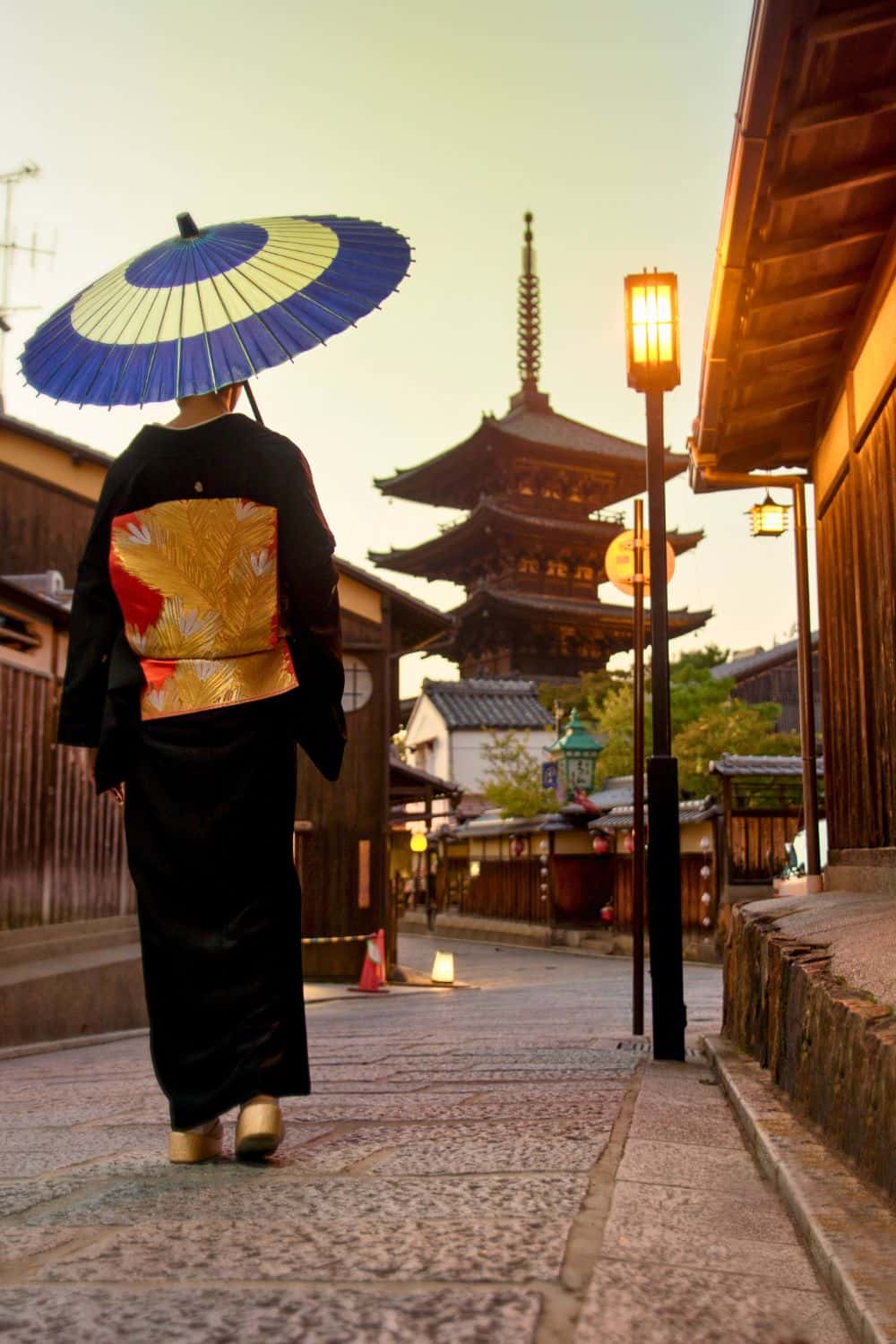
Gion / 16-Day Japan Itinerary
You can experience the traditional Japanese culture by walking down Hanami-koji, a famous street lined with old teahouses, restaurants, and shops. It is a great place to stroll and admire the traditional architecture of the area.
There are many great places to eat in Gion, Kyoto. Here are some recommendations:
- Gion Kappa specializes in traditional Kyoto cuisine, including kaiseki, a multi-course meal featuring seasonal ingredients. The restaurant is located in a historic building with a beautiful garden.
- Gion Nanba serves traditional Japanese dishes, including sushi and tempura.
- Kinmata is a traditional Japanese teahouse that has been in business for over 300 years and is known for its beautiful interior and delicious Japanese sweets.
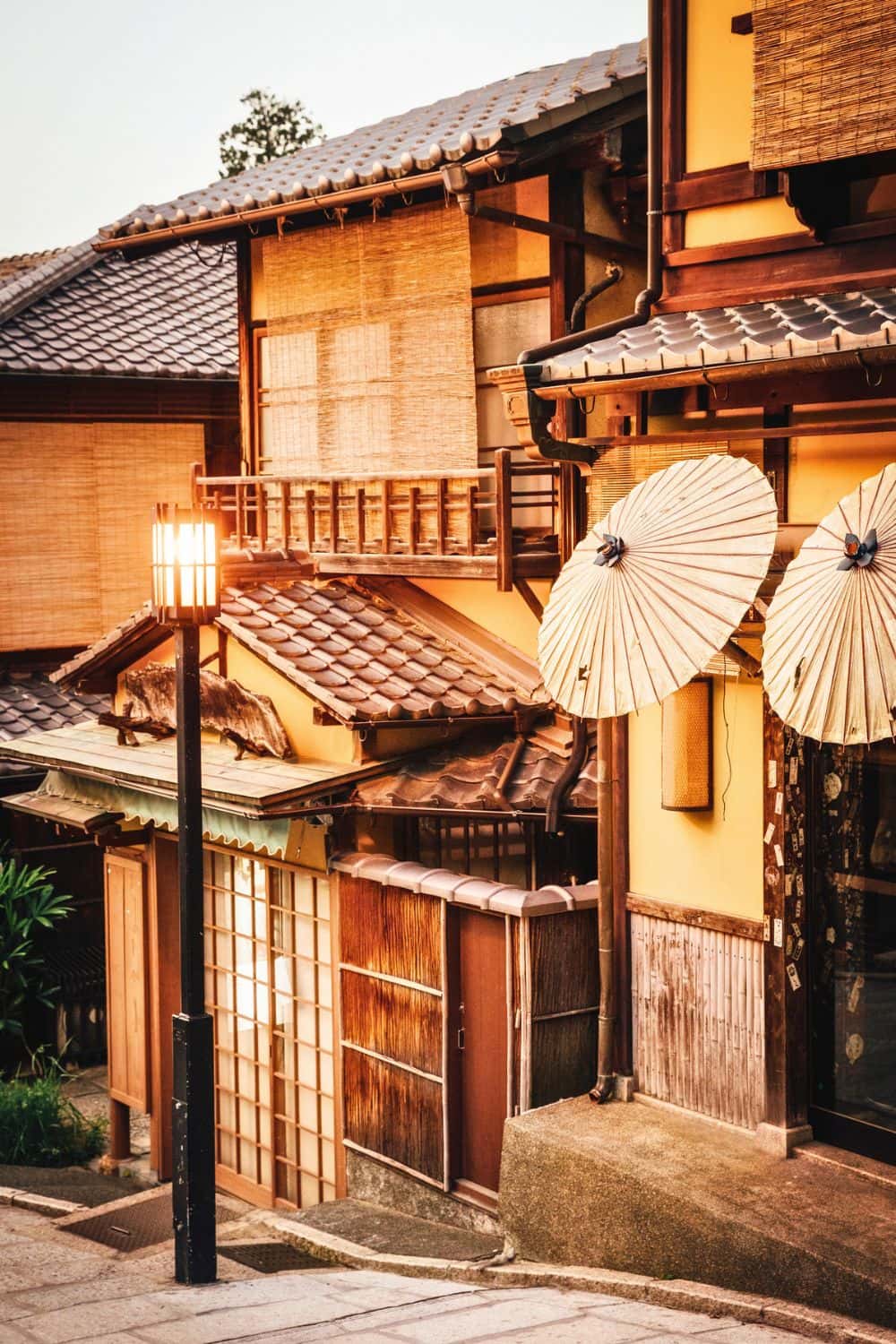
Gion / 16-Day Japan Itinerary
A visit to Gion concludes day 7 of the 16-day Japan itinerary. It is time now to head back to your hotel and get some rest. There is another exciting day ahead of you!
DAY 8 - KYOTO
- Explore Kyoto:
1. Golden Pavilion
2. Arashiyama
Experience Kinkaku-ji: The Jewel of Kyoto's Temple Treasures
The Golden Pavilion, also known as Kinkaku-ji, is one of the most iconic and popular temples in Kyoto.
The temple is famous for the stunning golden facade that reflects off the pond in front of it, creating a picturesque view that is simply breathtaking.
Originally built as a retirement villa for shogun Ashikaga Yoshimitsu in the late 14th century, the building was later converted into a Zen temple after his death.
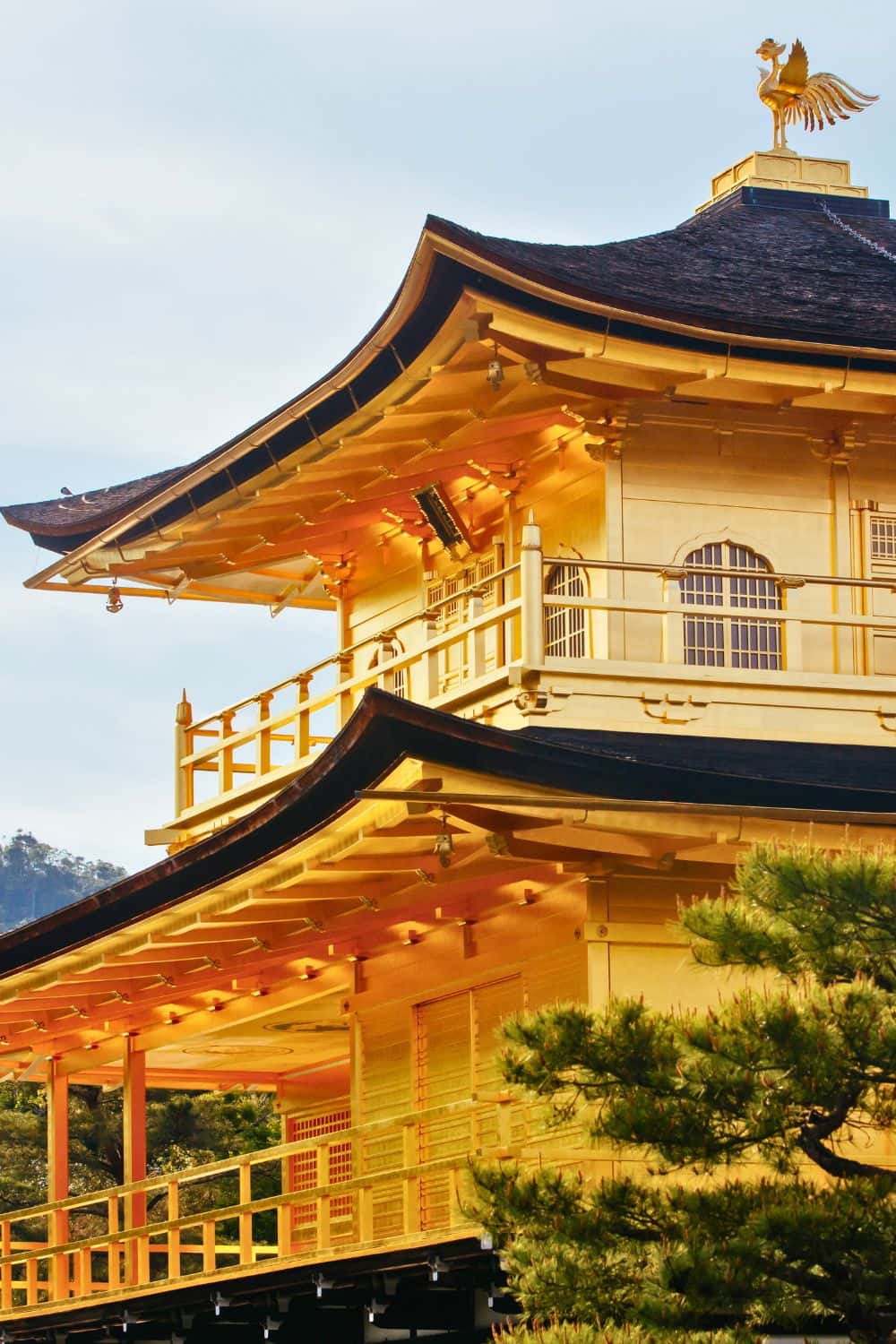
Golden Pavilion / 16-Day Japan Itinerary
In 1950, the pavilion was burned down by a mentally ill monk, and the current structure was rebuilt five years later.
The top two floors of the temple are covered in gold leaf, giving the building its iconic shimmering appearance. and feature different architectural styles, representing different periods in Japanese history.
You can walk around the temple’s beautiful gardens, admire the views, and learn about the temple’s fascinating history.
Afternoon Trip to Arashiyama
Hands down, Arashiyama is my favorite place to escape the hustle and bustle of Kyoto and enjoy some picturesque natural beauty!
The area is known for the famous Arashiyama Bamboo Grove, which features a towering forest of bamboo stalks that sway gently in the wind. You can also explore the district’s many temples and shrines, such as the UNESCO World Heritage Site of Tenryu-ji Temple, as well as the scenic Togetsukyo Bridge that spans the Katsura River.
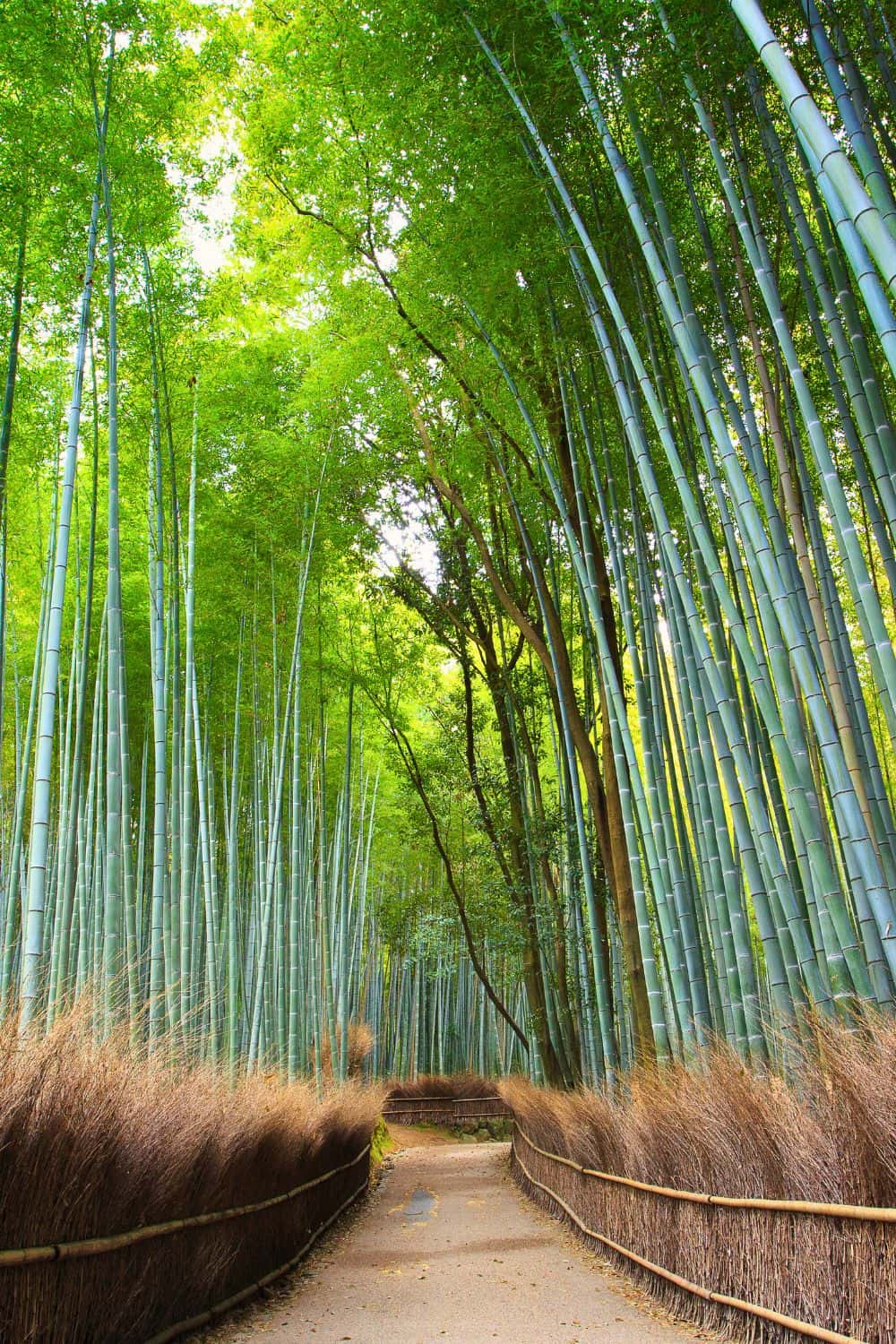
Arashiyama Bamboo Grove / 16-Day Japan Itinerary
Here are some things that you should not miss in Arashiyama:
- Take a stroll through the famous Arashiyama Bamboo Grove and admire the towering stalks.
- Explore Tenryu-ji Temple, a UNESCO World Heritage Site with a beautiful Zen garden and pond.
- Admire the Togetsukyo Bridge, a landmark of Arashiyama that offers stunning views of the surrounding mountains and the Hozu River.
- Visit the Iwatayama Monkey Park which is home to over 170 Japanese macaques.
- Visit the Otagi Nenbutsu-ji Temple known for its 1,200 moss-covered statues of rakan, or Buddhist disciples.
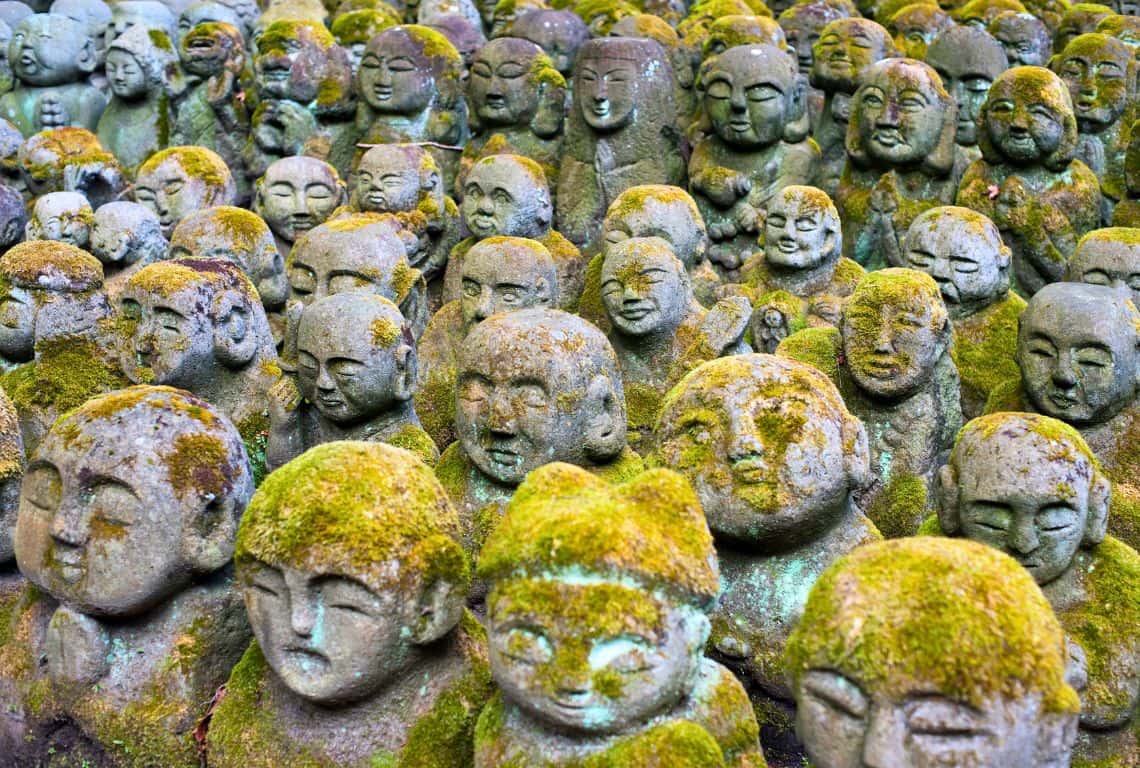
Otagi Nenbutsu-ji Temple / 16-Day Japan Itinerary
DAY 9 - KYOTO
- Explore Kyoto:
1. Nijo Castle
2. Nishiki Market
3. Philospher’s Walk
4. Pontocho
Tour Nijo Castle and Discover Its Secrets
Touring Nijo Castle in Kyoto is an immersive experience that will take you back in time to Japan’s feudal era.
The castle, which was built in 1603, served as the residence of the Tokugawa Shoguns and was later used by the Imperial family during their visits to Kyoto.
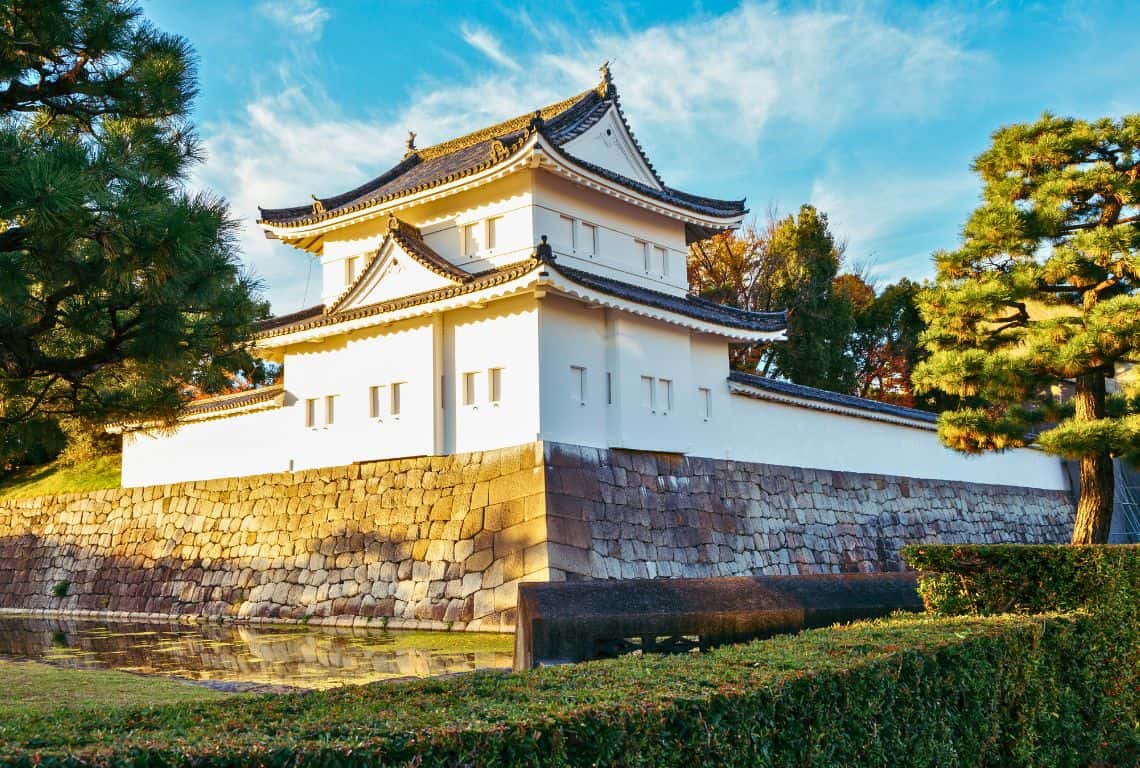
Nijo Castle / 16-Day Japan Itinerary
One of the castle’s most intriguing features is its “nightingale floors.” These floors are designed to chirp like birds when walked on, creating a distinct sound that was meant to serve as a warning against potential assassins. You can listen to the chirping sound as you walk along the corridors.
The castle’s walls are adorned with intricate paintings and decorations, including depictions of animals and nature scenes. These paintings were meant to convey messages of power and prestige, as well as to showcase the beauty of Japanese art.
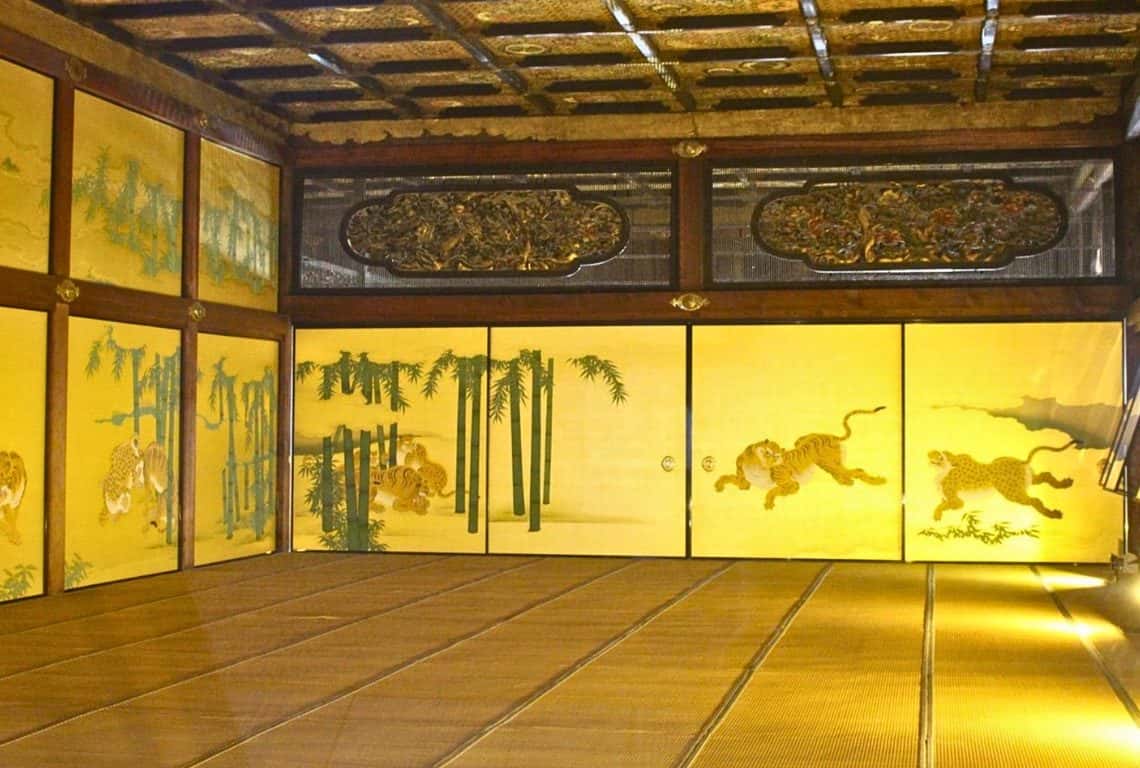
Wall Paintings at Nijo Castle / 16-Day Japan Itinerary
Nijo Castle features a “hidden room” where guards could hide during times of danger. The room is located behind a secret door that can only be accessed through a hidden passage.
The castle’s gardens are a must-see attraction, featuring meticulously manicured lawns, ponds, and walking paths. The gardens are designed to reflect traditional Japanese landscaping techniques and are particularly beautiful during the spring and autumn seasons.
Nijo Castle’s stunning architecture and historical significance have made it a popular filming location for movies. It has appeared in films such as “The Last Samurai” and “Memoirs of a Geisha.”
Savor Kyoto's Culinary Delights: A Tour of Nishiki Market
Nishiki Market, known as “Kyoto’s Kitchen,” is a bustling covered market located in the heart of Kyoto. It is a must-visit destination for foodies and anyone interested in experiencing Kyoto’s rich culinary culture. The market features over 100 shops and stalls selling a wide range of fresh and local produce, traditional Japanese snacks, seafood, meats, and spices.
One of the highlights of Nishiki Market is the opportunity to taste a variety of traditional Japanese snacks and street food.
Here are a few popular options that you might want to sample:
- Tsukemono (pickled vegetables): Nishiki Market has a wide selection of pickled vegetables, including daikon radish, cucumber, and eggplant. They are a great accompaniment to many Japanese meals.
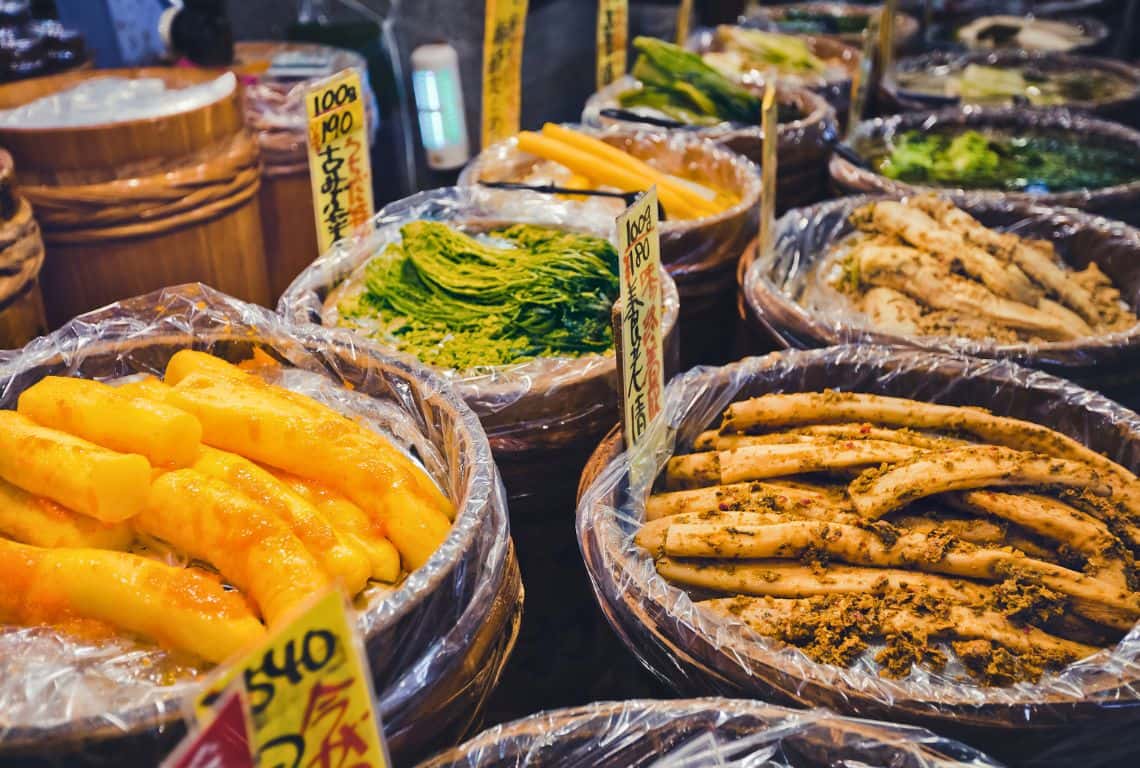
Tsukemono (pickled vegetables) at Nishiki Market / 16-Day Japan Itinerary
- Katsuobushi (dried and smoked bonito flakes): This flavorful ingredient is used in many Japanese dishes, and you can find it freshly shaved and served over a variety of dishes at the market.
- Yakitori (grilled chicken skewers): These savory skewers of chicken grilled over an open flame are popular street food in Japan, and you can find them at many of the food stalls in Nishiki Market.
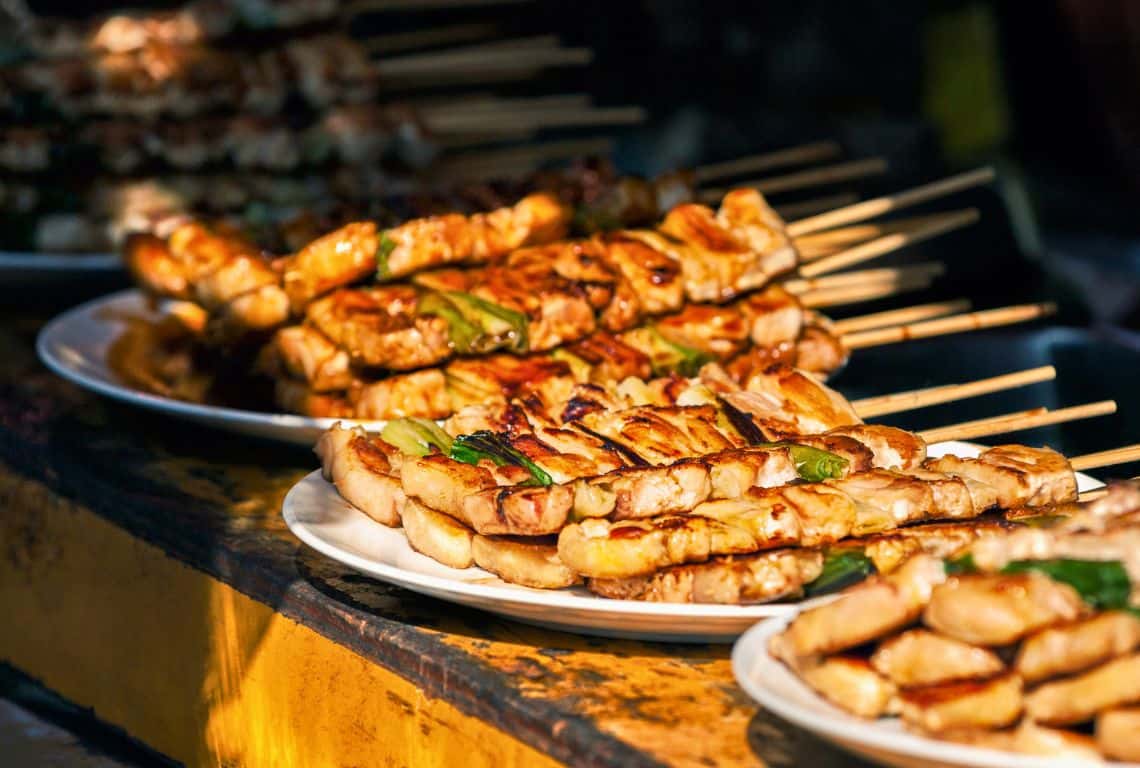
Yakitori (grilled chicken skewers) at Nishiki Market / 16-Day Japan Itinerary
- Taiyaki (fish-shaped cakes filled with sweet bean paste): These cute and tasty cakes are popular street food in Japan, and Nishiki Market has a number of stalls selling them. They are perfect for a sweet snack on the go!
- Mochi (sweet rice cakes): These soft, chewy rice cakes are a traditional Japanese sweet. They come in a variety of flavors, such as green tea and red bean, and are often served fresh and warm.
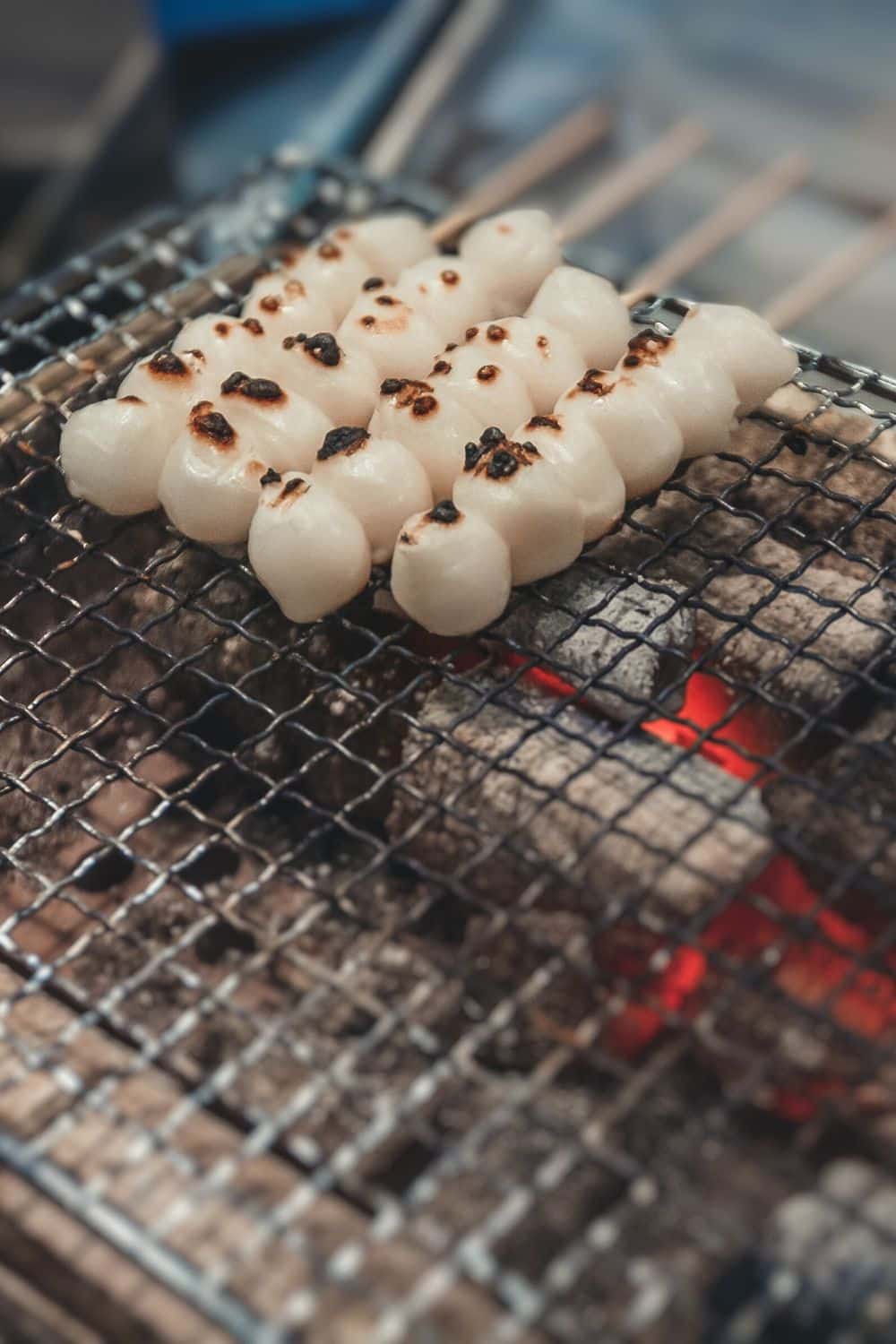
Mochi at Nishiki Market / 16-Day Japan Itinerary
Explore Kyoto's Famous Philosopher's Walk
The Philosopher’s Walk is a picturesque 2-kilometer stone path that starts at the Nyakuoji Bridge and ends at the Ginkaku-ji Temple. It runs alongside Shirakawa Canal lined with cherry trees in the northern part of Kyoto.
The path is named after the famous philosopher and Kyoto University professor, Nishida Kitaro, who was said to walk the path daily while contemplating his ideas.
Along the way, you can enjoy the beautiful scenery of cherry blossoms in spring and colorful autumn leaves in fall.
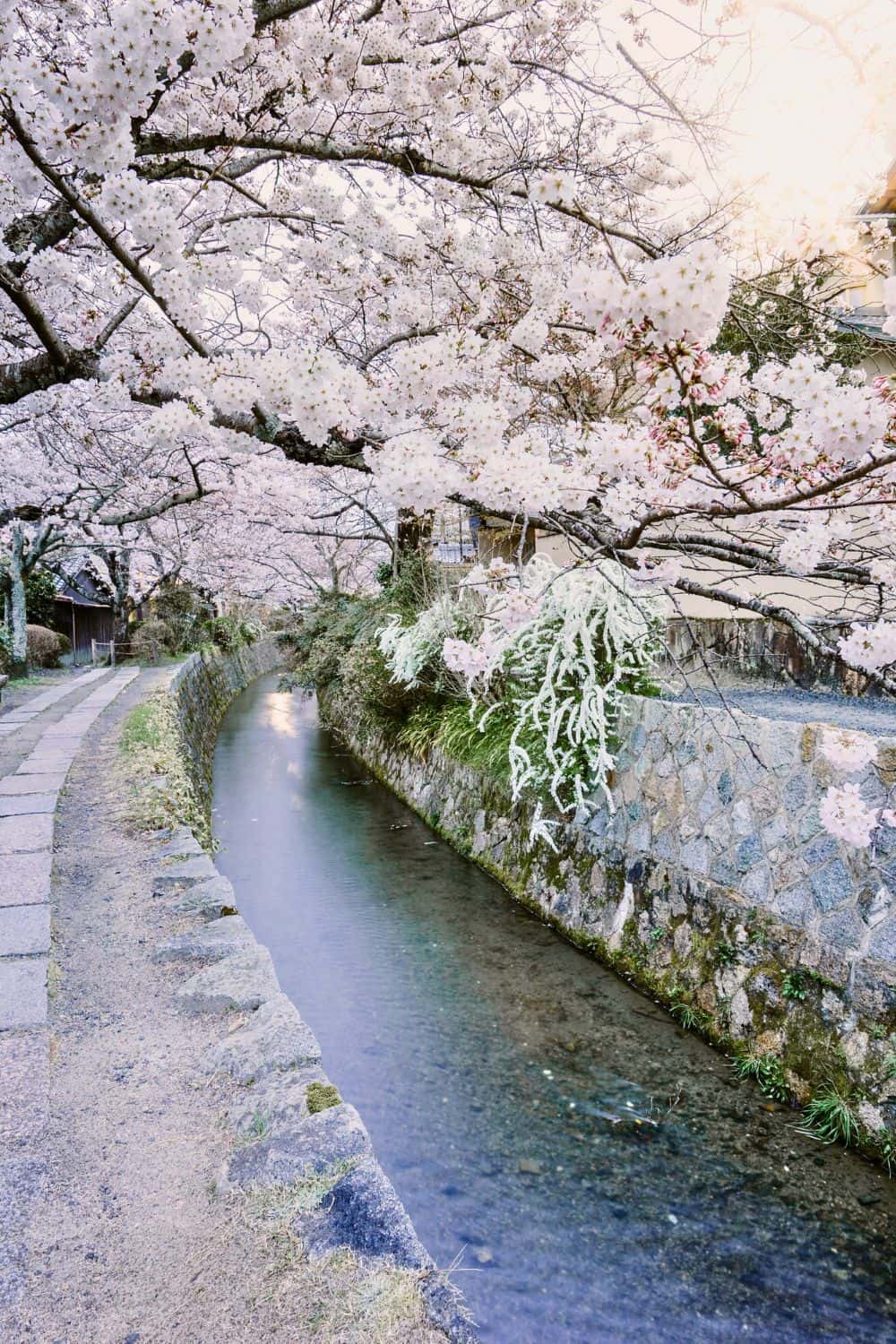
Philosopher’s Walk / 16-Day Japan Itinerary
There are also several temples and shrines to see, including the Ginkaku-ji Temple, also known as the Silver Pavilion.
The Ginkaku-ji Temple was originally built as a retirement villa for a shogun but was later converted into a Zen temple. The temple’s gardens are renowned for their beauty and are a great place to relax and take in the scenery.
Another temple that can be visited along the Philosopher’s Walk is the Eikan-do Temple, which is known for its autumn foliage. The temple’s main hall houses a famous statue of Amida Buddha, which is said to have been carved by the famous sculptor Jocho in the 11th century.
The path also passes by several small shops, cafes, and restaurants, making it a great place to stop and rest or grab a bite to eat.
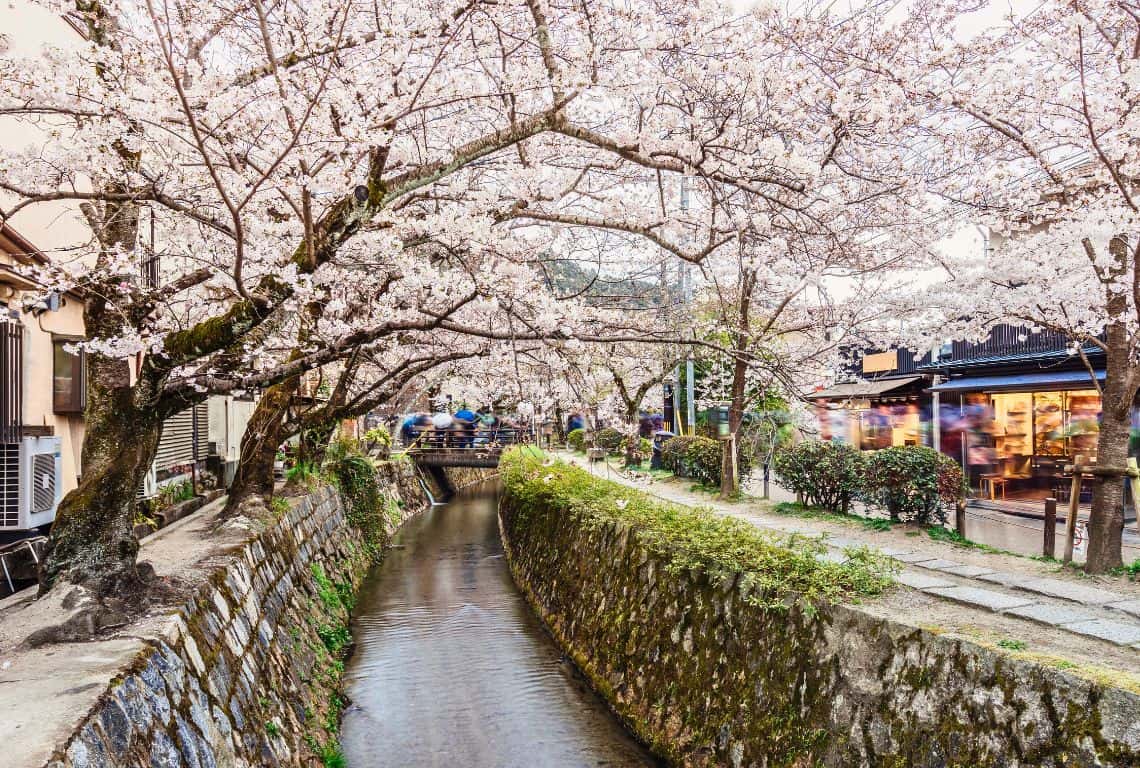
Philosopher’s Walk / 16-Day Japan Itinerary
Discover Pontocho: Kyoto's Enchanting Alley of Geisha and Izakaya
Pontocho is a narrow alleyway that runs along the Kamo River in Kyoto. The alleyway is famous for its traditional wooden buildings, lantern-lit walkways, and a variety of dining options.
It is believed that Pontocho originated in the Middle Ages, during the Muromachi Period, as a small entertainment district for the wealthy merchant class of Kyoto. Over time, it evolved into a bustling hub of restaurants, bars, and geisha houses, where people could come to relax, eat, drink, and be entertained.
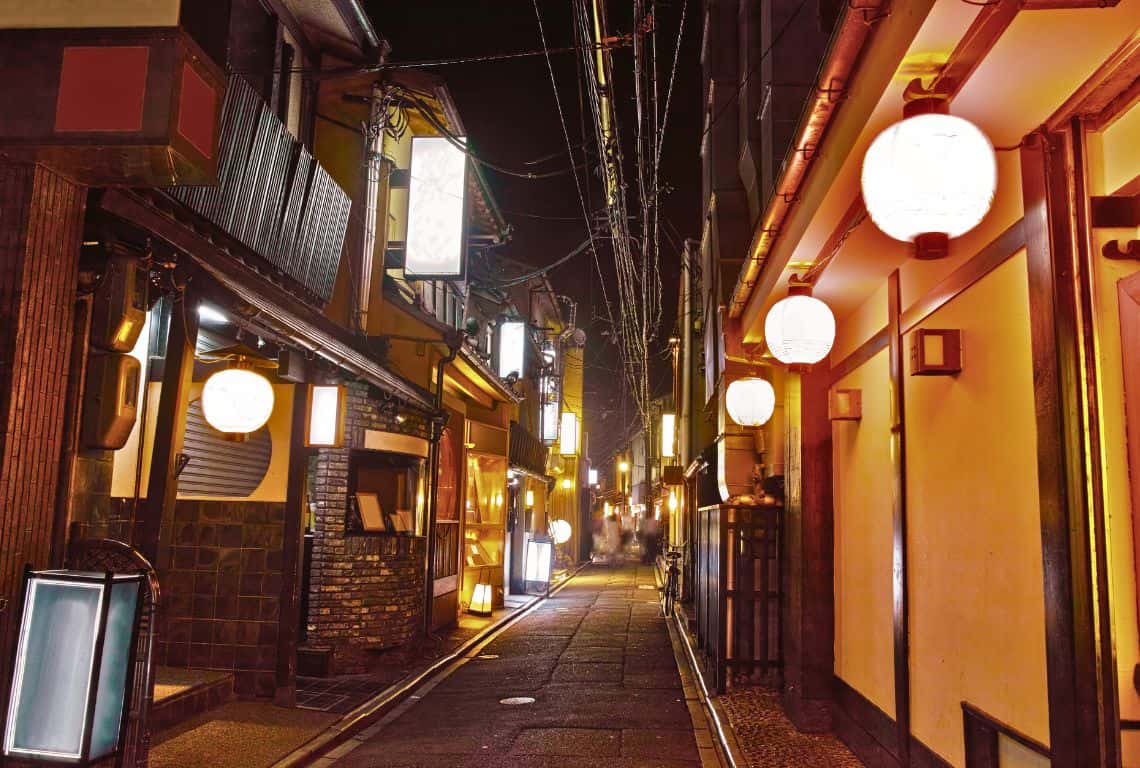
Pontocho in Kyoto / 16-Day Japan Itinerary
Today, Pontocho is still home to many geisha and maiko, and you may be lucky enough to catch a glimpse of these traditional performers in their beautiful kimonos and makeup as they move between appointments.
One of the main draws of Pontocho is its izakaya culture. Izakaya are Japanese-style pubs that serve a variety of small plates of food and drinks. They are a popular spot for locals to unwind after work or meet up with friends for a casual night out. Izakaya menus often feature traditional Japanese dishes like sashimi, yakitori (grilled chicken skewers), and tempura, as well as a range of alcoholic beverages like sake, shochu, and beer.
Many of the izakayas in Pontocho are housed in historic buildings with traditional decor, and some even have riverside terraces that offer stunning views of the Kamogawa River.
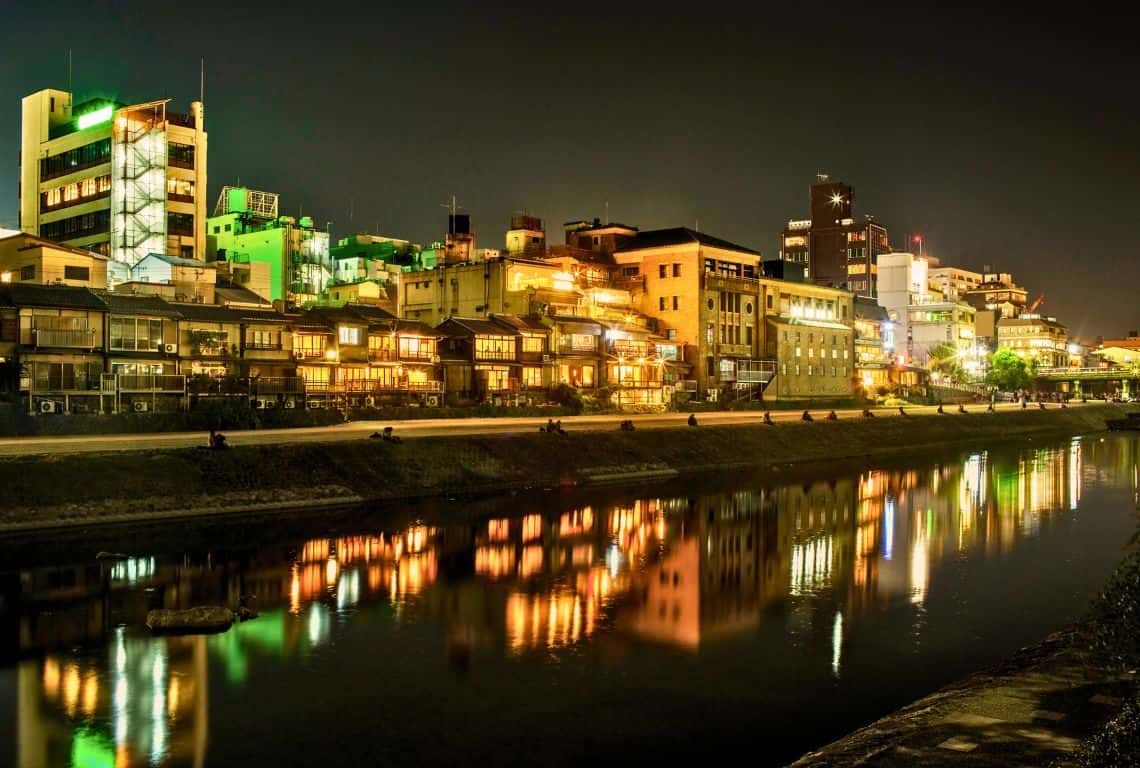
Pontocho View from the Kamu River / 16-Day Japan Itinerary
During the summer months, Pontocho becomes even more lively with its “yuka” dining, where restaurants set up outdoor dining platforms over the river, creating a unique and romantic atmosphere.
Summer is also a time when the Pontocho Kaburenjo Theater Festival starts. This festival features traditional Japanese theater performances such as kabuki and kyogen, as well as geisha and maiko dance performances.
This concludes your exploration of Kyoto and now it is time to venture out for a couple of day trips from Kyoto, as well as attend the famous Japanese Tea Ceremony! Let’s go!
DAY 10 - DAY TRIP TO KANAZAWA FROM KYOTO
- Day Trip to Kanazawa from Kyoto
Day Trip to Kanazawa from Kyoto
Kanazawa is a city that exudes charm and character.
With a rich cultural heritage, stunning architecture, and beautifully manicured gardens, a day trip to Kanazawa from Kyoto is a must for any visitor to Japan. So why not escape the hustle and bustle of Kyoto and discover Kanazawa’s hidden gems? Let’s go on a day trip to Kanazawa from Kyoto and explore this delightful city!
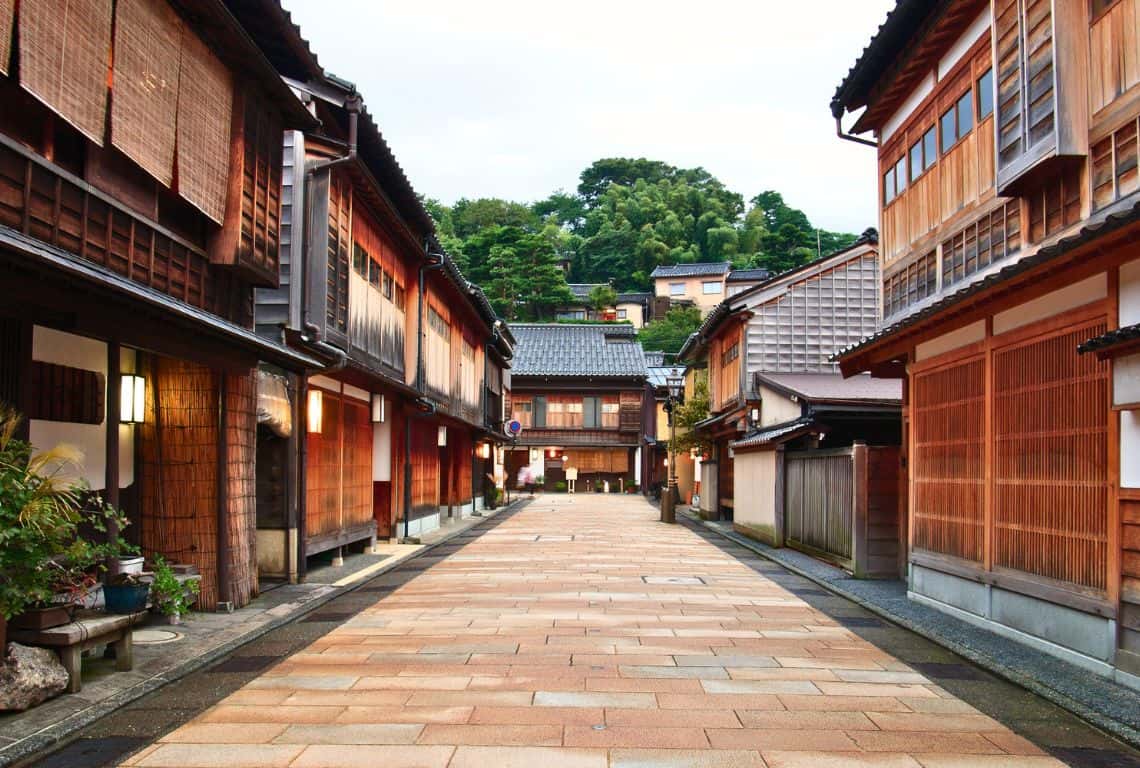
Higashi Chaya District in Kanazawa / 16-Day Japan Itinerary
Here are some things you simply cannot miss in Kanazawa:
- Kenrokuen Garden – This is one of the most famous gardens in Japan and is considered one of the top three most beautiful gardens in the country. It’s especially beautiful during the cherry blossom season in the spring and the autumn foliage season in the fall.
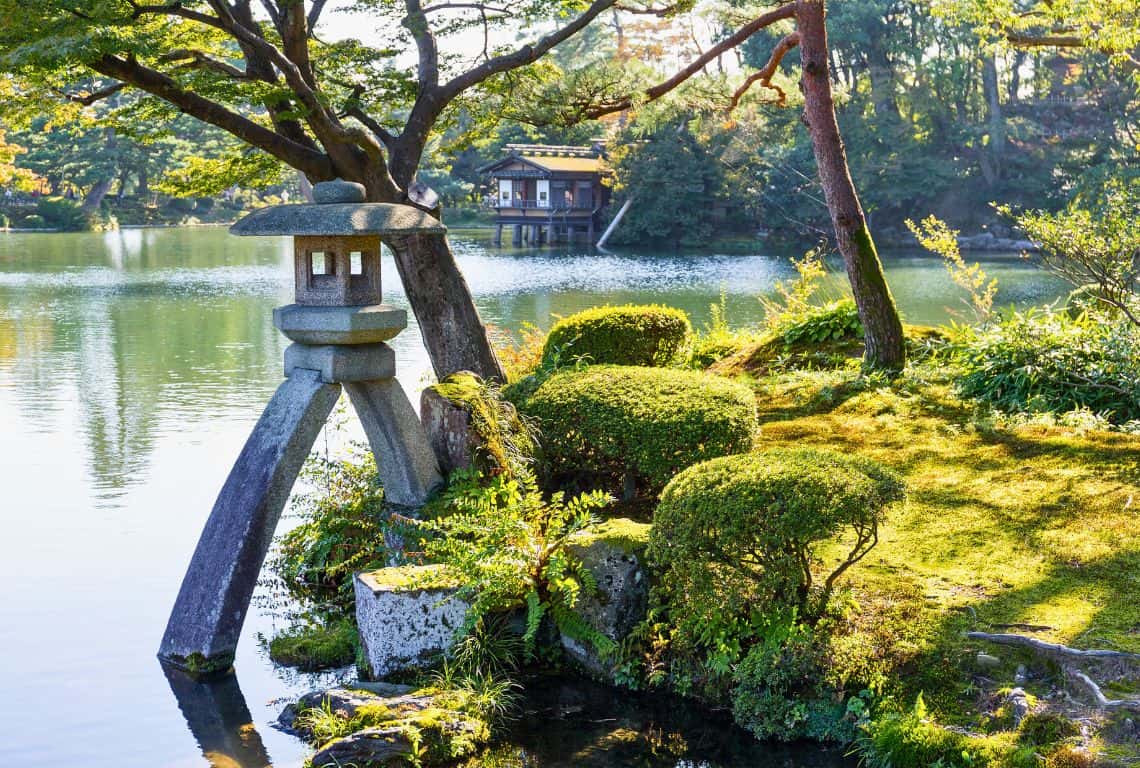
Kenrokuen Garden in Kanazawa / 16-Day Japan Itinerary
- Kanazawa Castle – This castle was originally built in the 16th century and has been reconstructed multiple times over the years. The castle grounds are open to the public and offer great views of the city.
- Higashi Chaya District – This is a historic geisha district in Kanazawa that has been well-preserved over the years. You can walk around and explore the old wooden buildings and shops that line the streets.
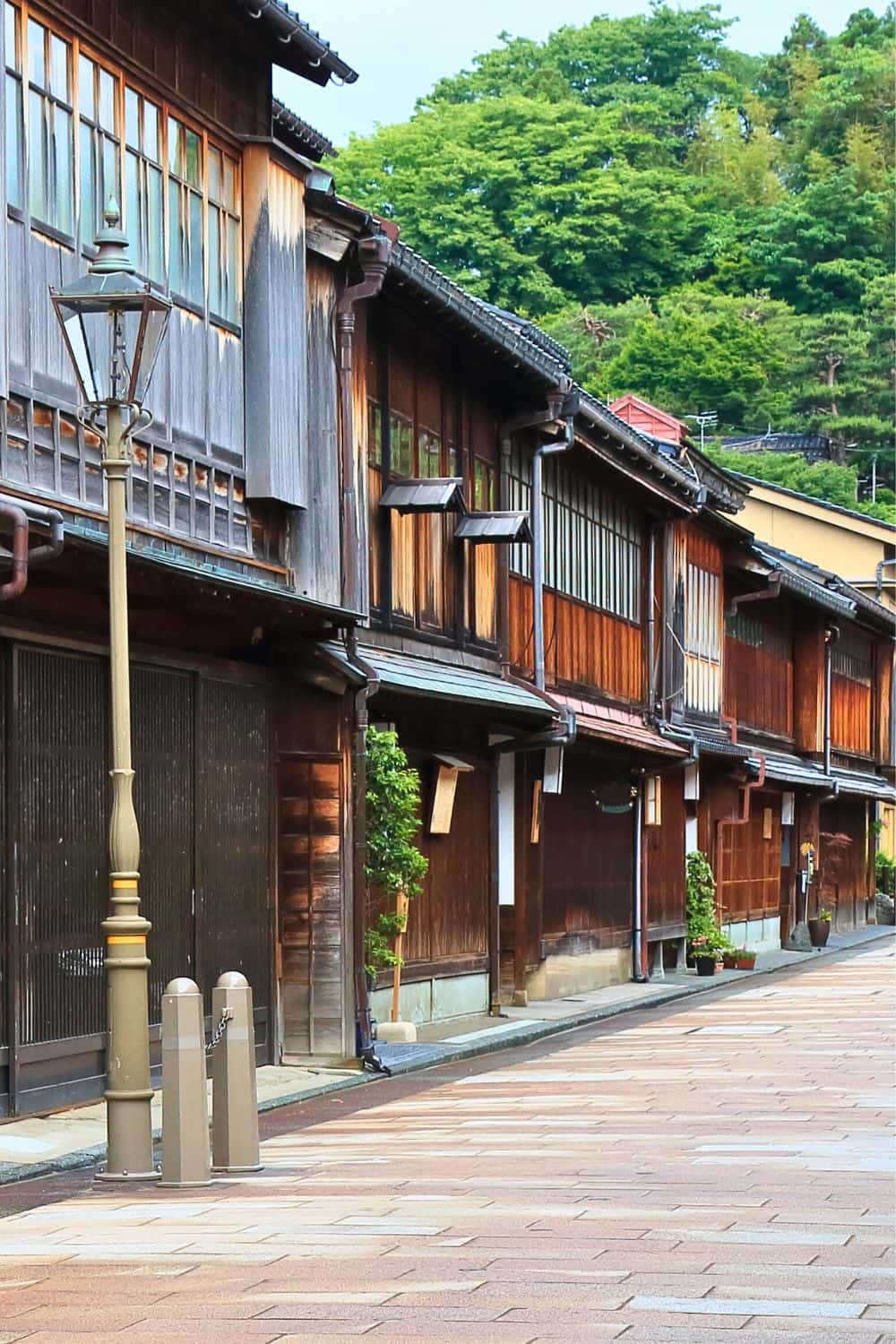
Higashi Chaya District in Kanazawa / 16-Day Japan Itinerary
- Omicho Market – This is a bustling market that has been around since the Edo period. You can find all sorts of fresh seafood, vegetables, and local specialties here.
- Nagamachi Samurai District – This is another historic district in Kanazawa that was home to samurai families during the Edo period. You can visit the old samurai houses and learn about their way of life.
DAY 11 - JAPANESE TEA CEREMONY AND TRIP TO NARA
- Japanese Tea Ceremony in Kyoto
- Day Trip to Nara from Kyoto
Japanese Tea Ceremony in Kyoto
Today, you will start with the Traditional Japanese Tea Ceremony.
The tea ceremony is an essential aspect of Japanese culture and participating in one can be a truly unforgettable experience that will give you an insight into Japanese customs and aesthetics.
Not only will you learn about the art of tea making, but you’ll also gain an understanding of the importance of mindfulness, harmony, and respect in Japanese society.
Traditional Japanese Tea Ceremony
A Japanese tea ceremony, also known as a “chado” or “sado,” is a traditional cultural experience that dates back centuries. It is a ritualistic preparation and presentation of powdered green tea, called “matcha,” served in a serene and peaceful atmosphere.
During a tea ceremony, you are going to be expected to follow certain customs and behaviors to show respect to the host and the art of tea making.
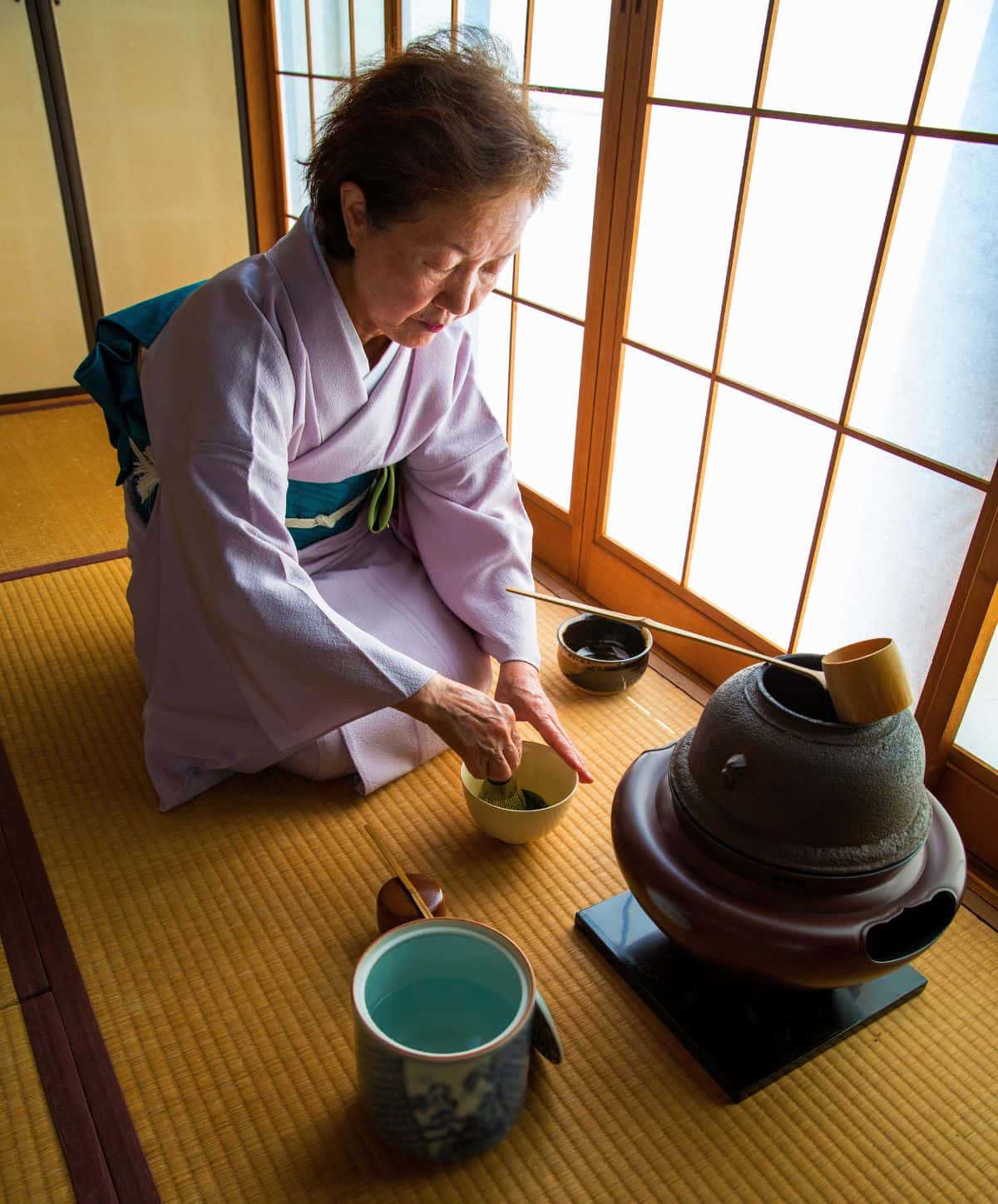
Traditional Japanese Tea Ceremony / 16-Day Japan Itinerary
I have attended several tea ceremonies lasting from 30-minute experiences to all-day events. To make it more manageable I collaborated and put together a list of steps involved in the process. Make sure to read it before attending a tea ceremony.
My recommendation is to attend Traditional Tea Ceremony wearing a Kimono in Kyoto by MAIKOYA. You will learn about Japanese history and sample matcha green tea, plus wearing a traditional kimono.
Afternoon Trip to Nara from Kyoto
I hoped you enjoyed the Japanese Tea Ceremony and are all energized for an afternoon trip to Nara.
Nara, the ancient capital of Japan, is located just a short 45-minute train ride from Kyoto. It is home to some of the country’s oldest and most significant temples and shrines.
In addition to its cultural and historical significance, Nara is also known for its stunning natural beauty, with sprawling parks and forests where you can encounter friendly deer roaming freely. And, the fun part is that you can buy some biscuits and feed them!
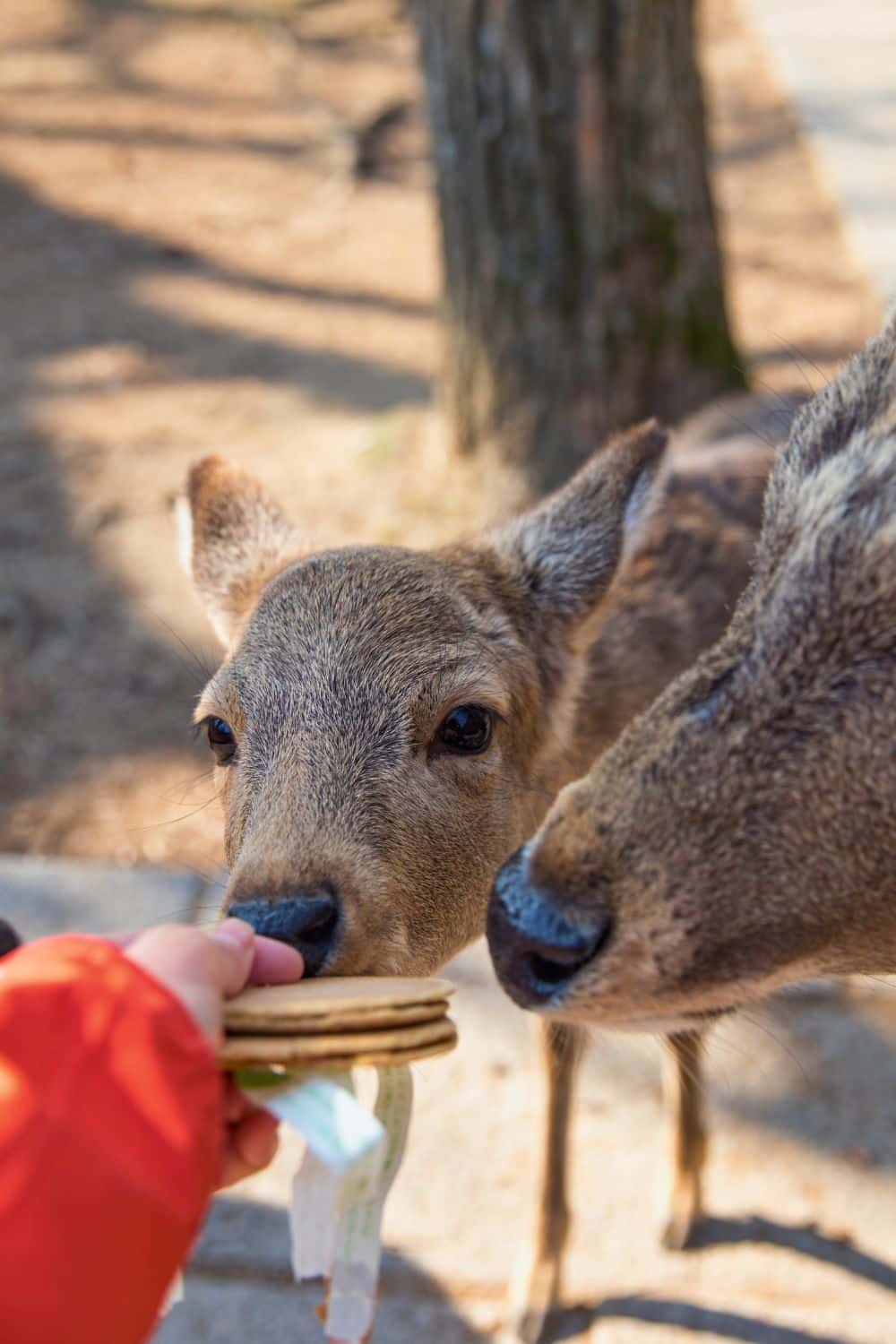
Friendly Deer in Nara / 16-Day Japan Itinerary
One of the main attractions in Nara is the Todai-ji temple, which houses the world’s largest bronze statue of Buddha.
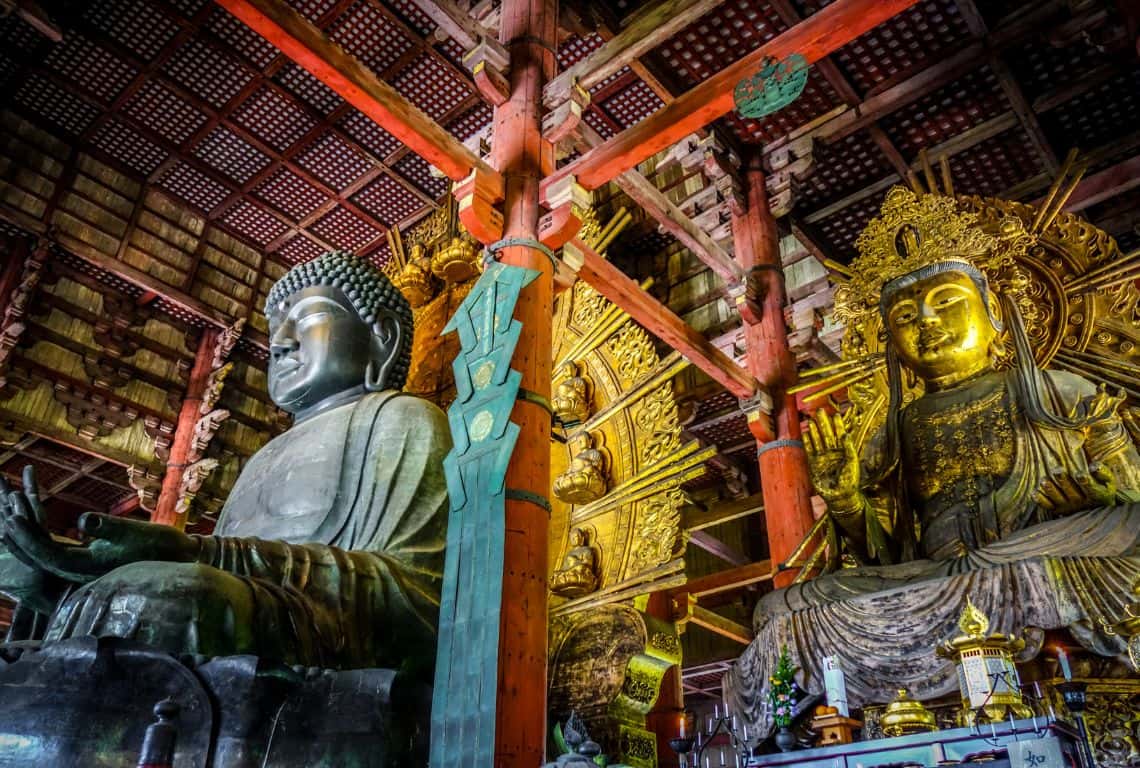
Inside the Todai-ji Temple in Nara / 16-Day Japan Itinerary
My favorite is the Kasuga-taisha shrine, with its many lanterns, and the Kofuku-ji temple, with its five-story pagoda. Make sure to read my post about 6 things that you should not miss in Nara, plus how to get there and navigate through the vast Nara Park.
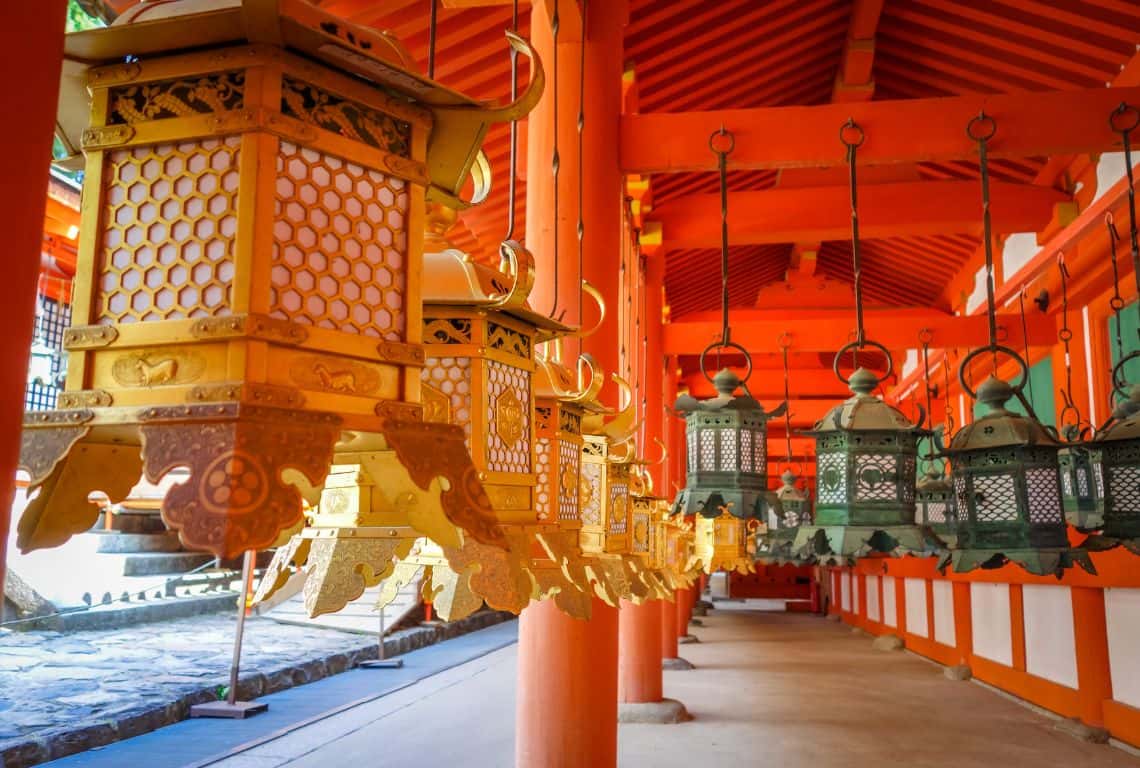
Kasuga-taisha Shrine in Nara / 16-Day Japan Itinerary
DAY 12 - DAY TRIP TO MIYAJIMA AND HIROSHIMA FROM KYOTO
- Day Trip to Miyajima Island and Hiroshima from Kyoto
Day Trip to Miyajima and Hiroshima from Kyoto
A day trip to Miyajima and Hiroshima from Kyoto is a perfect way to discover more of Japan’s history and culture. These two destinations offer a unique insight into the country’s past, with plenty of natural beauty and stunning sights to take in.
Miyajima is a small island located in Hiroshima Bay, famous for its picturesque views and the iconic Itsukushima Shrine. Another highlight of the island is the floating torii gate of the Itsukushima Shrine, which creates a stunning reflection on the water during high tide.
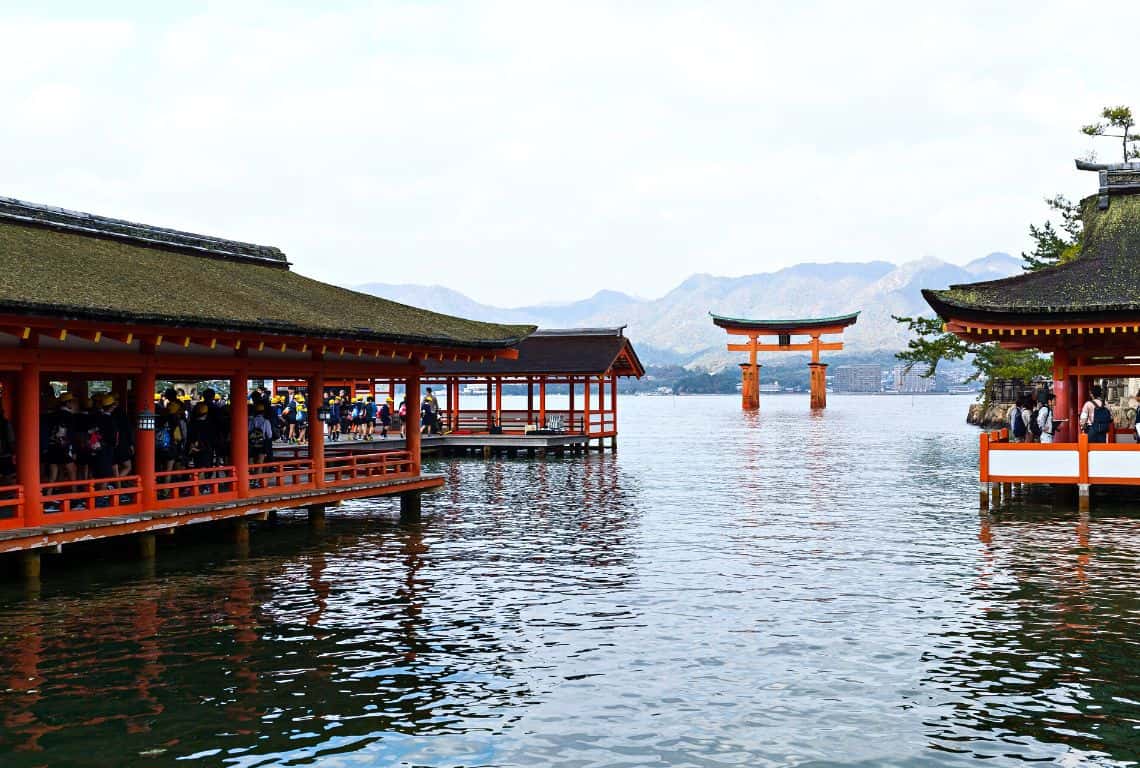
Floating Torii Gate on Miyajima Island / 16-Day Japan Itinerary
My favorite activity on Miyajima Island is to take a ropeway to Mount Misen, which is the highest point on the island and takes approximately 20 minutes to reach the top. Along the way, you can enjoy stunning views of the Seto Inland Sea and the surrounding islands.
Once at the top, you can explore the mountain’s hiking trails, take in panoramic views from the observation deck, and visit the ancient Buddhist temple, Daisho-in.
View of Seto Inland Sea from Mount Misen / 16-Day Japan Itinerary
Miyajima is known for its fresh oysters! You can try them grilled or fried at one of the island’s many food stalls or restaurants.
The oysters are harvested from the surrounding waters. They are known for their plumpness, sweetness, and creaminess, and are often paired with a glass of sake or local beer.
In fact, the island hosts an annual Oyster Festival in February, which attracts oyster lovers from around the country.
Hiroshima is a city known for its tragic history, resilience, and renewal. On August 6, 1945, the first atomic bomb was dropped on Hiroshima, instantly killing tens of thousands of people and causing widespread destruction.
Despite this devastation, the city has rebuilt itself into a vibrant metropolis that is now a symbol of peace and hope.
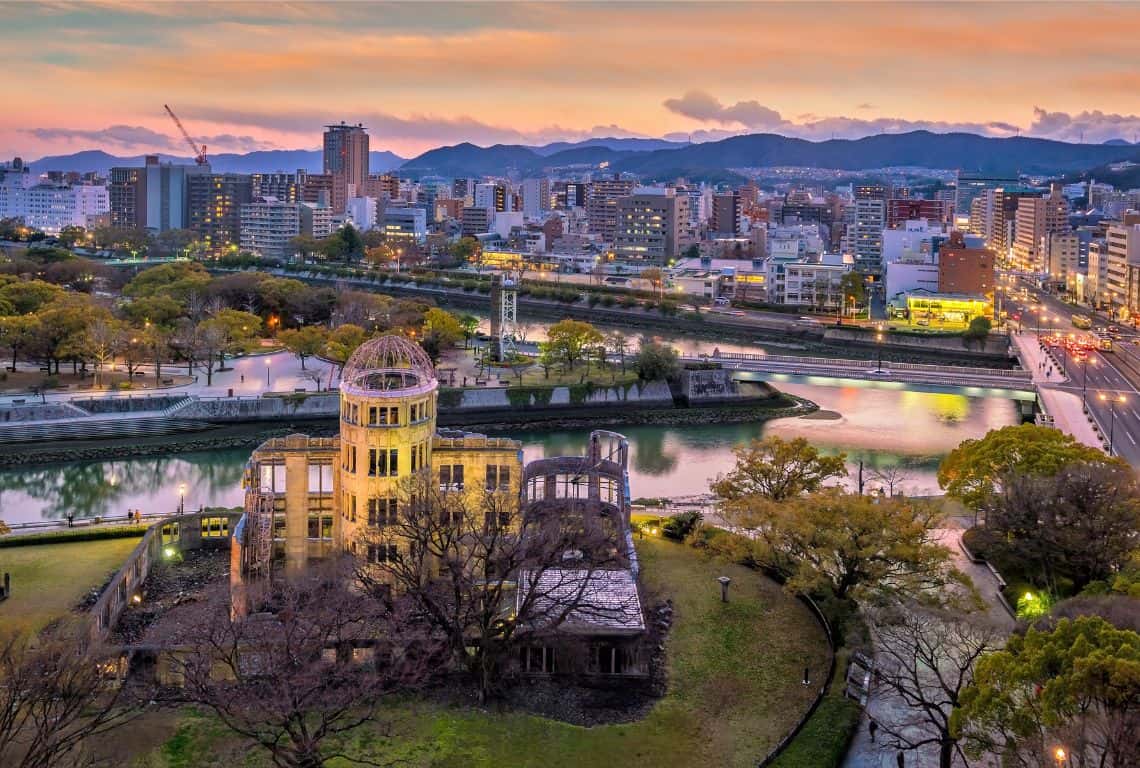
View of Atomic Bomb Dome in Hiroshima / 16-Day Japan Itinerary
You can pay your respects at the Peace Memorial Park and Museum which are powerful and poignant reminders of the atomic bombing that occurred in the city during World War II. The park and museum were built to honor the victims and promote peace around the world.
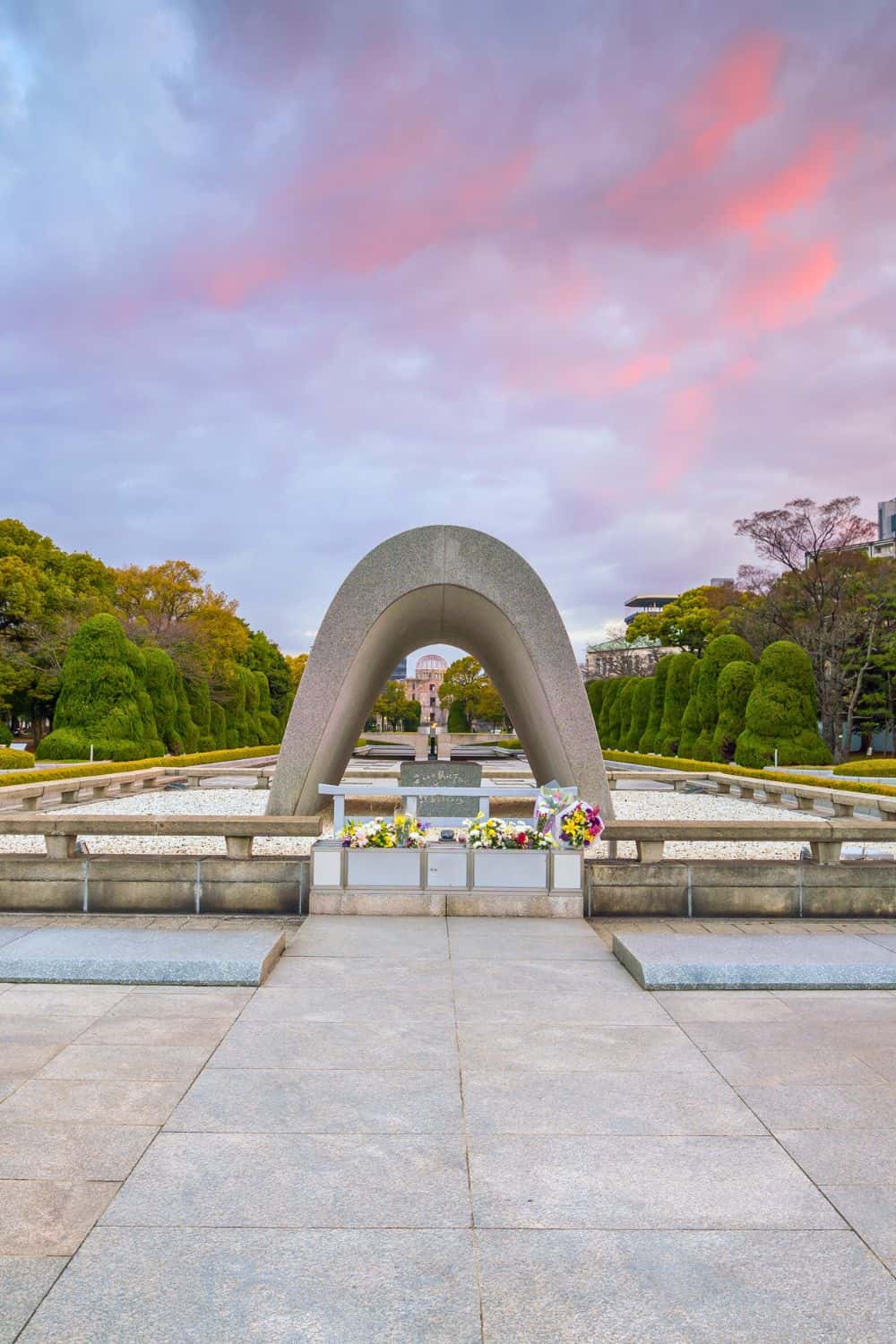
Hiroshima Peace Memorial Park / 16-Day Japan Itinerary
The museum houses exhibits that tell the story of the atomic bombing, including photographs, artifacts, and personal accounts of the survivors.
The park features several monuments and memorials, including the Atomic Bomb Dome, a building that was partially destroyed by the bombing and left standing as a testament to the horrors of the attack.
Visiting the Peace Memorial Park and Museum is a somber yet important experience for anyone interested in history and promoting peace.
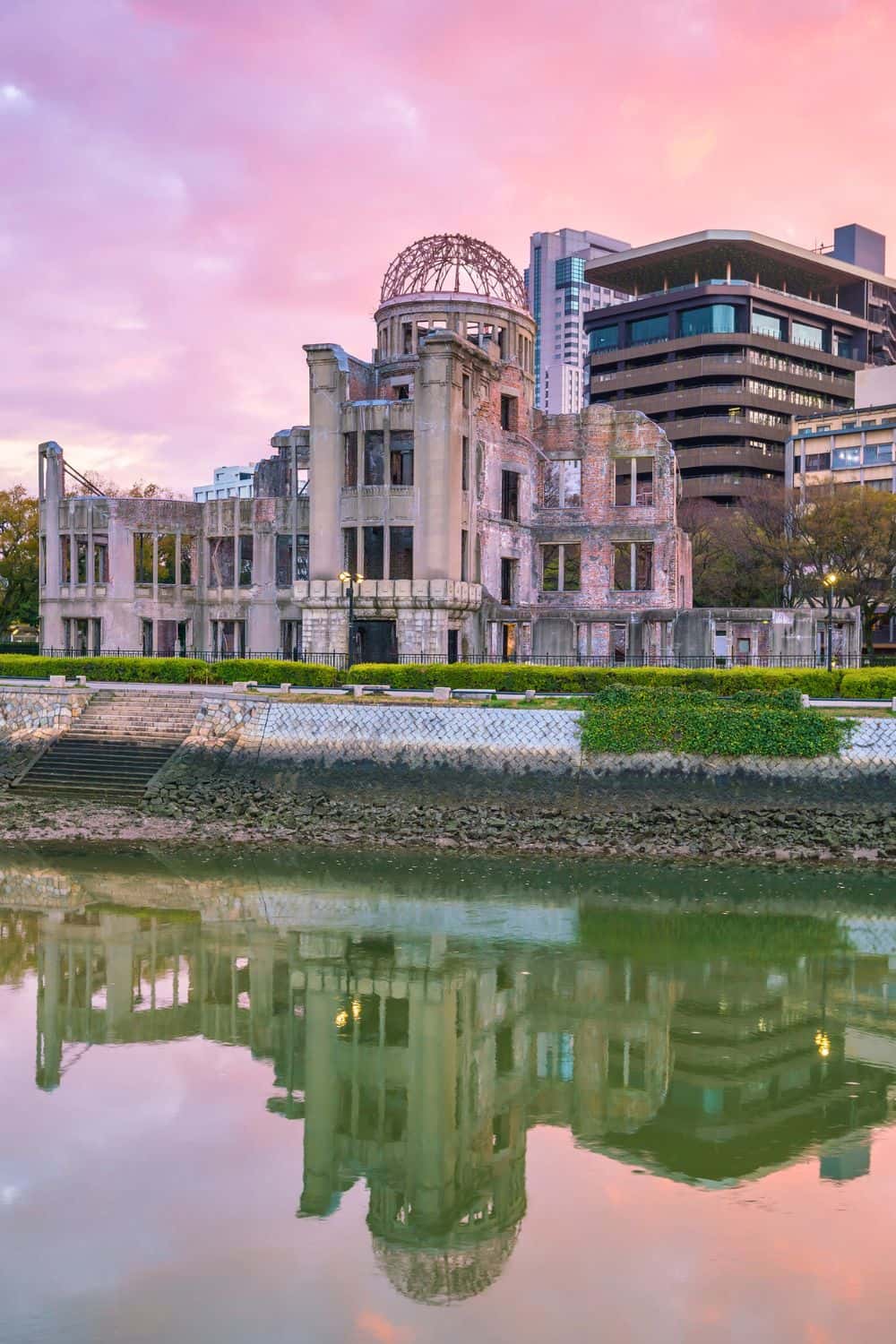
Atomic Bomb Dome in Hiroshima / 16-Day Japan Itinerary
DAY 13 - OSAKA
- Travel to Osaka and How to Get Around in Osaka
- Check-in and Settle into Your Accommodations in Oska (Best Places to Stay)
- Explore Osaka
1. Visit Osaka Castle
- Get a Good Night’s Rest
Travel to Osaka from Kyoto and How to Get Around in Osaka
Today You will travel to Osaka from Kyoto. and, it is super easy to do it!
If you are a JR Pass holder, then you can take the JR Kyoto Line to Osaka Station. The journey takes about 30 minutes and there are frequent trains throughout the day.
Alternatively, you can take the Shinkansen from Kyoto Station to Shin-Osaka Station, which is a bit faster and more comfortable, but requires a reservation and an additional fee.
From Shin-Osaka Station, you can transfer to the JR Osaka Loop Line or other local JR lines to get to your final destination in Osaka.
Here is how to get around in Osaka:
- Osaka Metro: The Osaka Metro is a subway system that connects various parts of the city. It is one of the easiest and most convenient ways to get around Osaka.
- JR West: JR West is a train network that connects Osaka to other major cities in Japan. It also provides access to the Osaka Loop Line, which circles around the city.
- Buses: Osaka has an extensive bus network that covers most areas of the city. Buses are a good option for short distances and for traveling to places that are not covered by the subway or train network.
- Taxis: Taxis are widely available in Osaka, but they are relatively expensive compared to other modes of transportation.
- Bicycle: Osaka is a bike-friendly city, and renting a bicycle is a great way to explore the city at a leisurely pace. There are many rental shops that offer bicycles for a reasonable price.
- Walking: Many of Osaka’s attractions are located within walking distance of each other, and walking is a great way to get a feel for the city and discover hidden gems along the way.
Settle Into Your Accommodations in Osaka (Best Places to Stay)
There are many great neighborhoods to stay in when visiting Osaka. Here are some popular options:
- Namba: This area is known for its vibrant nightlife, shopping, and dining options. It’s a great choice if you want to be in the heart of the action.
- Umeda: Located in the northern part of the city, Umeda is a major transportation hub with easy access to both downtown Osaka and other cities in the Kansai region.
- Shinsaibashi: Another popular shopping and entertainment district, Shinsaibashi is located near Namba and is a great place to stay if you want to be close to the action but prefer a slightly quieter atmosphere.
- Shin-Osaka: If you’re arriving in Osaka by bullet train, Shin-Osaka is a convenient area to stay in. It’s also close to the Umeda area and has good transportation links to other parts of the city.
Here are some of the places that I stayed at and I think you might like them as well:
- Namba:
Swissotel Nankai Osaka: My top choice would be this luxurious hotel located in the heart of Namba with great views of the city. I loved it!
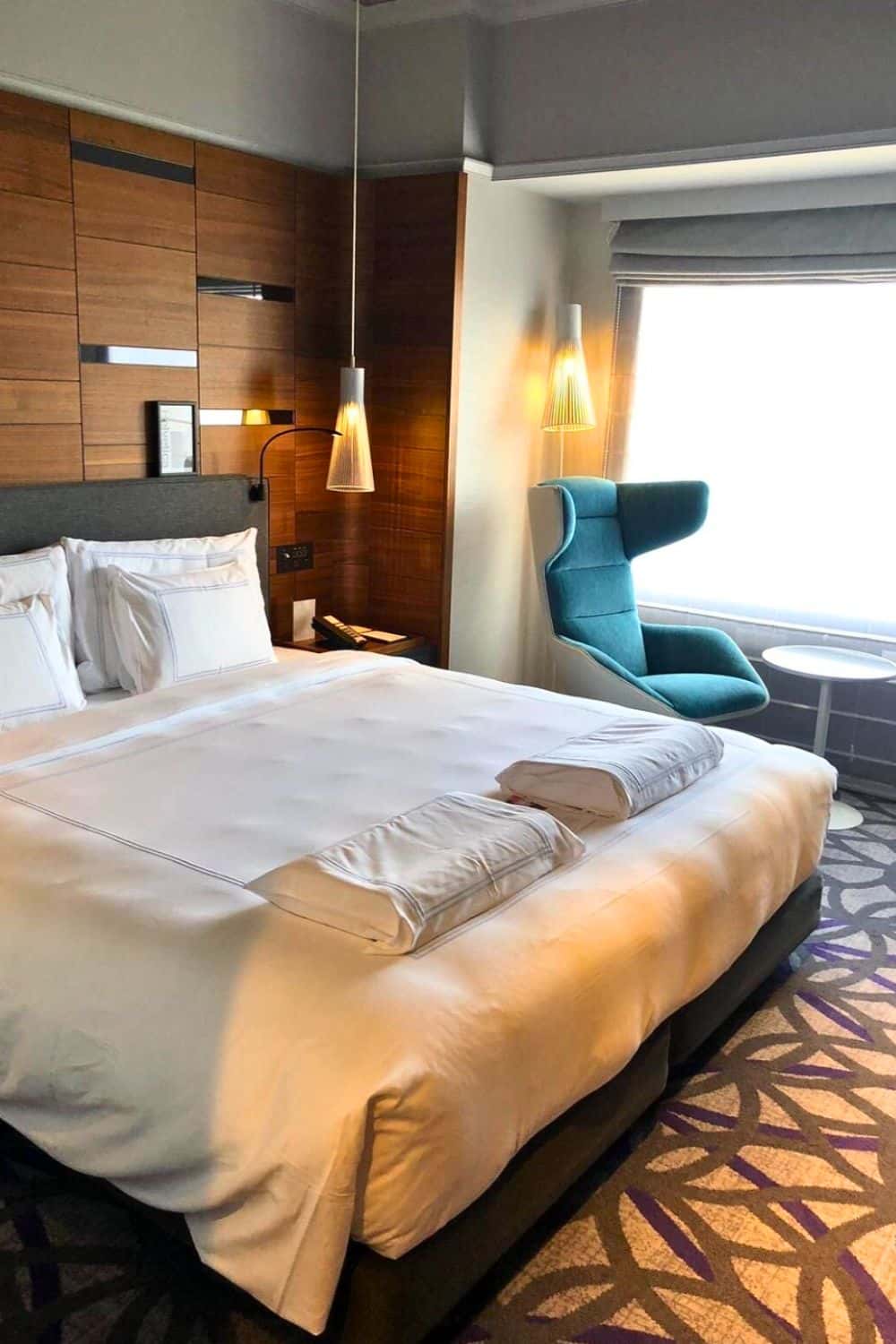
Swisshotel Nankai Osaka / 16-Day Japan Itinerary
- Umeda:
InterContinental Osaka: This is another one of my favorites! Just a beautiful hotel located in the heart of Umeda with stunning views of the city.
- Shin-Osaka:
Courtyard by Marriott Shin-Osaka Station: If you are on a budget, then Courtyard by Marriott is an excellent option. It is a modern hotel located right next to Shin-Osaka Station.
Tour Fascinating Osaka Castle
After you settle into your accommodations, it is time to start exploring Osaka! So, let’s get started with Osaka Castle. It is one of the most popular attractions in Osaka and a must-see for anyone visiting the city!
The castle, which was originally built in 1583, has been destroyed and rebuilt several times over the centuries, but the current structure was completed in 1931 and has been meticulously restored to its former glory.
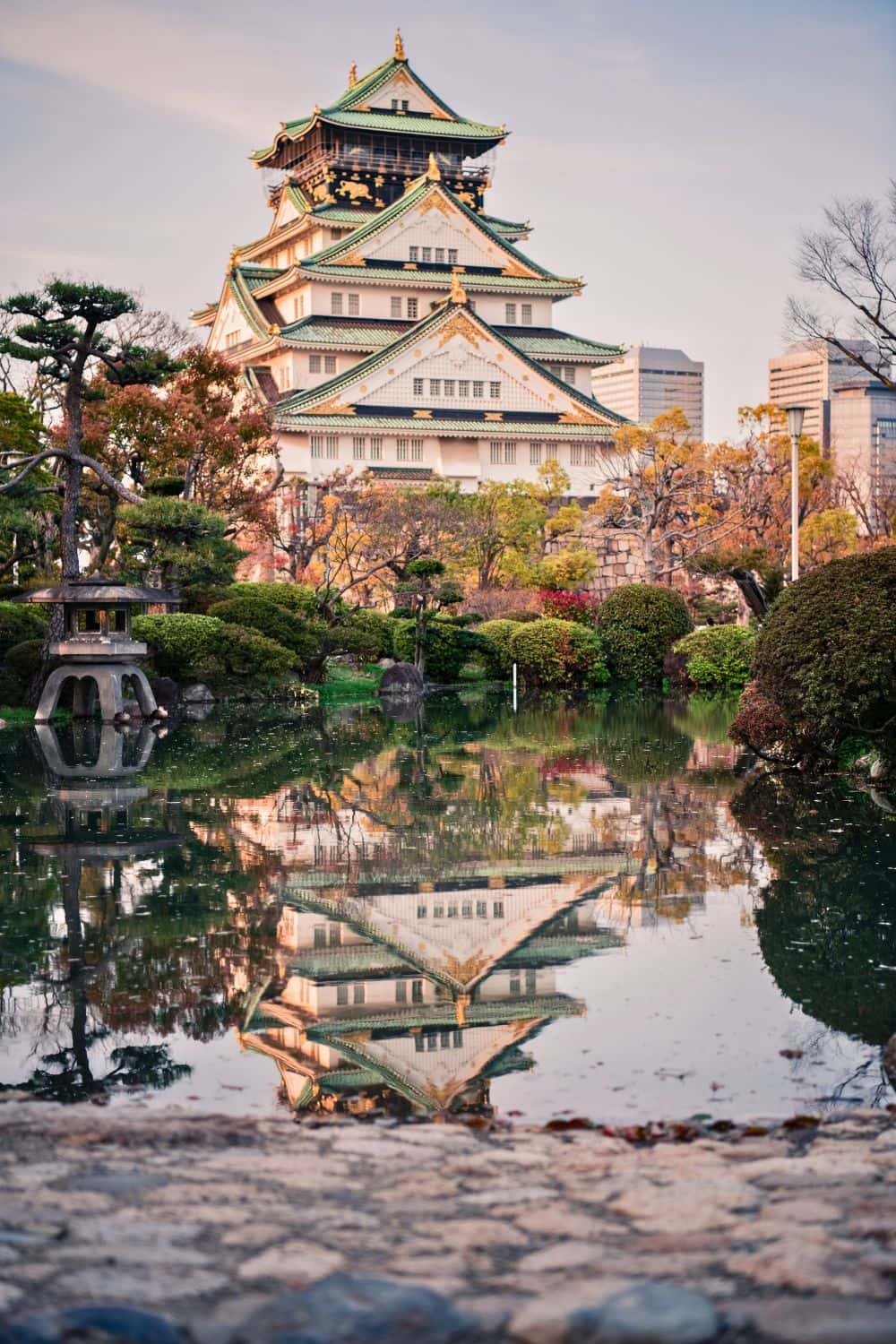
Osaka Castle / 16-Day Japan Itinerary
Here is what not to miss at Osaka Castle:
- You can explore the castle’s interior, which houses a museum with exhibits on the castle’s history and the samurai culture of the time. The museum features a number of artifacts, including samurai swords, armor, and other weapons, as well as historical documents and artwork.
- The castle grounds are also a popular spot for cherry blossom viewing in the spring, with over 3000 cherry trees surrounding the castle. The grounds also feature several other attractions, including the Nishinomaru Garden, which offers stunning views of the castle and its surroundings, and the Hokoku Shrine, which honors Toyotomi Hideyoshi, the warlord who originally commissioned the castle.
- One of the most popular activities at Osaka Castle is climbing to the top of the castle’s main tower, which offers breathtaking views of the city from its observation deck.
- Located on the castle grounds is Plum Garden, which is absolutely spectacular spot to admire the beautiful plum blossom trees.
- Do not miss Otemon Gate! This is the main gate of the castle, and it has been designated as an important cultural property of Japan. It is a great spot for taking photos and experiencing the grandeur of the castle.
DAY 14 - OSAKA
- Explore Osaka
1. Kuromon Market
2. Shinsekai District
3. Dotonbori and Shinsaibashi
Sample the Best of Kuromon Market's Fresh and Flavorful Japanese Cuisine
Osaka is known for its lively and exciting food scene. The city is often referred to as the “Kitchen of Japan” due to its diverse and delicious cuisine.
Osaka is particularly famous for its street food, with many vendors selling delicious and affordable snacks like takoyaki (octopus balls), okonomiyaki (a savory pancake), and kushikatsu (deep-fried skewers).
Another unique aspect of Osaka’s food culture is its emphasis on “kuidaore,” which roughly translates to “eat until you drop.” This concept reflects the city’s love for good food and the belief that one should enjoy life to the fullest. Many restaurants in Osaka offer all-you-can-eat or all-you-can-drink options, allowing diners to indulge in as much delicious food and drink as they desire.
Osaka is truly a food lover’s paradise!
The best place to sample some of the freshest and most flavourful dishes is at Kuromon Market.
Kuromon Market in Osaka
Kuromon Market, also known as “Gastronome,” is a vibrant and bustling marketplace located in the heart of Osaka.
Kuromon Market has a long history, dating back to the Edo Period when it was primarily a seafood market. Today, the market has expanded to include a vast array of food vendors, selling everything from sushi and sashimi to street food and sweets.
One of the unique aspects of Kuromon Market is its emphasis on freshness and quality. Many of the vendors source their products directly from local farms and fisheries, ensuring that their offerings are of the highest quality. This commitment to quality has earned Kuromon Market a reputation as one of the best places to sample Japanese cuisine.
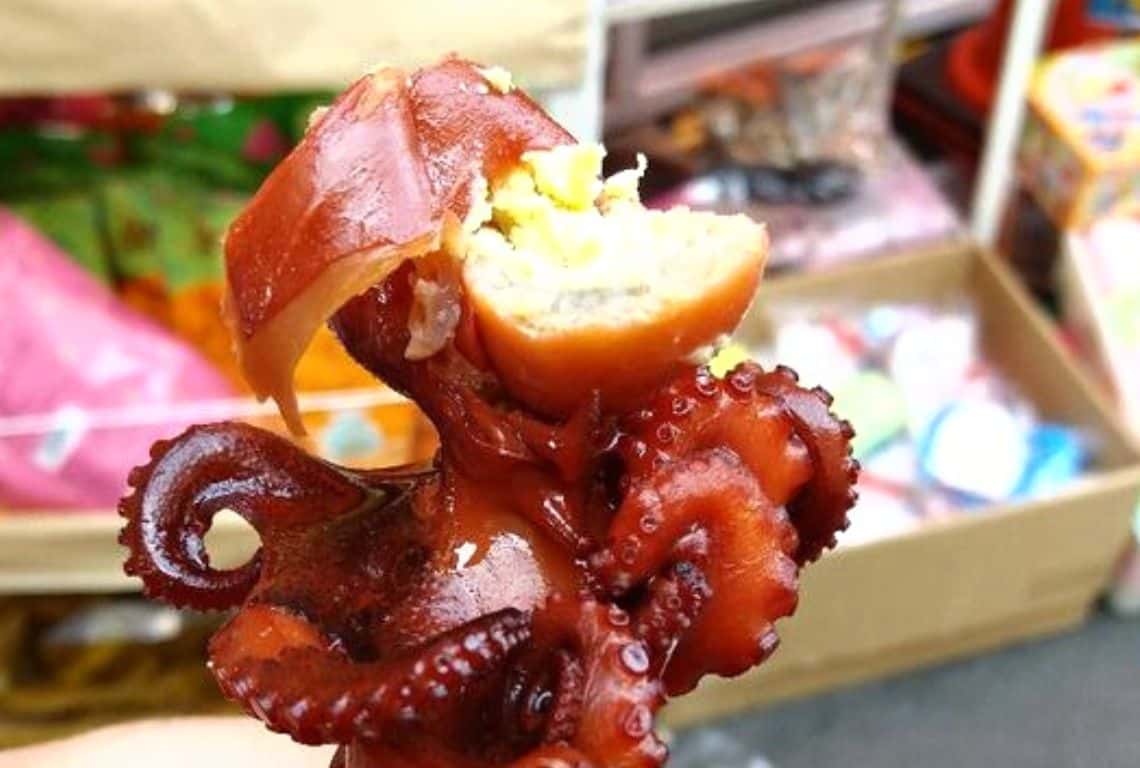
One of the Many Delicacies to Try at Kuromon Market in Osaka / 16-Day Japan Itinerary
Whether you’re a food lover or simply looking to experience the vibrant energy of Osaka, Kuromon Market is a must-visit destination. With its rich history and diverse culinary offerings, the market offers a unique and memorable experience!
Make sure to read my post: WHAT to EAT at Osaka KUROMON MARKET (10 Culinary Experiences You Can’t Miss)
Discover Shinsekai: A Neighborhood Like No Other in Osaka
Shinsekai, meaning “New World” in Japanese, is a lively and colorful neighborhood located in southern Osaka.
Developed in the early 20th century, Shinsekai was designed to be a showcase of the latest and greatest in urban development and technology at the time. Today, it has become a popular destination for tourists and locals alike, offering a unique blend of history, culture, and entertainment.
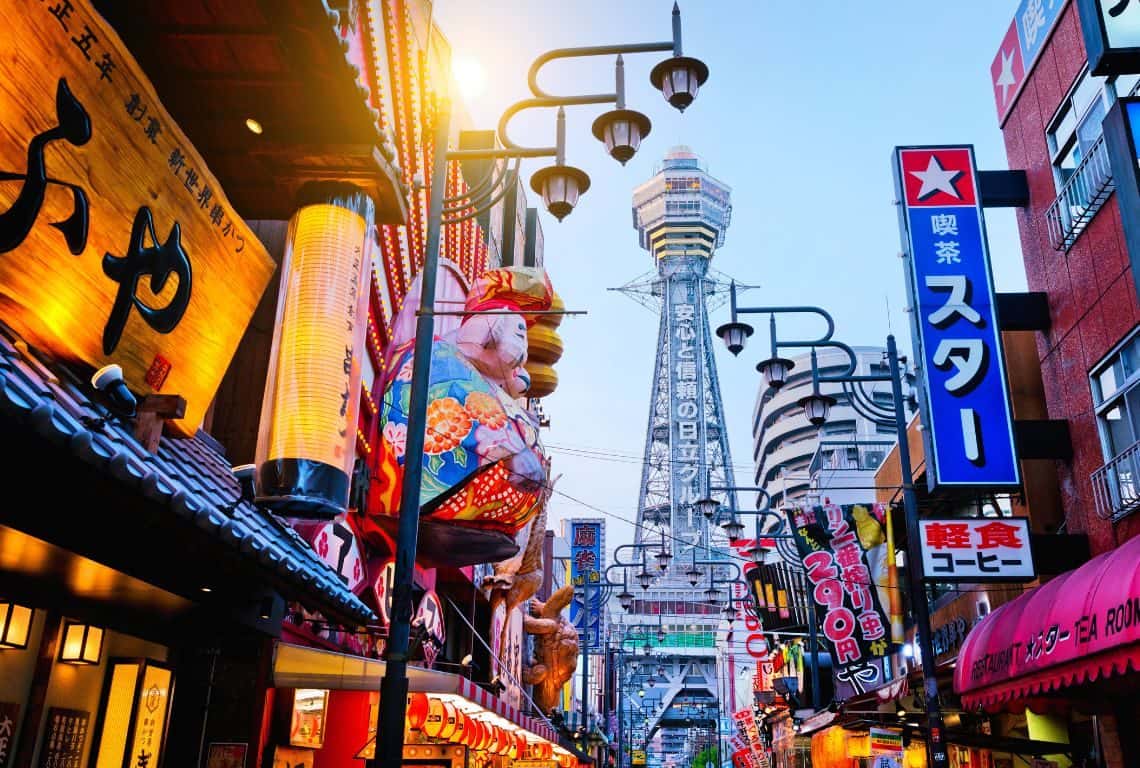
Shinsekai in Oskaka / 16-Day Japan Itinerary
Here are some of the things you can’t miss in Shinsekai:
- Tsutenkaku Tower: The iconic tower of Shinsekai is a must-visit attraction. Originally built in 1912 and reconstructed in 1956, it stands 103 meters tall and offers stunning views of the surrounding area.
- Kushikatsu: Shinsekai is famous for its kushikatsu, a type of deep-fried skewered food. There are many kushikatsu restaurants in the area, each with its own unique take on the dish.
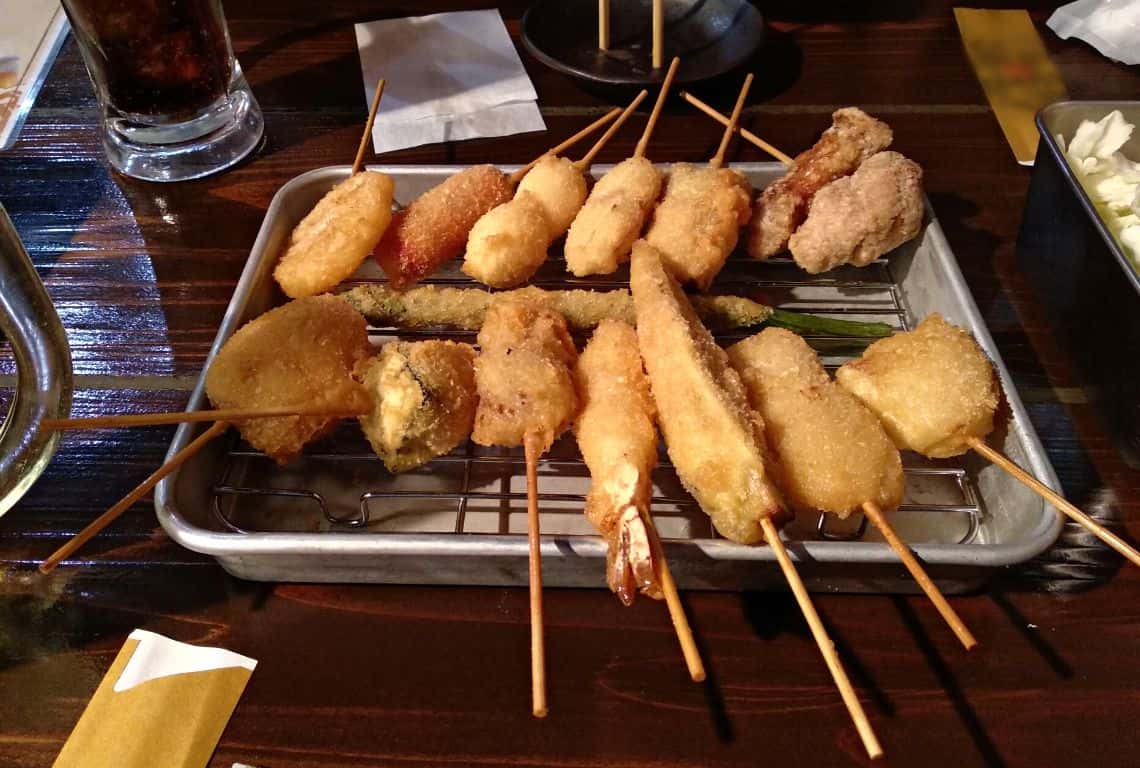
Kushikatsu in Shinsekai / 16-Day Japan Itinerary
- Janjan Yokocho: This narrow alley is packed with small bars and restaurants, each with its own unique atmosphere. It’s a great place to try some local food and drink and to get a taste of the local nightlife.
- Spa World: If you’re in need of some relaxation, head to Spa World, a large hot spring complex with a variety of baths and saunas.
Explore the Heart of Osaka: Dotonbori and Shinsaibashi
Located in the heart of Osaka’s bustling city center, Dotonbori is a popular destination. It is known for its vibrant nightlife, iconic neon signs, and delicious street food. The main street, Dotonbori Canal, is lined with restaurants, bars, and shops, and is a great place to take a stroll and experience the energy of the city.
Here are a few things not to miss in Dotonbori:
- Try Osaka’s signature street food, including takoyaki (octopus balls), okonomiyaki (savory pancake), and kushikatsu (deep-fried skewers).
- Take a photo with the iconic Glico Running Man sign or the Kani Doraku crab sign.
- Explore the bustling streets of the area, including Ebisu-Bashi Bridge and the Hozenji Temple alleyway.
- Take a river cruise down the Dotonbori Canal to see the city from a different perspective.
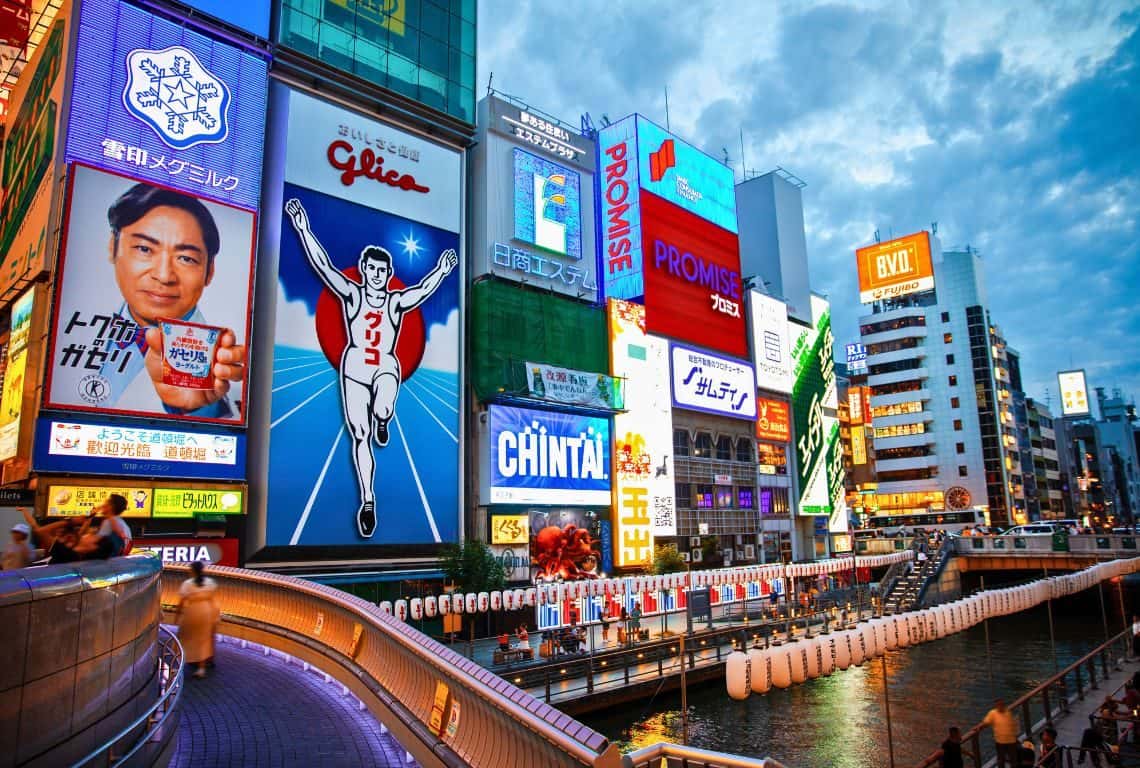
Dotonbori in Osaka / 16-Day Japan Itinerary
Shinsaibashi is a shopping district located in the heart of Osaka, known for its bustling streets, high-end fashion boutiques, and traditional shops.
Shinsaibashi is home to a variety of shops and restaurants, as well as entertainment options like theaters and music venues. Whether you’re looking for the latest fashion trends or traditional Japanese souvenirs, Shinsaibashi has something for everyone.
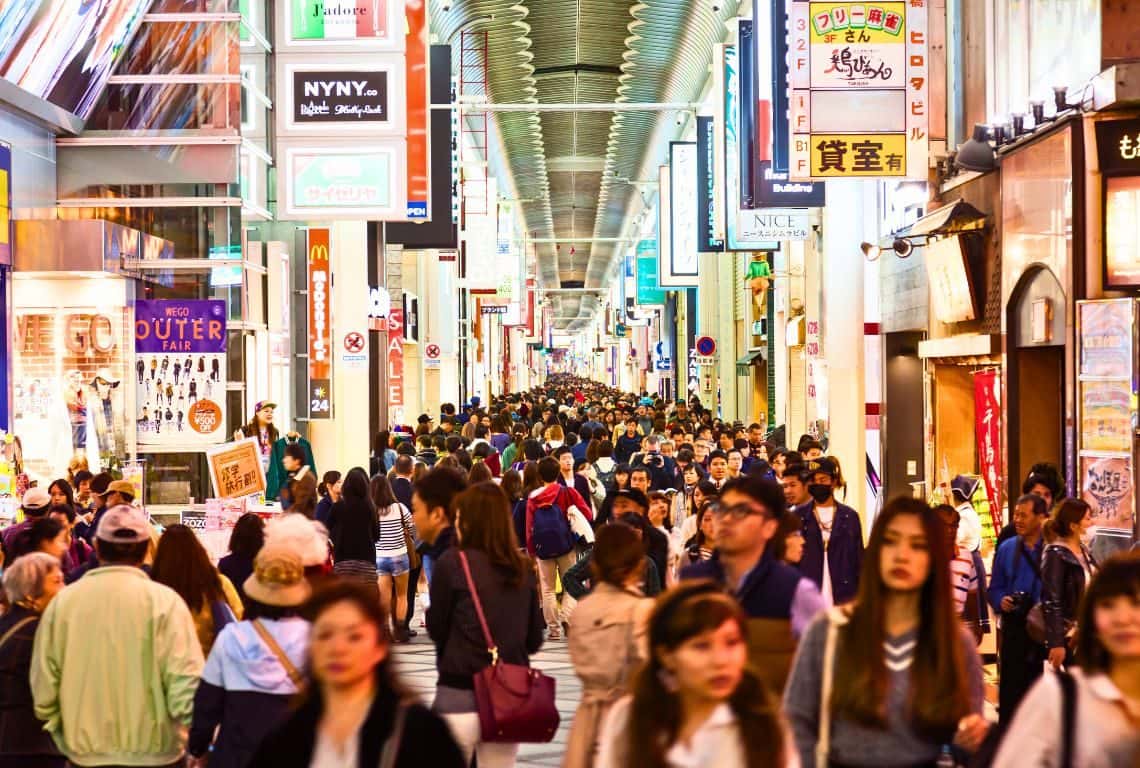
Shinsaibashi in Osaka / 16-Day Japan Itinerary
Here is what to do in Shinsabashi:
- Go shopping at one of the many department stores, such as Daimaru or Mitsukoshi.
- Explore the traditional Shinsaibashi-suji Shopping Street, which dates back to the Edo period and is lined with shops selling souvenirs, clothing, and more.
- Check out the latest fashion trends at the luxury shopping district, known as the Midosuji Line.
- Visit the Amerikamura area, which is known for its hipster and alternative fashion scene.
- Try some local cuisine at one of the many restaurants in the area, such as kushikatsu or okonomiyaki.
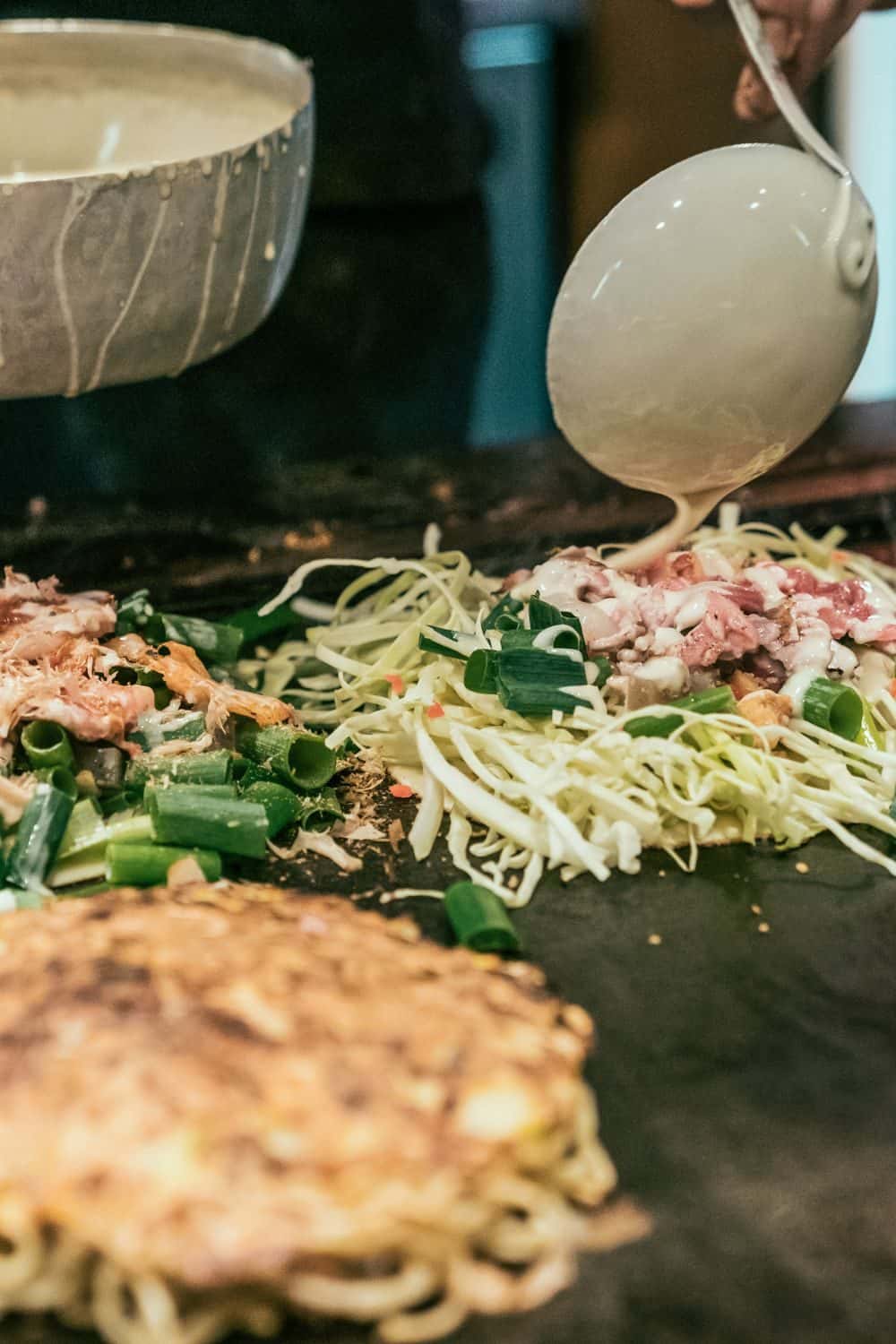
Okonomiyaki in Shinsaibashi / 16-Day Japan Itinerary
This concludes your tour of Osaka.
Tomorrow, you will embark on a fabulous day trip to explore the famous Himeji Castle!
DAY 15 - DAY TRIP TO HIMEJI CASTLE FROM OSAKA
Day Trip to Himeji Castle from Osaka
Explore Japan's Finest Castle: A Day Trip to Himeji Castle from Osaka
Himeji Castle, also known as the White Heron Castle due to its white exterior, is a UNESCO World Heritage Site located in Himeji.
It is widely regarded as the finest surviving example of Japanese castle architecture from the early modern period.
A trip to Himeji Castle is a must if you are visiting Japan.
Before we dive in, let’s cover how to get to Himeji Castle from Osaka. If you have a Japan Rail Pass, then here is how to do it:
- Take the JR Special Rapid Service or the JR Rapid Service train from Osaka Station to Himeji Station. Both trains are covered by the Japan Rail Pass.
- The journey takes around 1 hour by Special Rapid Service or 1 hour 20 minutes by Rapid Service.
- Once you arrive at Himeji Station, you can either take a bus or walk to the castle. The castle is about a 20-minute walk from the station.
- Alternatively, you can take a bus from Himeji Station to Himeji Castle. The bus ride takes around 10 minutes.
Himeji Castle is known for its complex system of defense and the intricate layout of its buildings.
It was built in the early 17th century by the order of the feudal lord, Ikeda Terumasa.
The castle was constructed using the latest architectural and defense techniques of the time, making it one of the most advanced castles in Japan. It has survived numerous wars and natural disasters, including earthquakes and fires, and is now open to the public for tours.
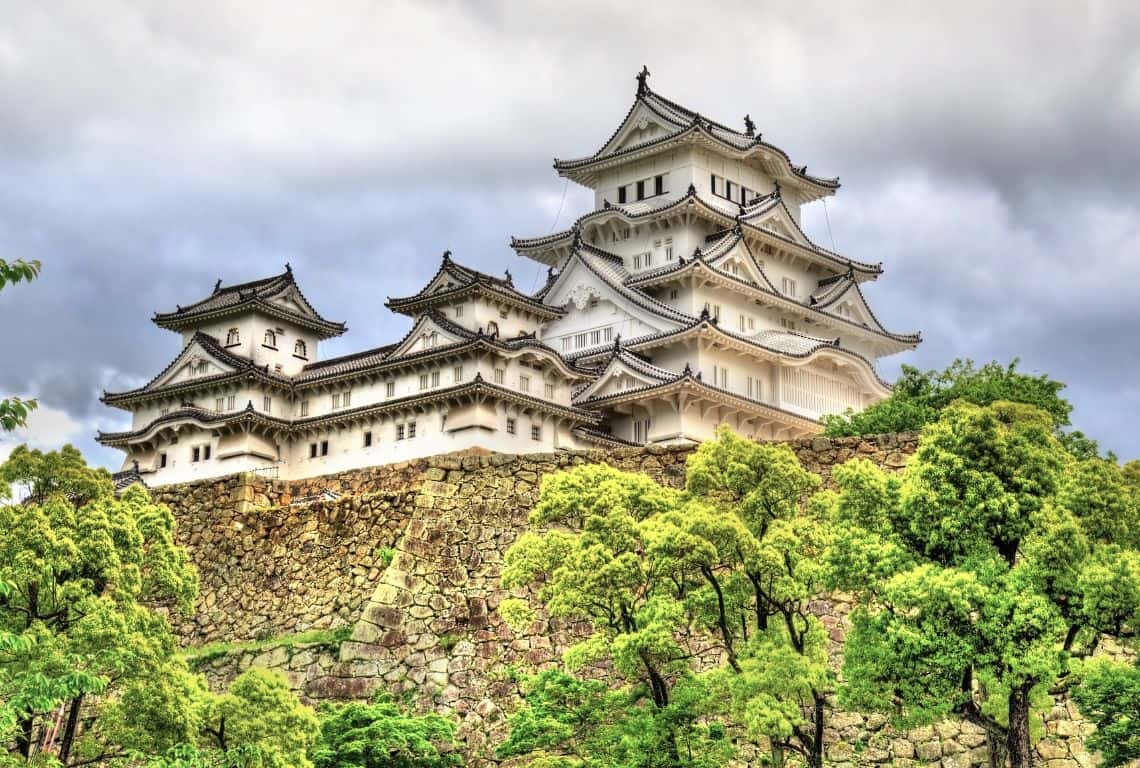
Himeji Castle / 16-Day Japan Itinerary
You can explore the castle’s many rooms, halls, and towers, and enjoy breathtaking views of the surrounding area from the castle’s top floor.
The castle grounds also include beautiful gardens and a nearby museum that houses historical artifacts related to the castle’s history.
Here are some things you should not miss at Himeji Castle and also a couple of ideas of what to do around Himeji Castle, or maybe even a short trip to Kobe:
- Explore Himeji Castle: The castle is a UNESCO World Heritage site and is famous for its white exterior and well-preserved interiors.
- Visit the Himeji Castle Museum: Located within the castle grounds, the museum has exhibits showcasing the history and culture of Himeji.
- Check out Kokoen Garden: Located next to the castle, this garden features nine different gardens representing different styles from the Edo period.
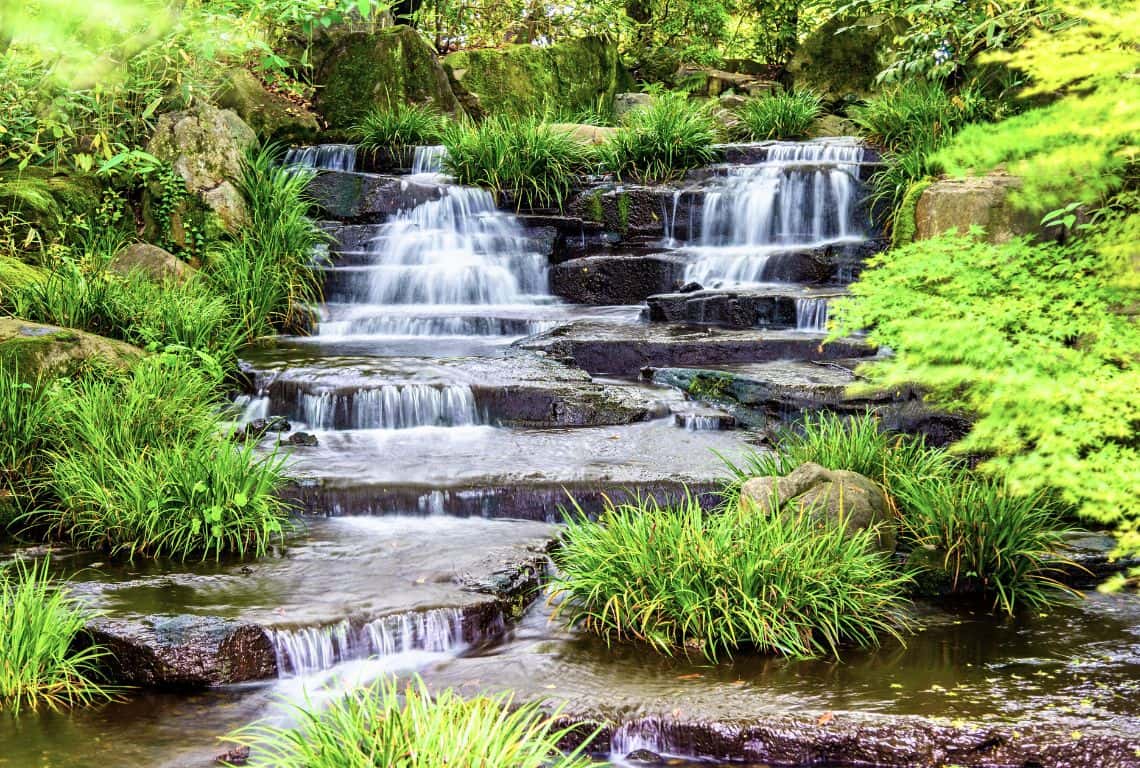
Kokoen Garden / 16-Day Japan Itinerary
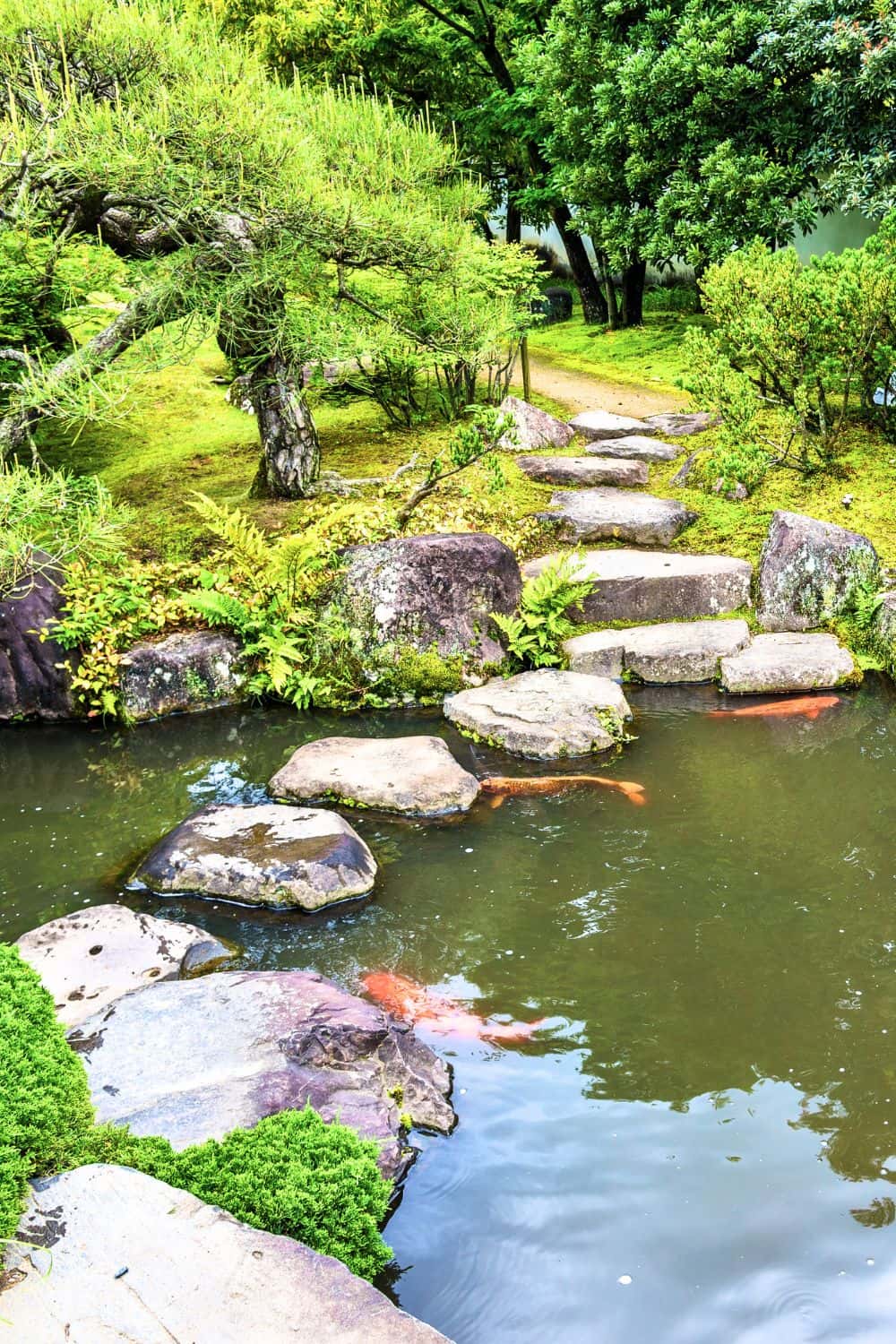
Himeji Castle / 16-Day Japan Itinerary
- Visit the nearby Engyoji Temple: This temple complex is located on Mt. Shosha and offers stunning views of the surrounding area.
- Take a walk through the nearby Otokoyama Haisuiike Park: This park is known for its beautiful seasonal flowers, ponds, and waterfalls.
- Explore the Himeji City Zoo: Located near the castle, the zoo is home to a variety of animals, including rare species of primates and big cats.
- Take a day trip to Kobe: Just a short train ride away, Kobe is a bustling port city known for its delicious beef, historic architecture and stunning views of the sea.
- Visit the Tegarayama Amusement Park: This park features roller coasters, water rides, and other attractions for thrill-seekers.
DAY 16 - DEPARTURE
Flight back home
Reflect on a Journey Through Japan: A Farewell Japan and a Flight Back Home
Here we are! This is the final day of your 16-day Japan itinerary.
I reserved this day for getting to the airport and embarking on your journey back home.
Saying goodbye to Japan has never been easy for me. It is usually a bittersweet feeling after experiencing all the country has to offer. With so much culture, food, and natural beauty, it is hard to leave without feeling like I have missed something.
So, here is my recommendation: as you make your way to the airport for your flight back home, take a moment to reflect on your trip and all the memories you have made. Maybe you will have one last meal of sushi or ramen, or buy some souvenirs to bring back with you. The journey back home may be long, but the memories of Japan will stay with you forever. As you board your plane, take a final look at the beautiful scenery and vibrant cityscapes, knowing that one day you will return to this wonderful country.
Remember, this is not goodbye but rather “see you later.” You can always come back to Japan to explore more of its wonders and create new memories. We hope you enjoyed your trip and have a safe and comfortable flight back home!
Intrepid Scout's Tips for 16-Day Japan Itinerary
- Plan your itinerary in advance: With only 16 days, it is important to plan your trip ahead of time to make the most of your time in Japan. Research the places you want to visit, check their opening hours, and make a rough itinerary to help you stay organized.
- Use a Japan Rail Pass: If you’re planning on traveling to different parts of Japan, consider purchasing a Japan Rail Pass. This will allow you to travel on most trains operated by Japan Railways, which can save you money in the long run.
- Book accommodation in advance: Japan is a popular tourist destination, and accommodation can book up quickly, especially during peak travel seasons. Book your accommodation well in advance to ensure you have a place to stay during your trip.
- Pack appropriately: Japan has four distinct seasons, so pack clothing suitable for the time of year you’re traveling. Check the weather forecast before you go and bring comfortable shoes as you will likely be doing a lot of walking.
- Learn basic Japanese phrases: While many Japanese people speak English, it is always a good idea to learn some basic Japanese phrases before your trip. This will make getting around and communicating with locals much easier.
- Respect local customs: Japan has a rich cultural heritage, and it’s important to respect local customs and etiquette. Be mindful of the rules and traditions when visiting temples, shrines, and other cultural sites.
- Try local food: Japanese cuisine is renowned around the world, so be sure to try as much local food as you can during your trip. From sushi and ramen to tempura and okonomiyaki, there’s something for everyone.
- Allow time for relaxation: Japan can be a busy and fast-paced country, so it’s important to allow time for relaxation during your trip. Take some time to unwind in a hot spring or go for a leisurely walk through a p
More Information About Japan:
14 Amazing Things to Do in Arashiyama (Map+Useful Tips)
What to See at Nijo Castle in Kyoto (10 Top Things to Know)
Stunning Golden Pavilion in Kyoto (How to Visit and What to See)
Amazing Fushimi Inari Taisha in Kyoto (8 Things to Know Before You Visit)
First Visit to Kyoto – How to Visit and What to See (11 Things You Can’t Miss)
Perfect Day Trip to Miyajima from Kyoto, Osaka, or Hiroshima
10 Amazing Things to Do in Hiroshima You Can’t Miss of Your Visit
Did You Find 16-Day Japan Itinerary Useful?
Why Not Save It to Your Pinterest Board!
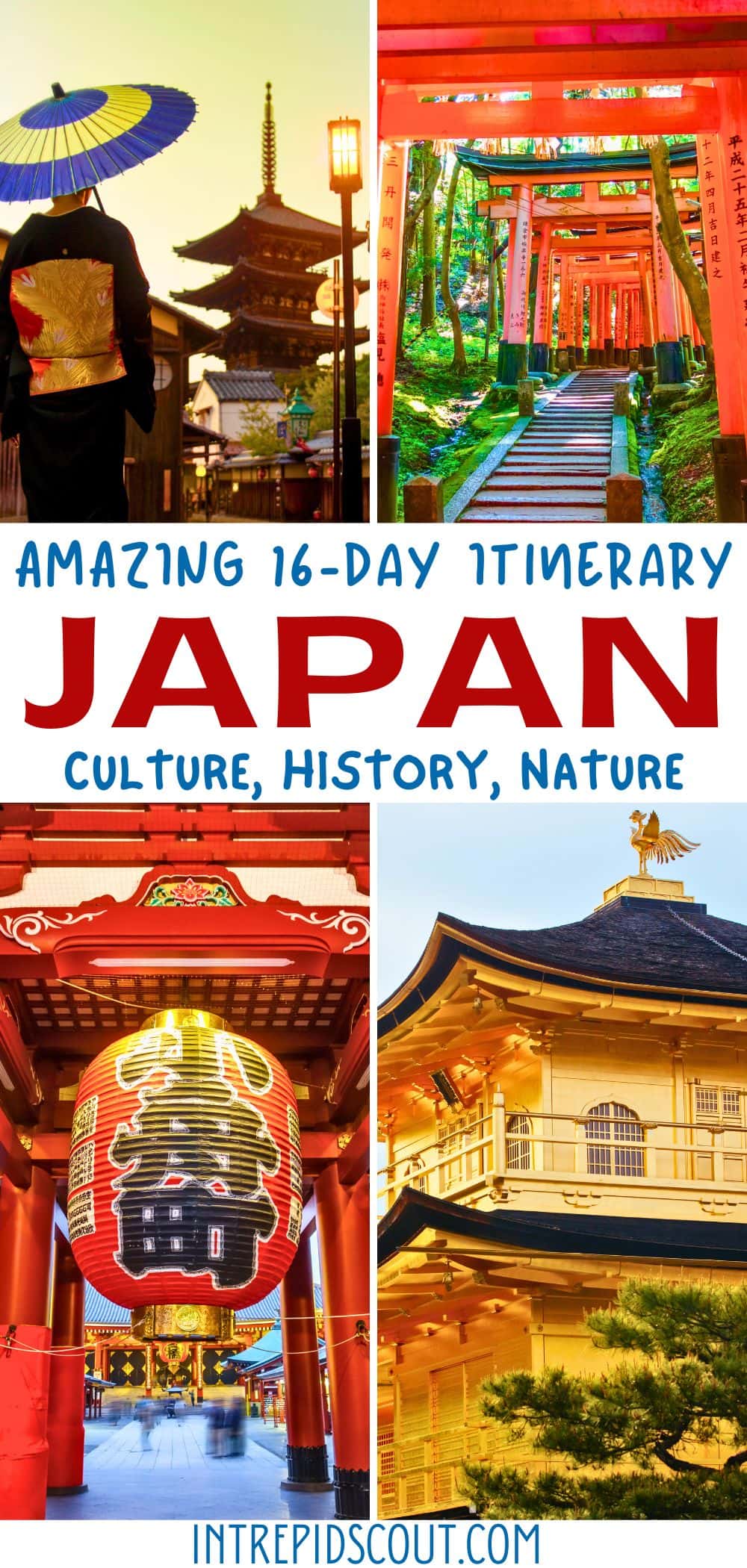
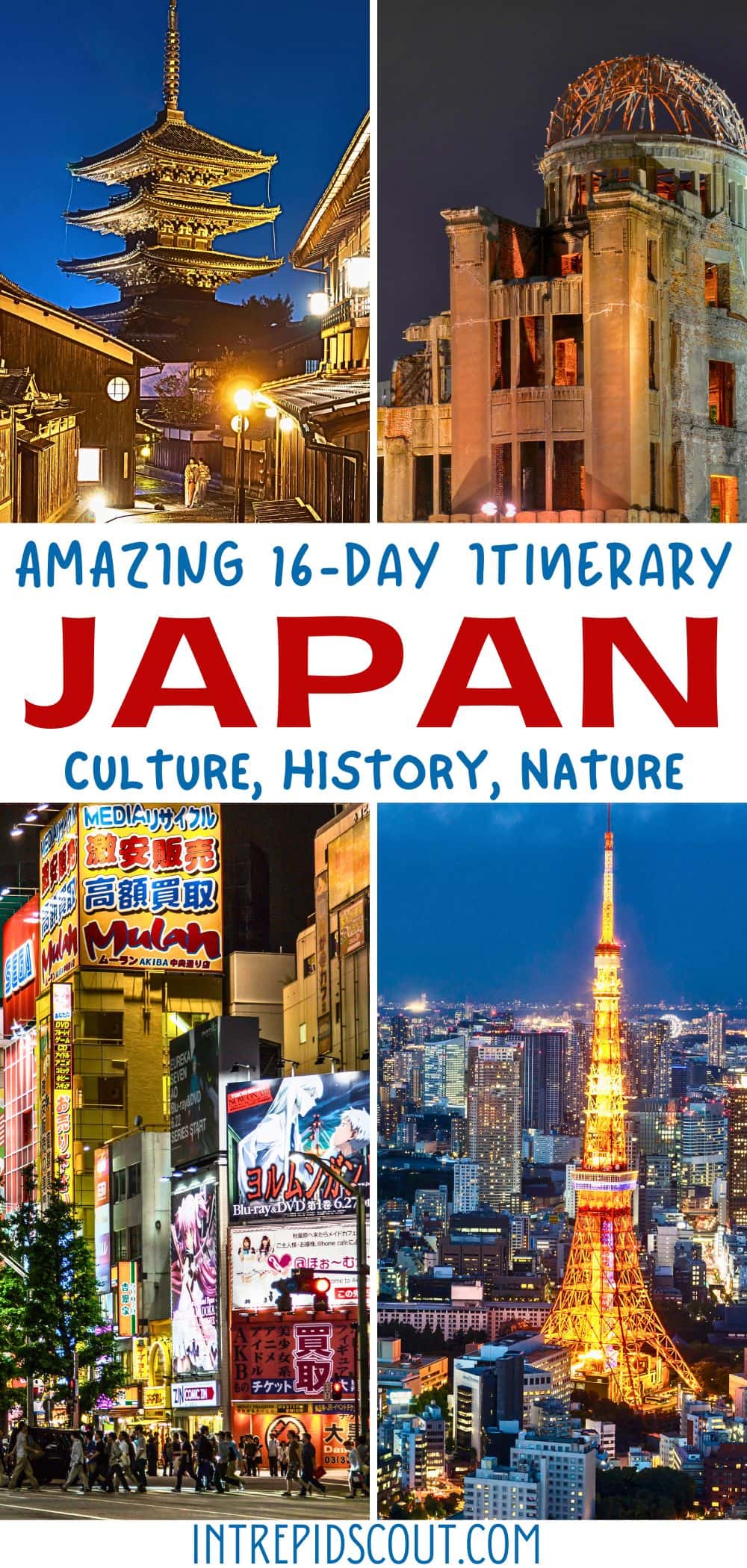
Now, It Is Your Turn, I Would Like to Hear Back from You!
Are you planning your trip to Japan?
Please let me know! Drop me a quick comment right below!
Click on any of the images below to get inspired and to help you with the planning process for your trip to Japan!
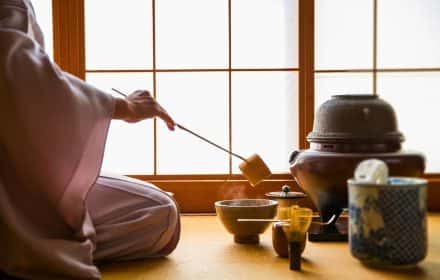
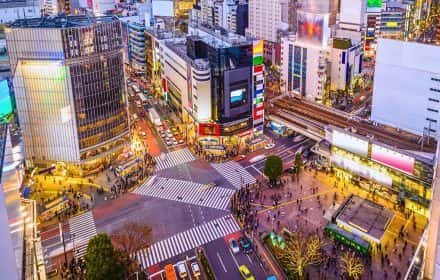
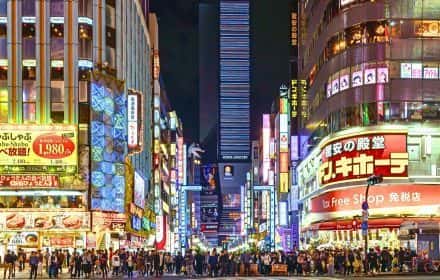
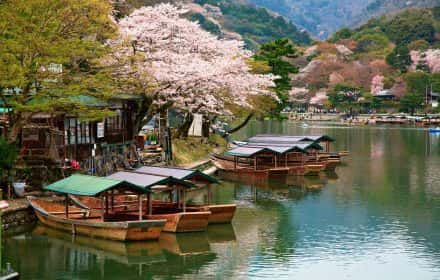
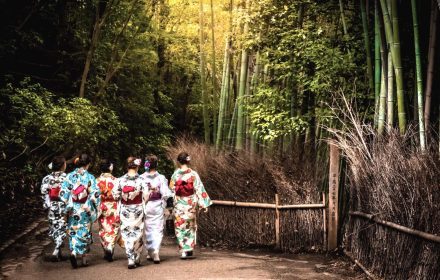
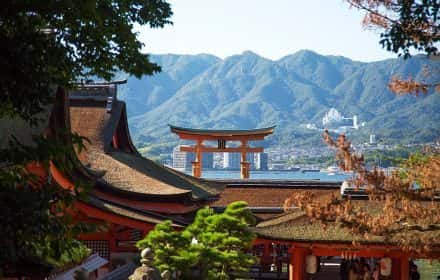
Comments:
2 thoughts on “Ultimate 16-DAY JAPAN ITINERARY for Marvelous Culture, History, and Nature”
I like the 16 day Japan itinerary. Can you provide more information on travel dates, costs etc etc…
Hello Ras,
Please reach out to a tour agency specializing in Japan. My blog post is based on my own itinerary and it worked great for me. You can use it as an example for your trip. Please let me know if I can help with anything.